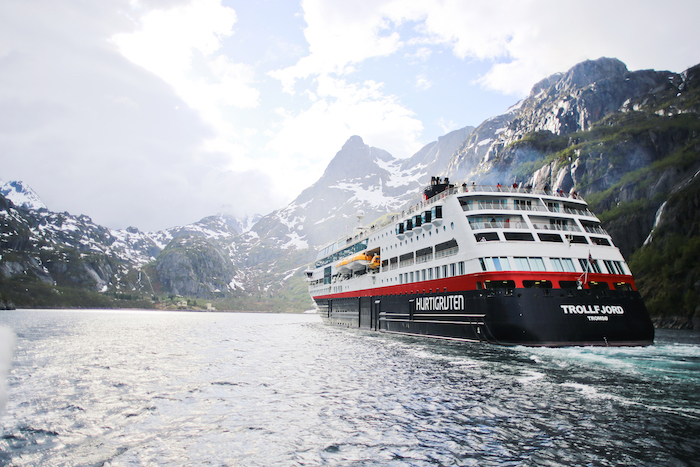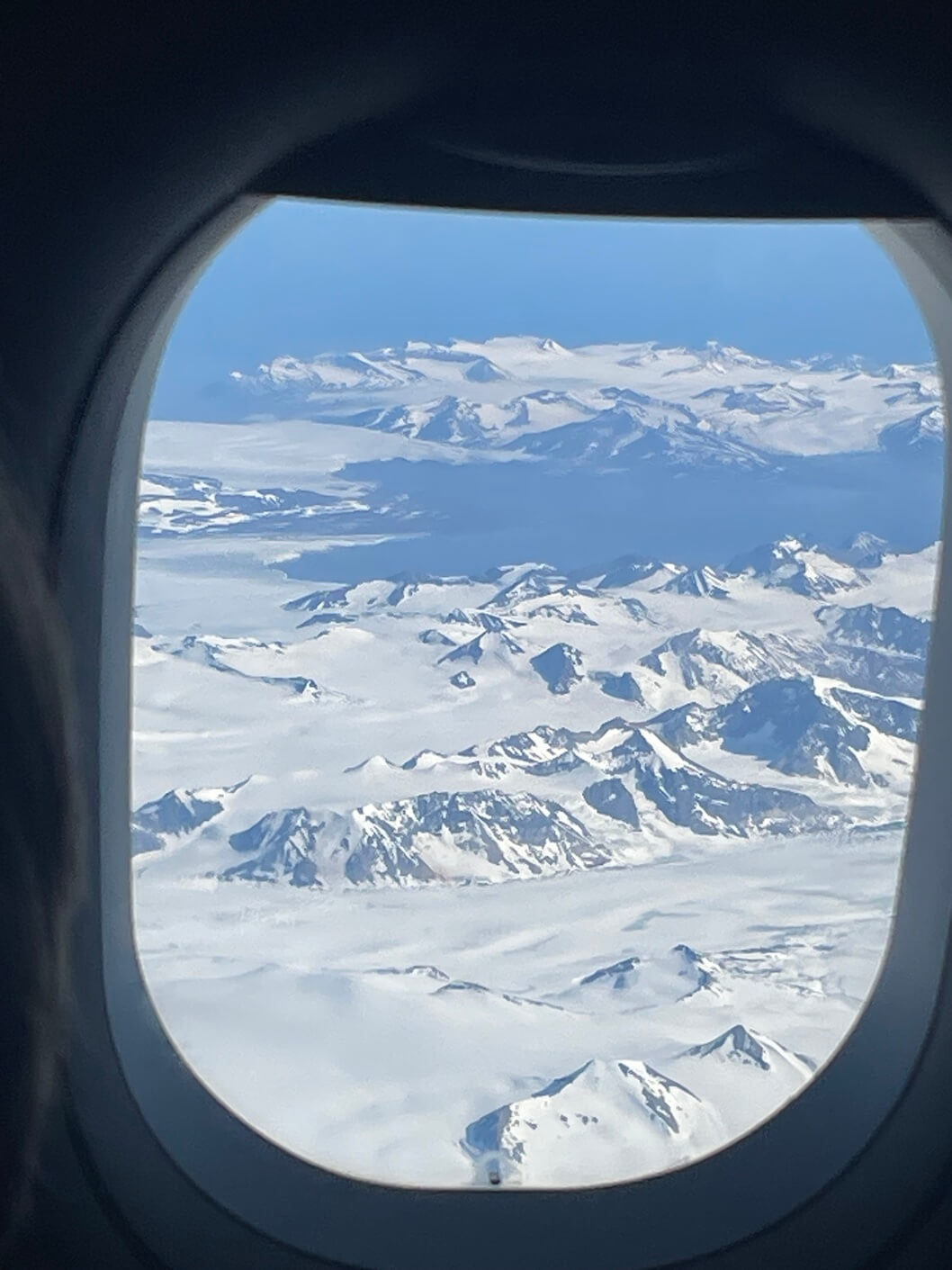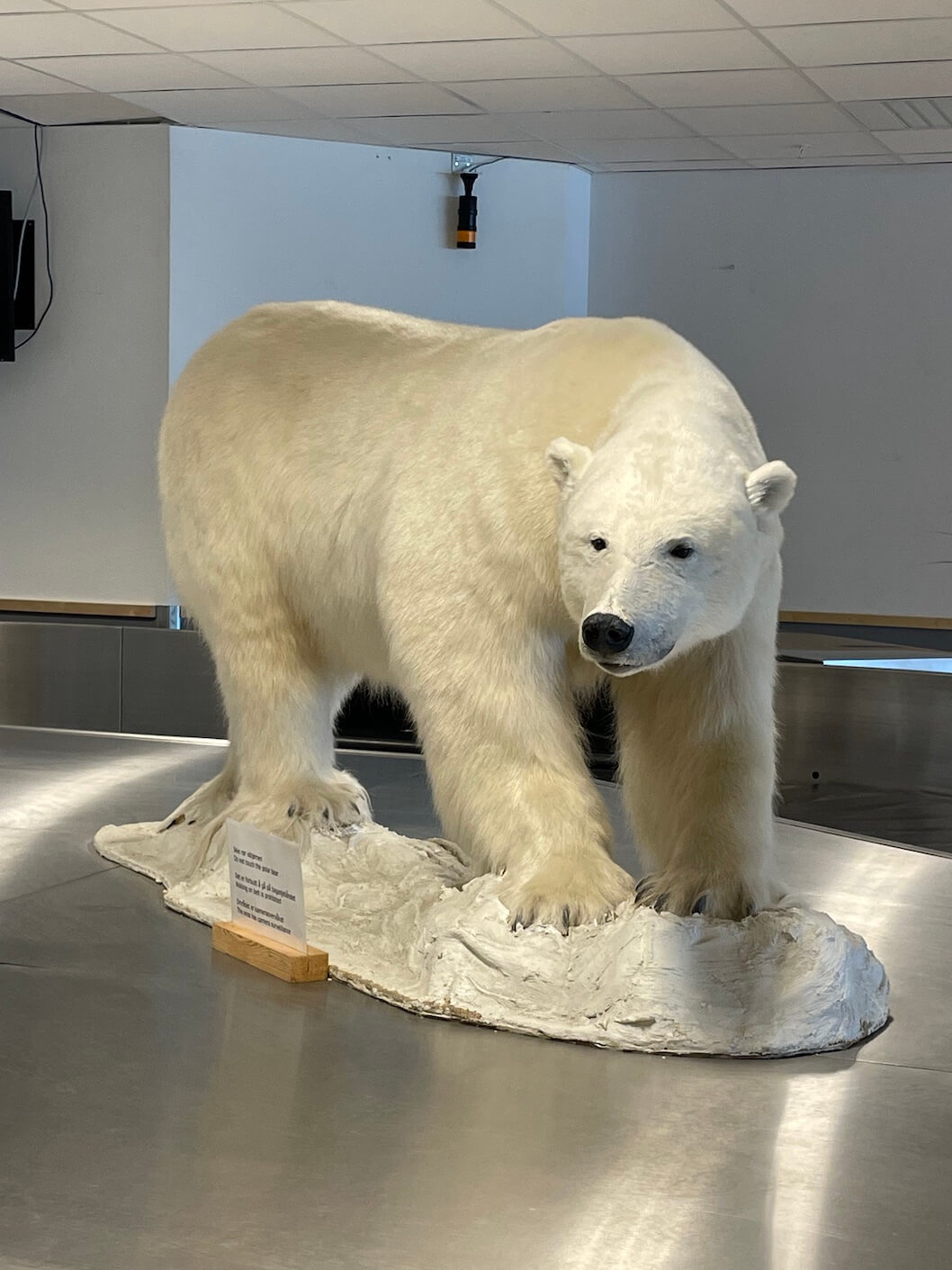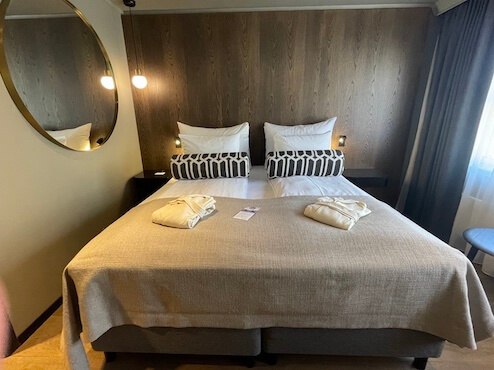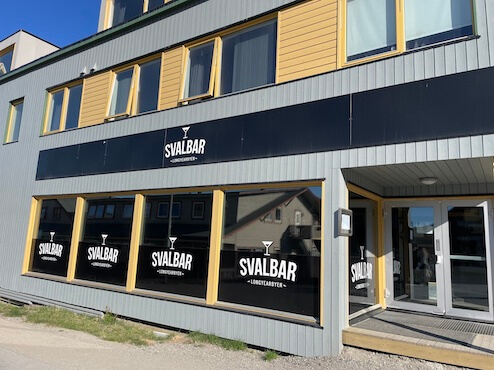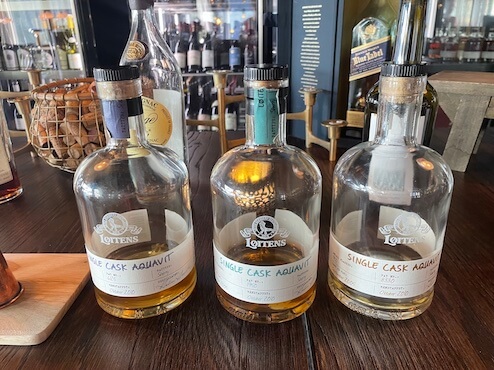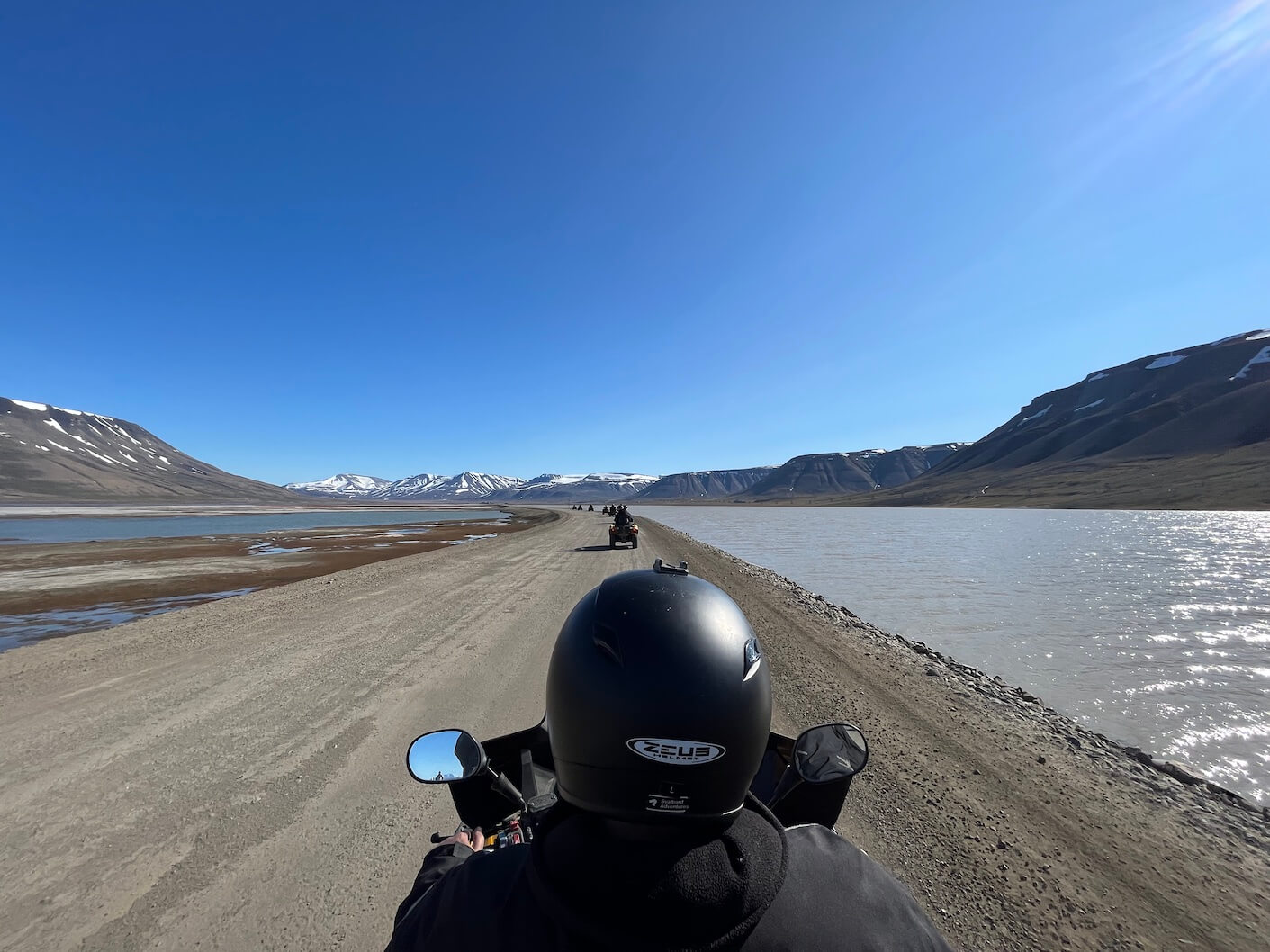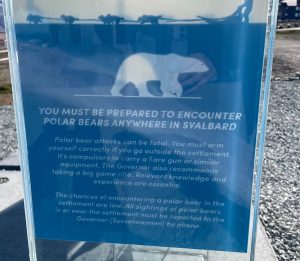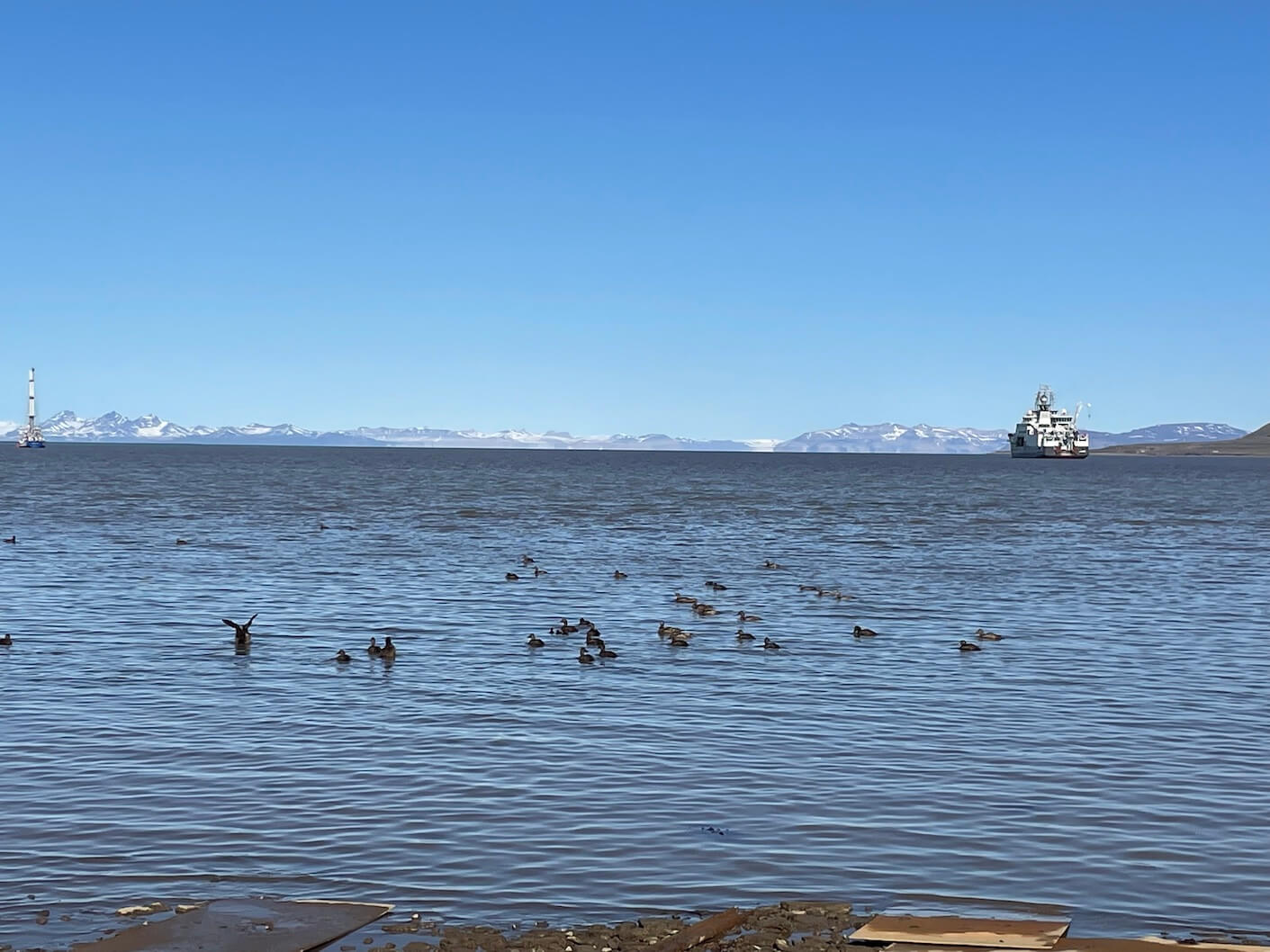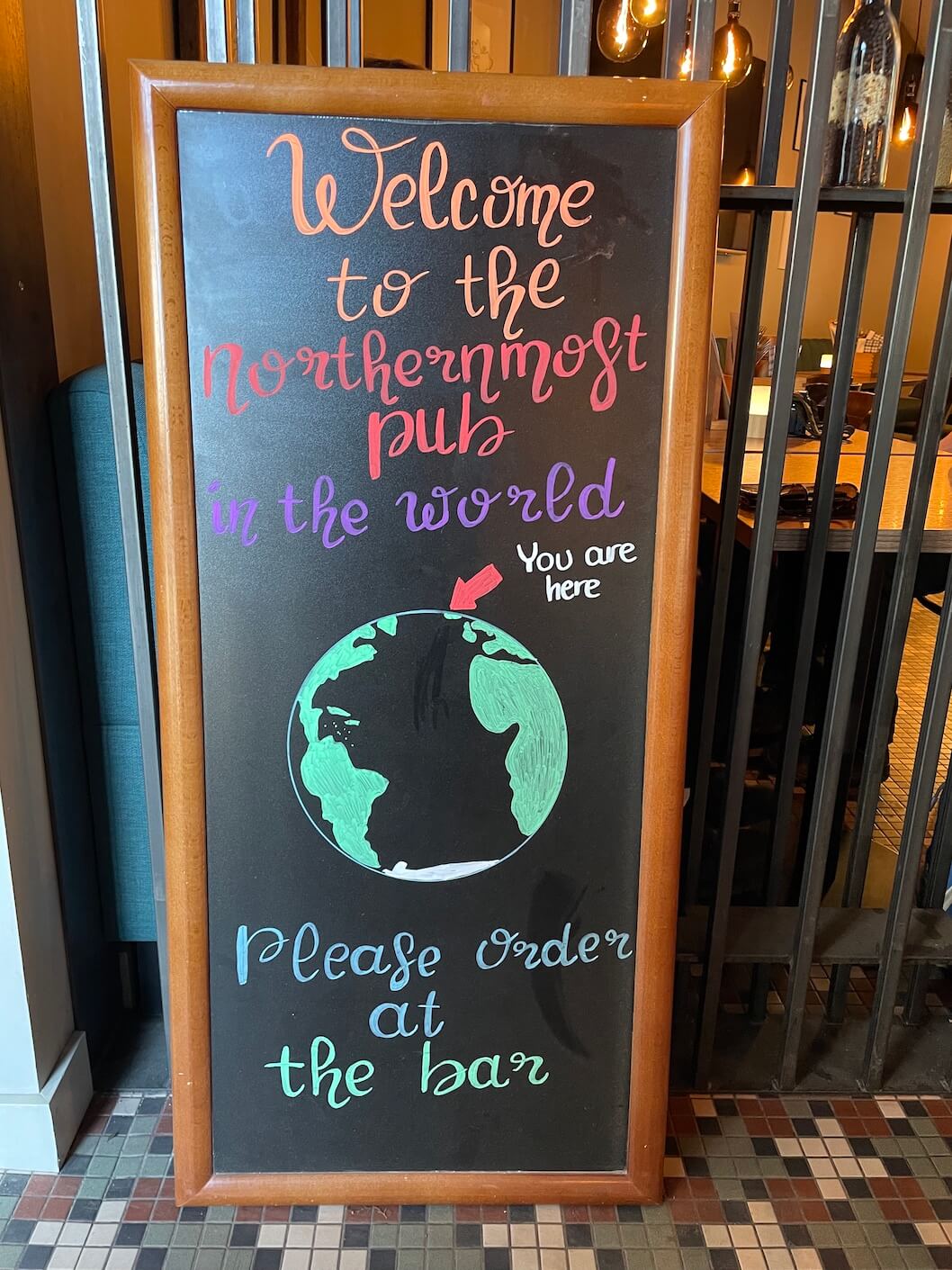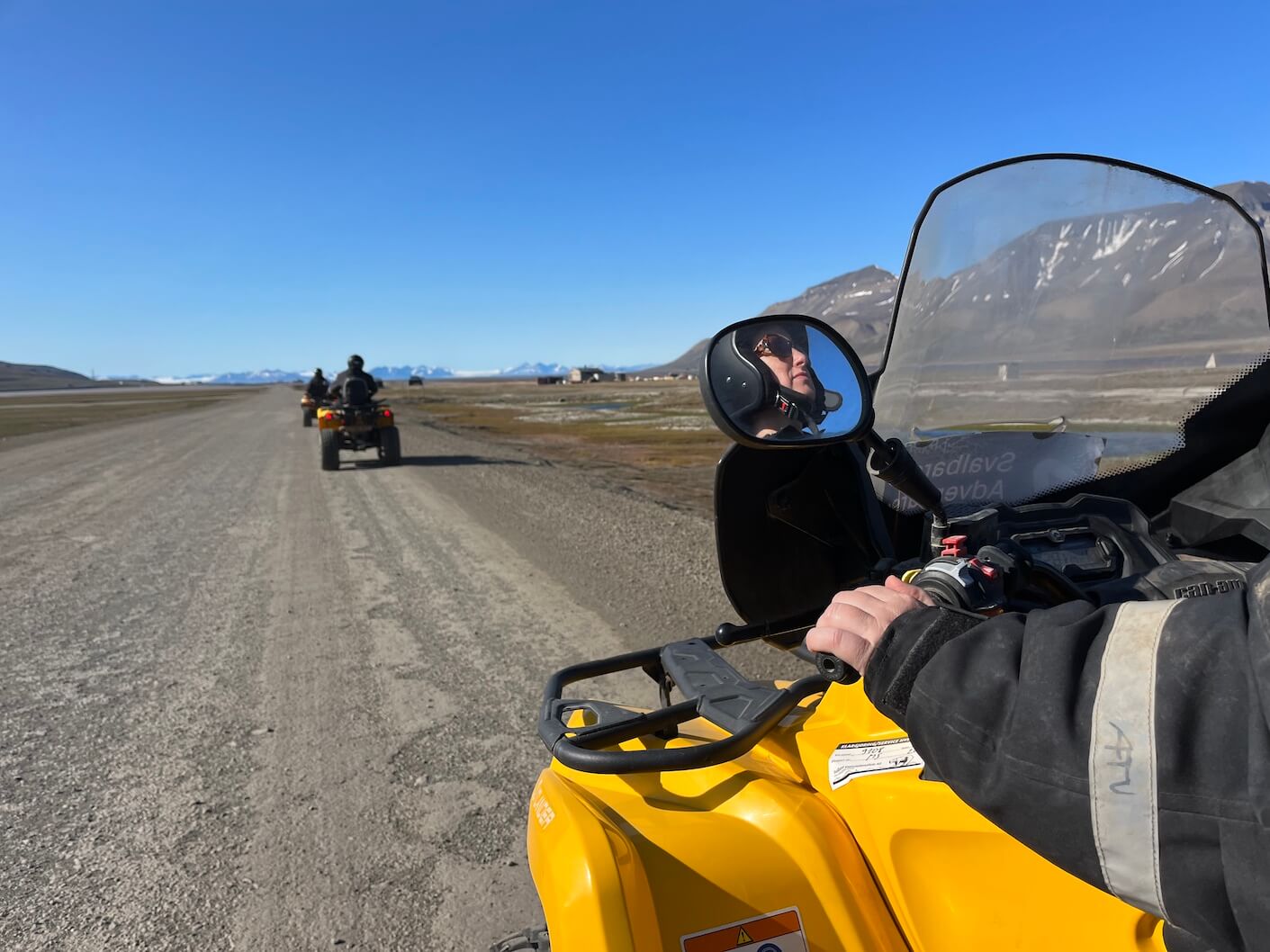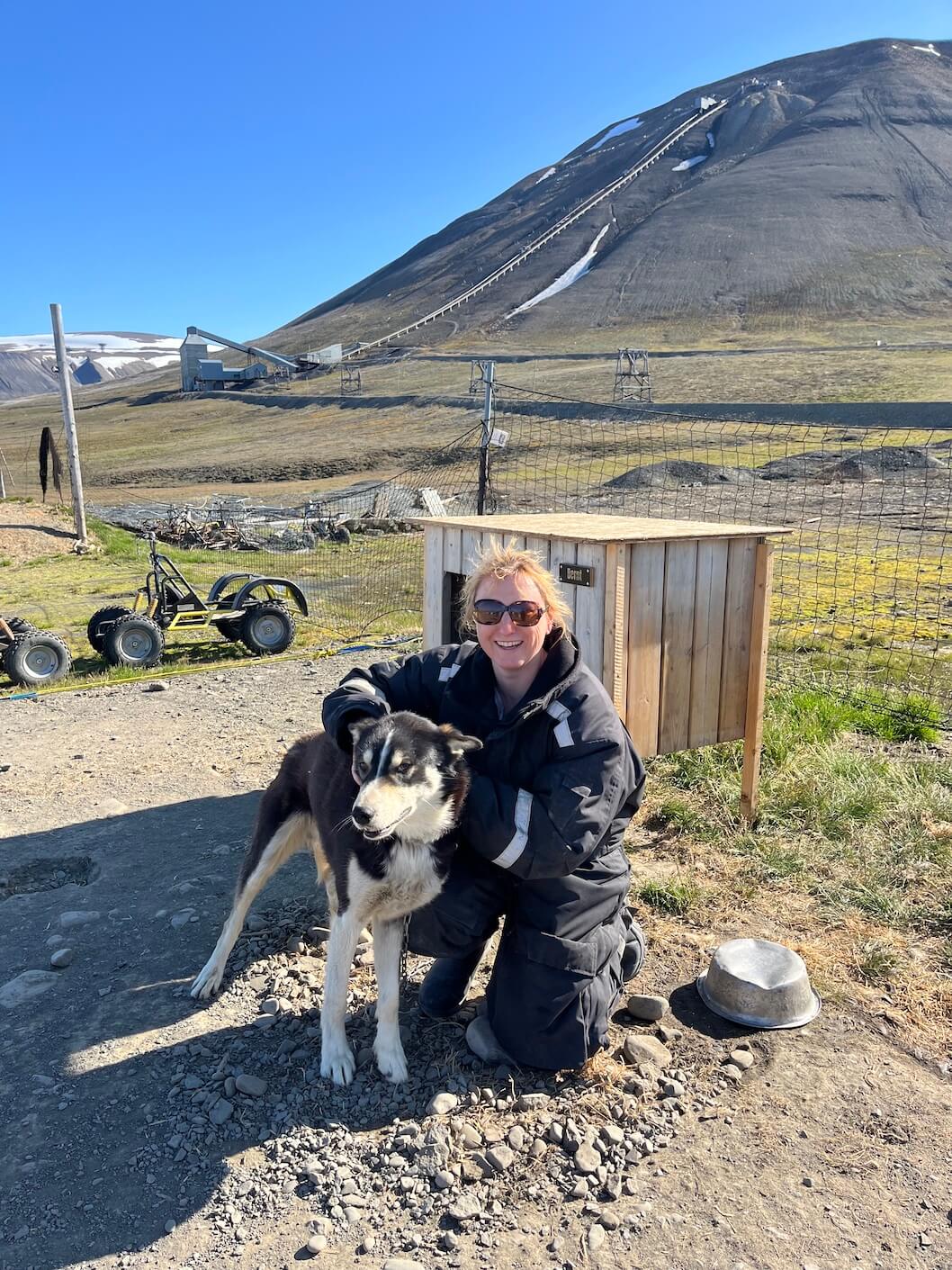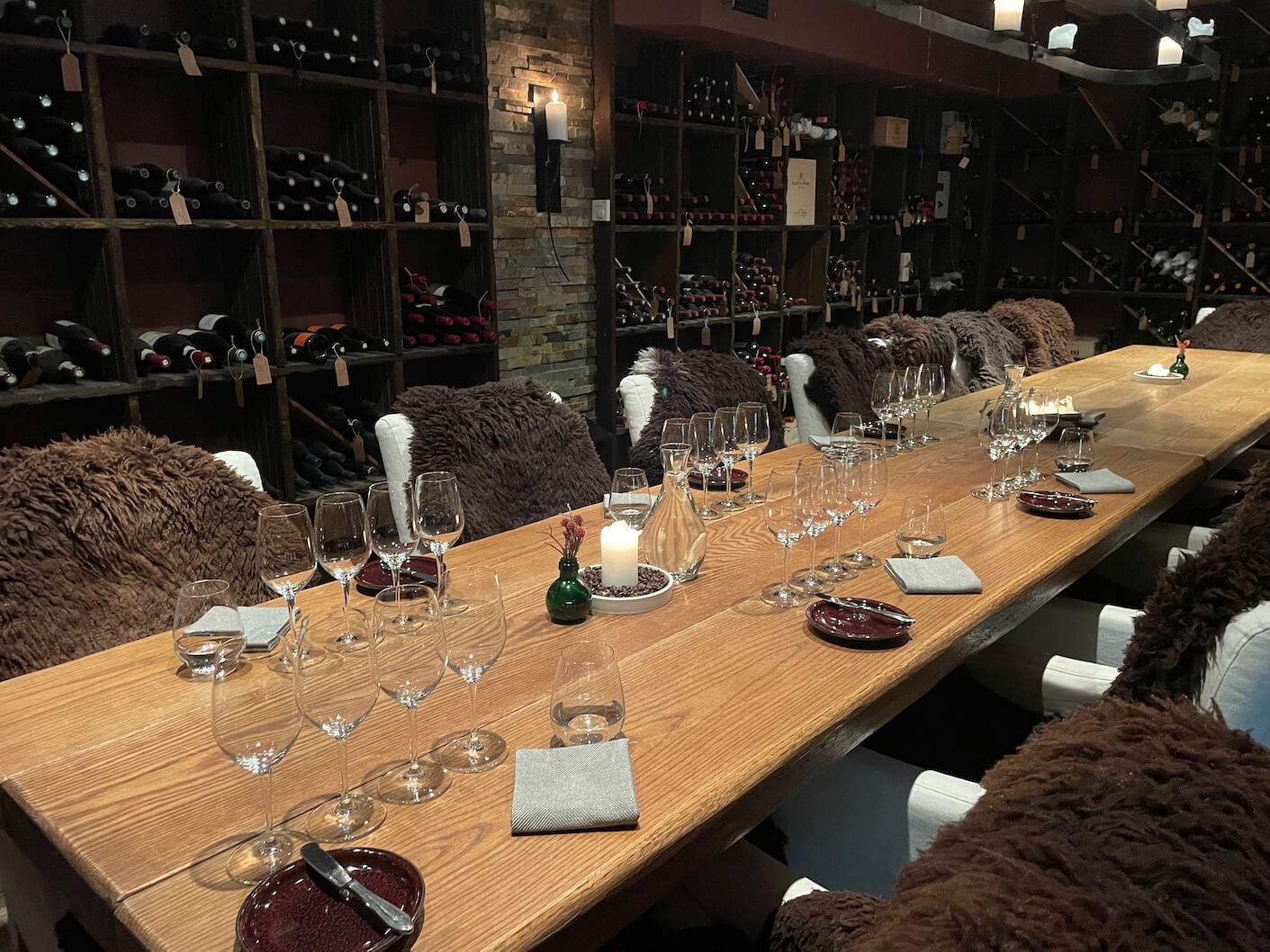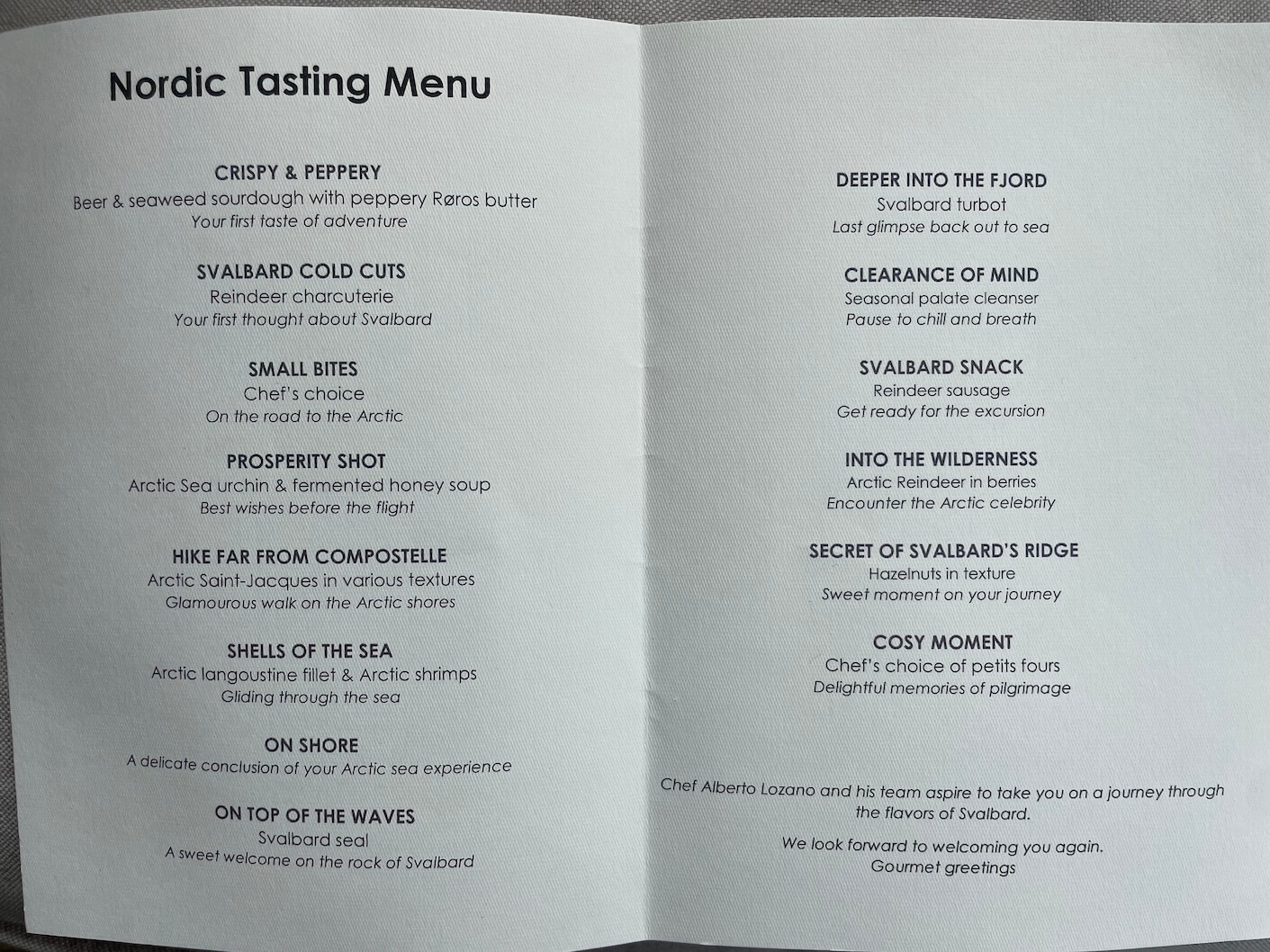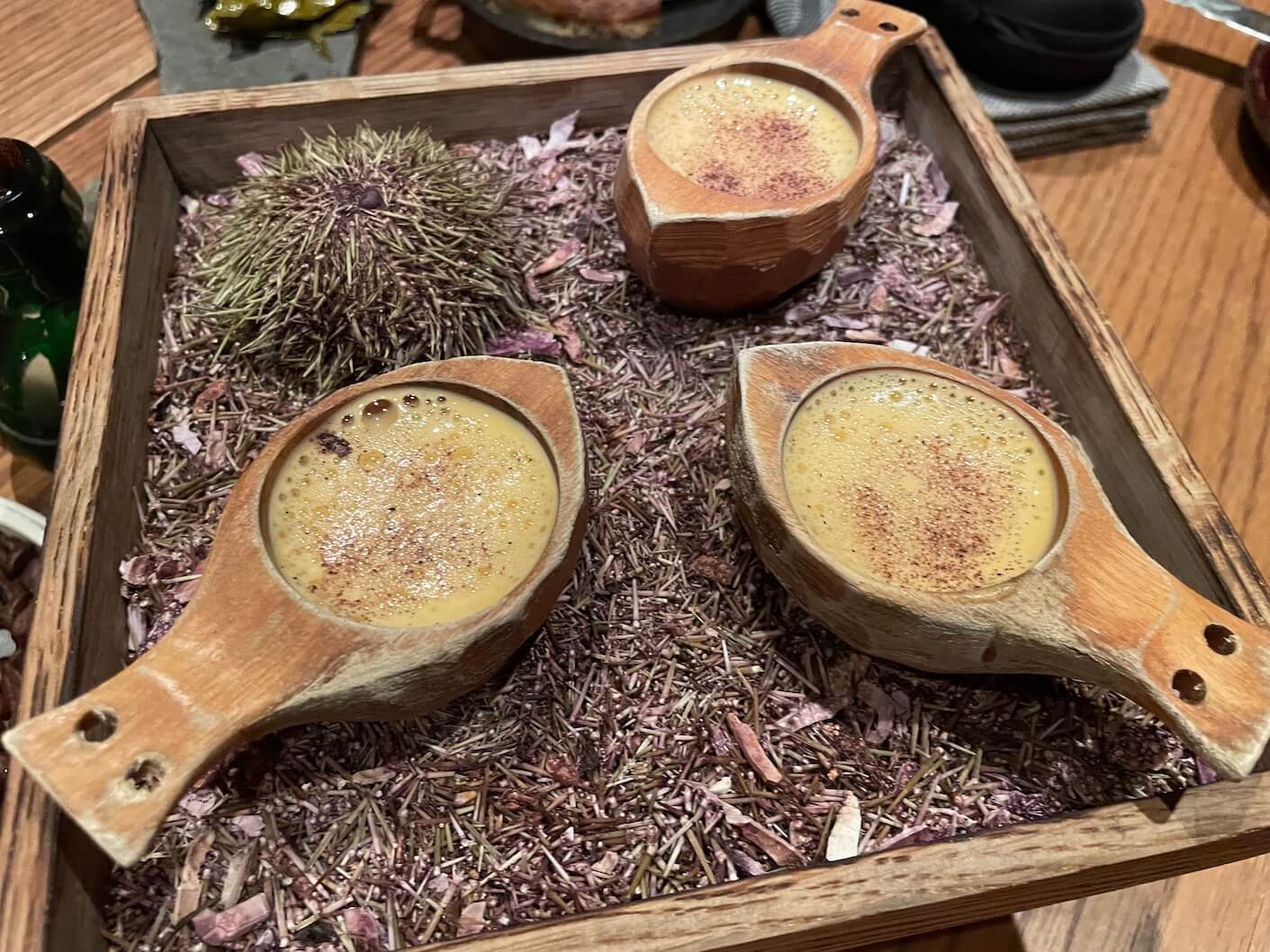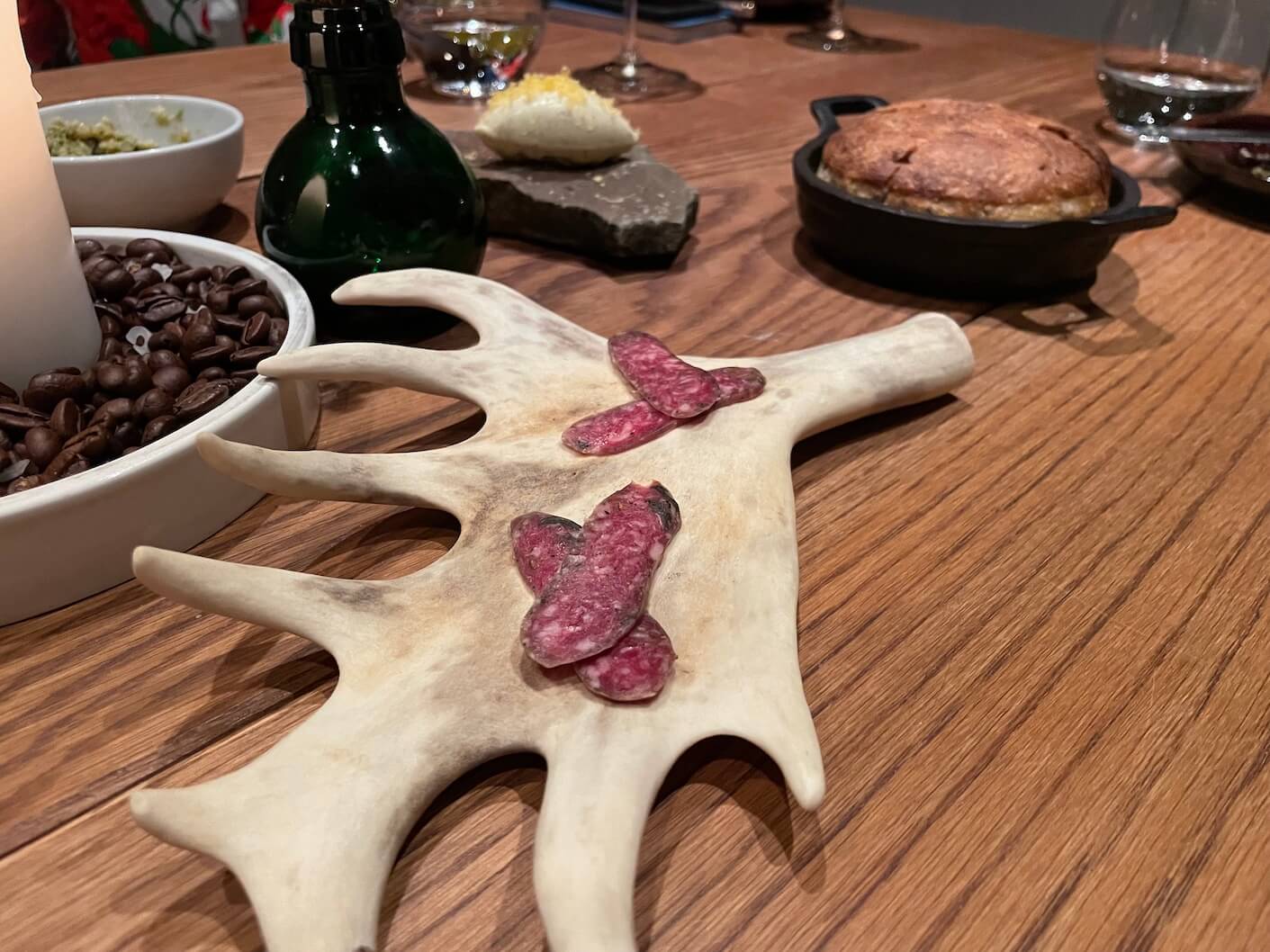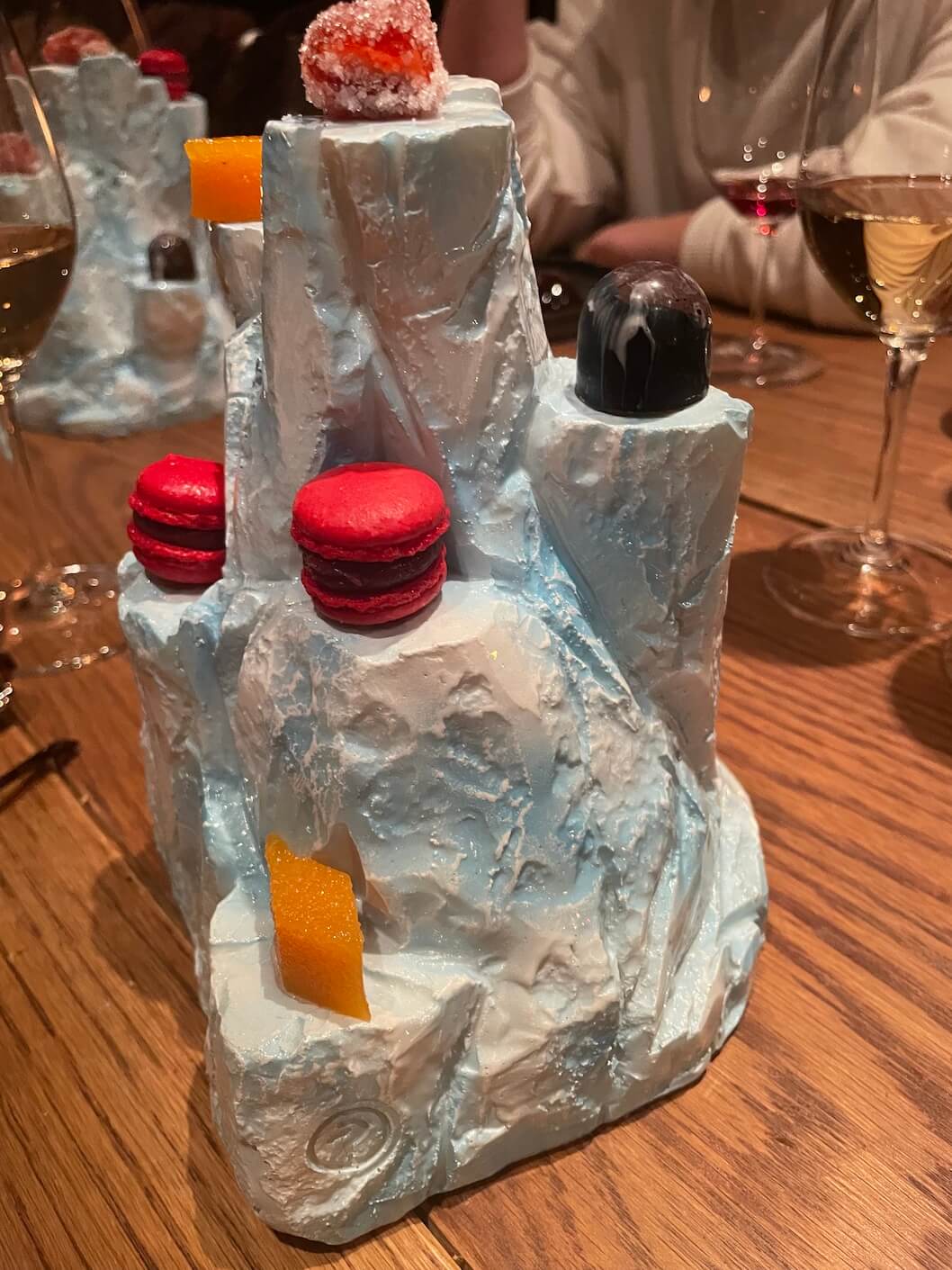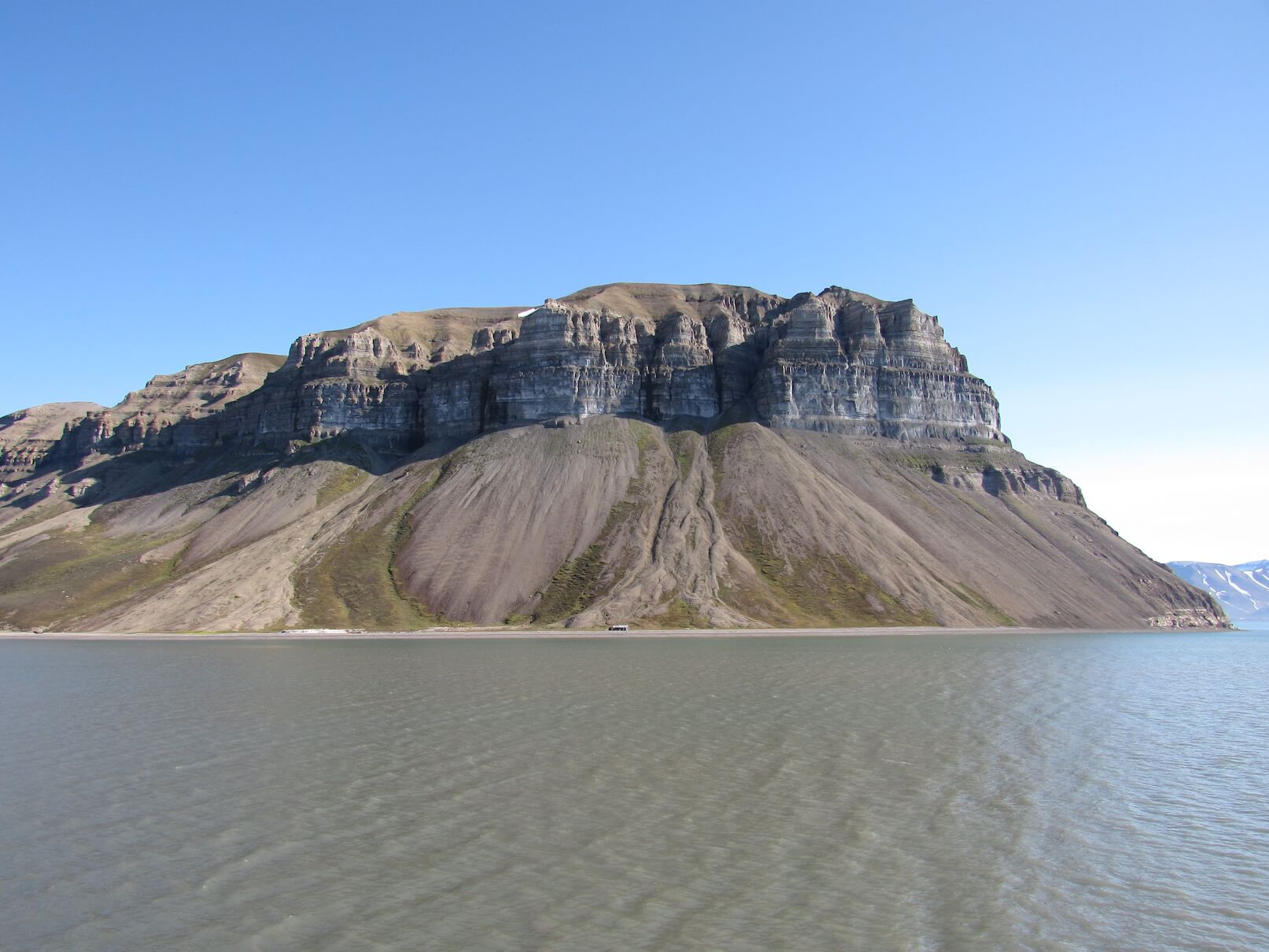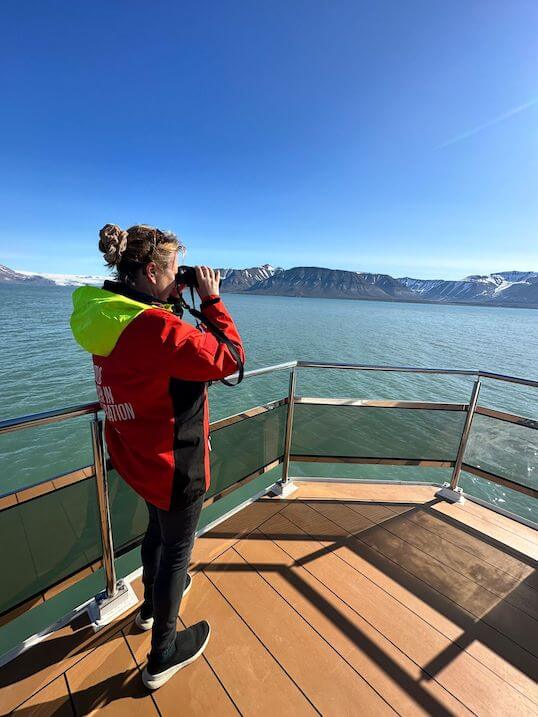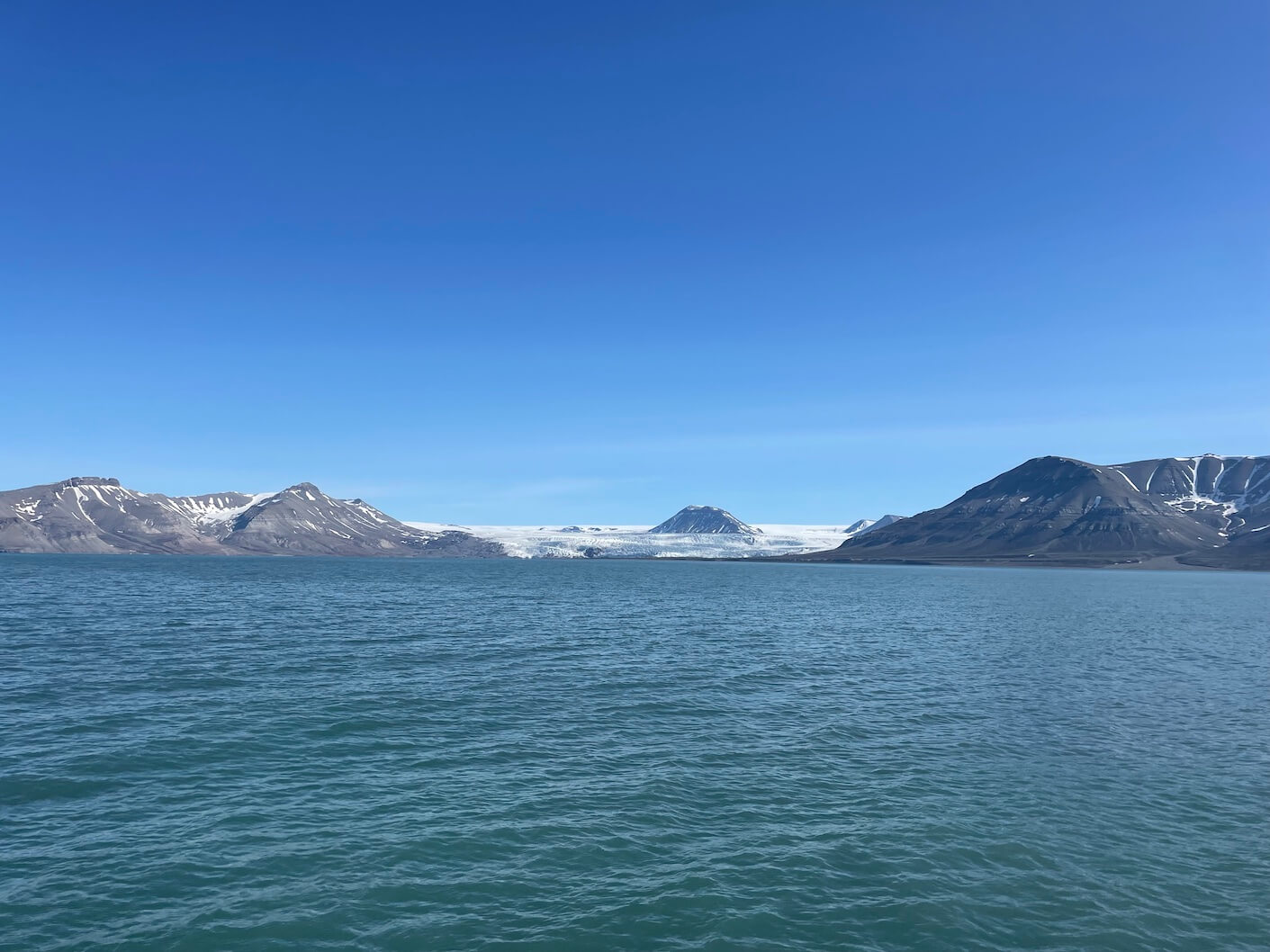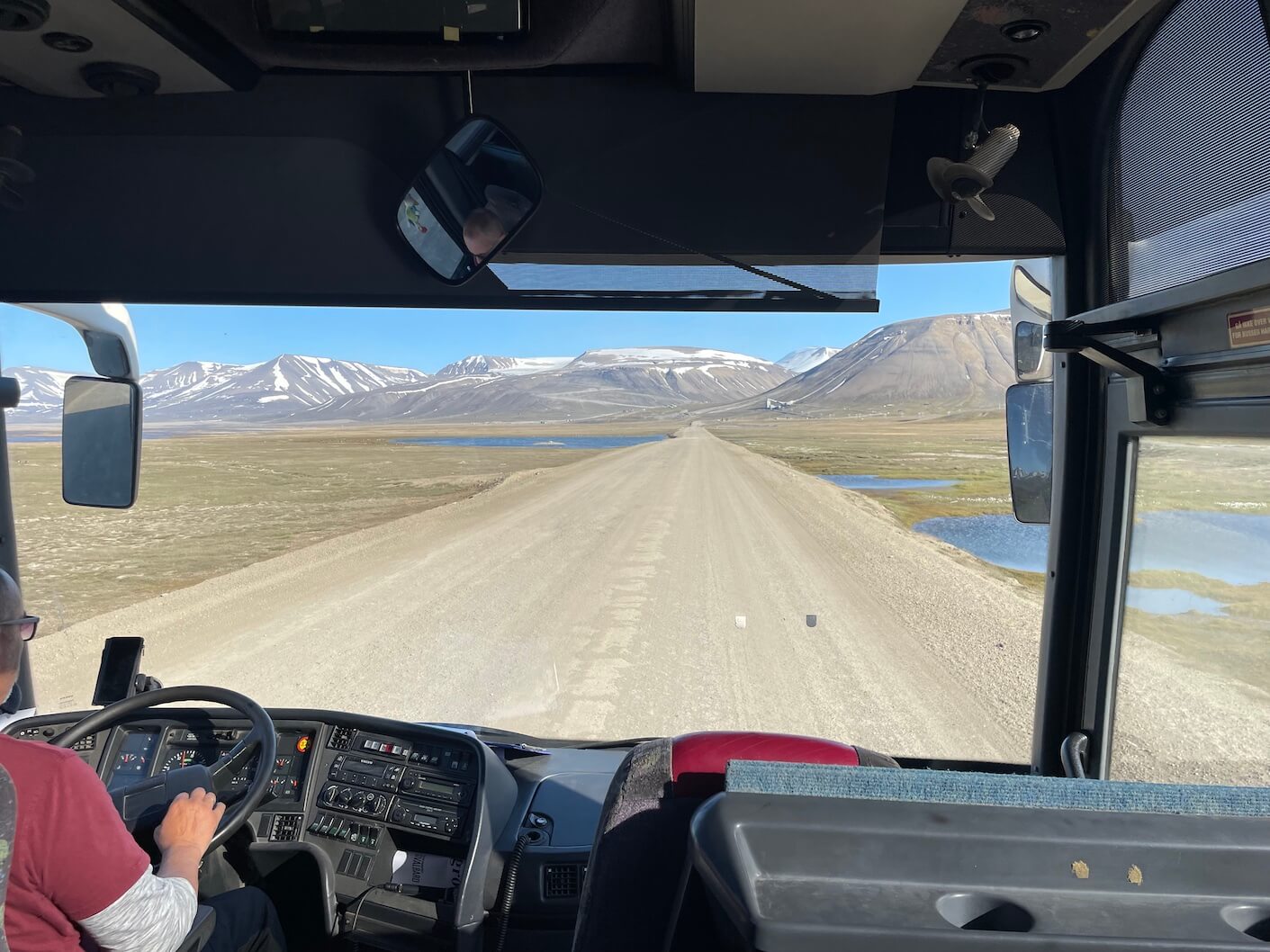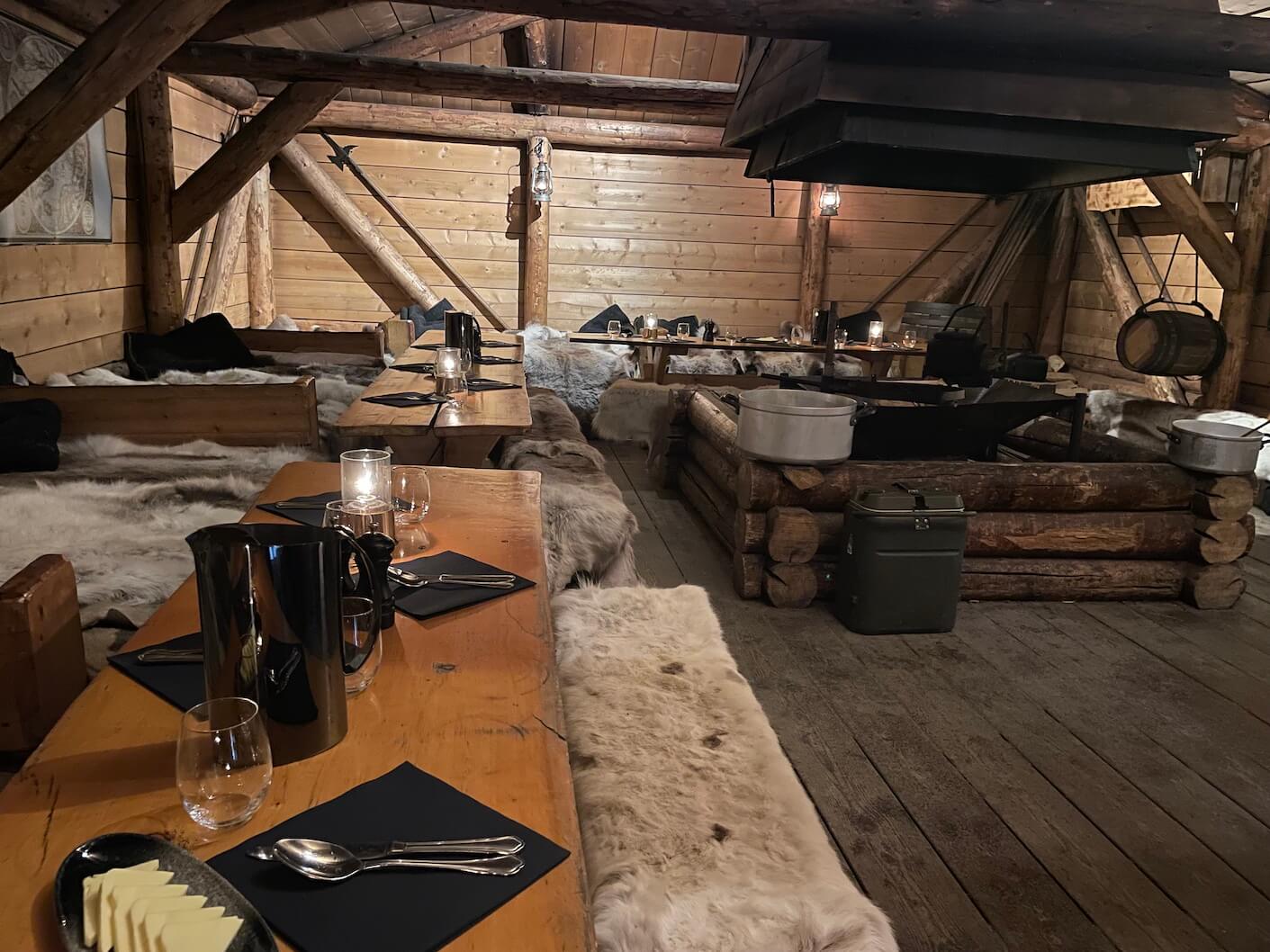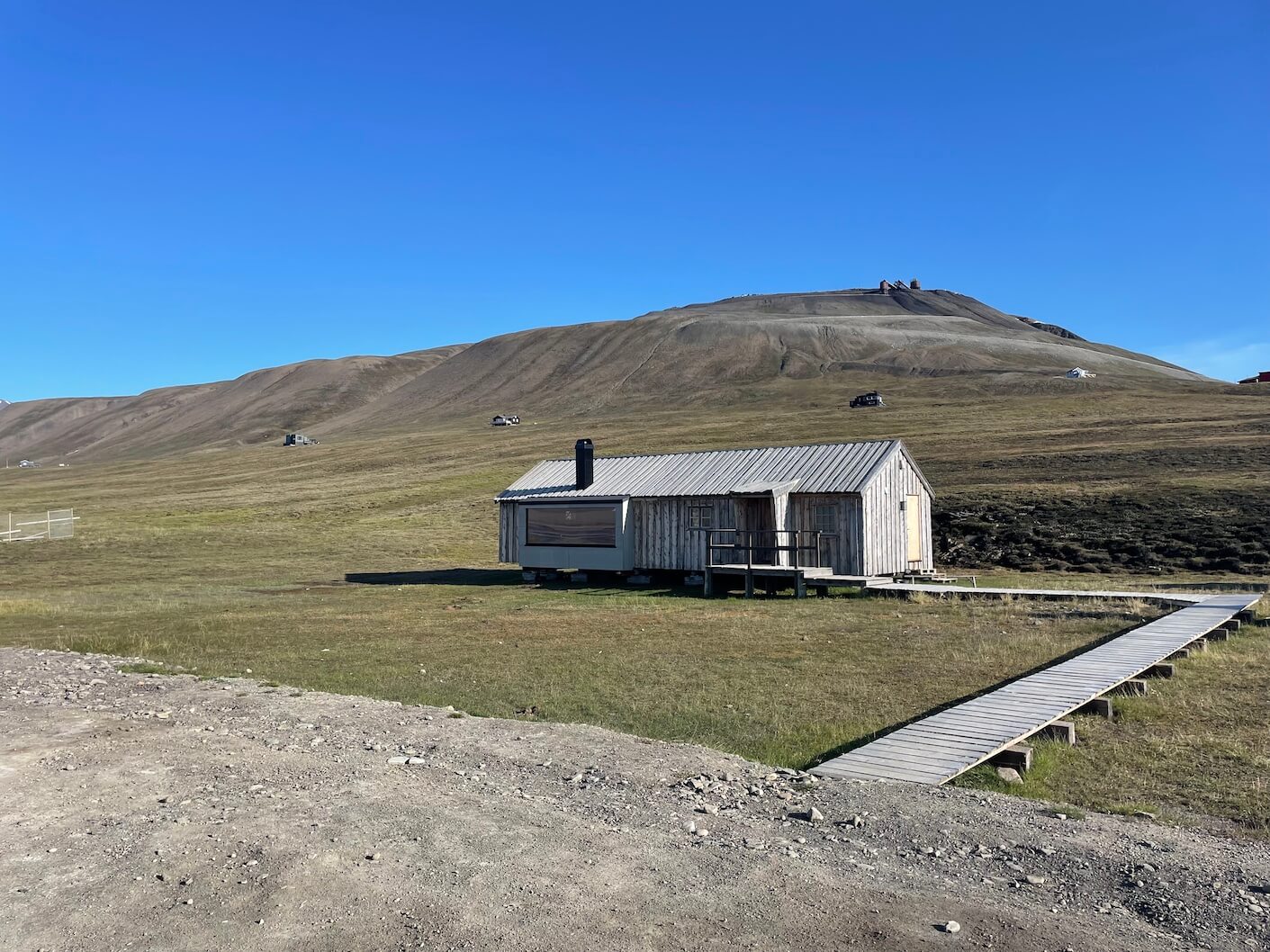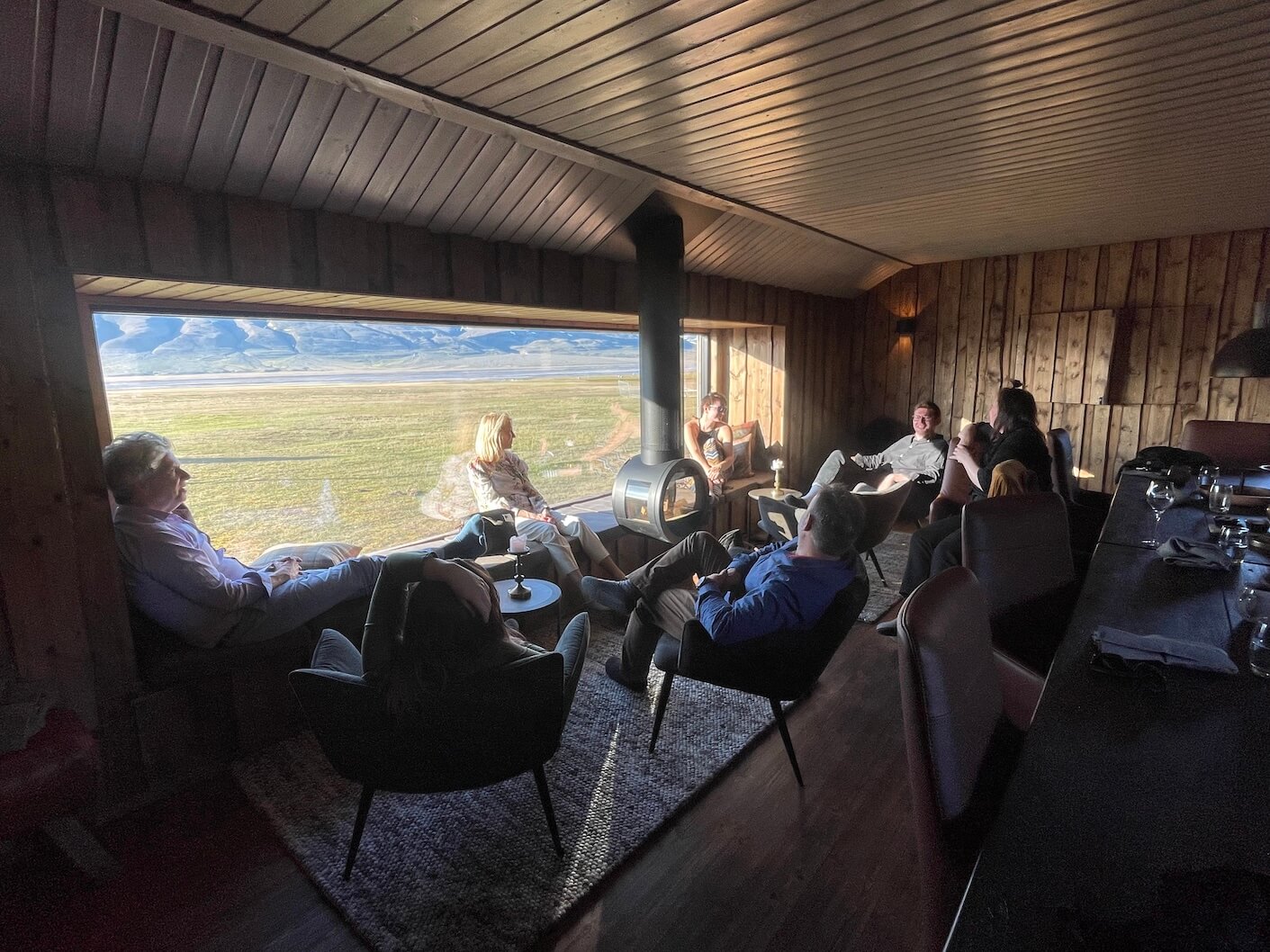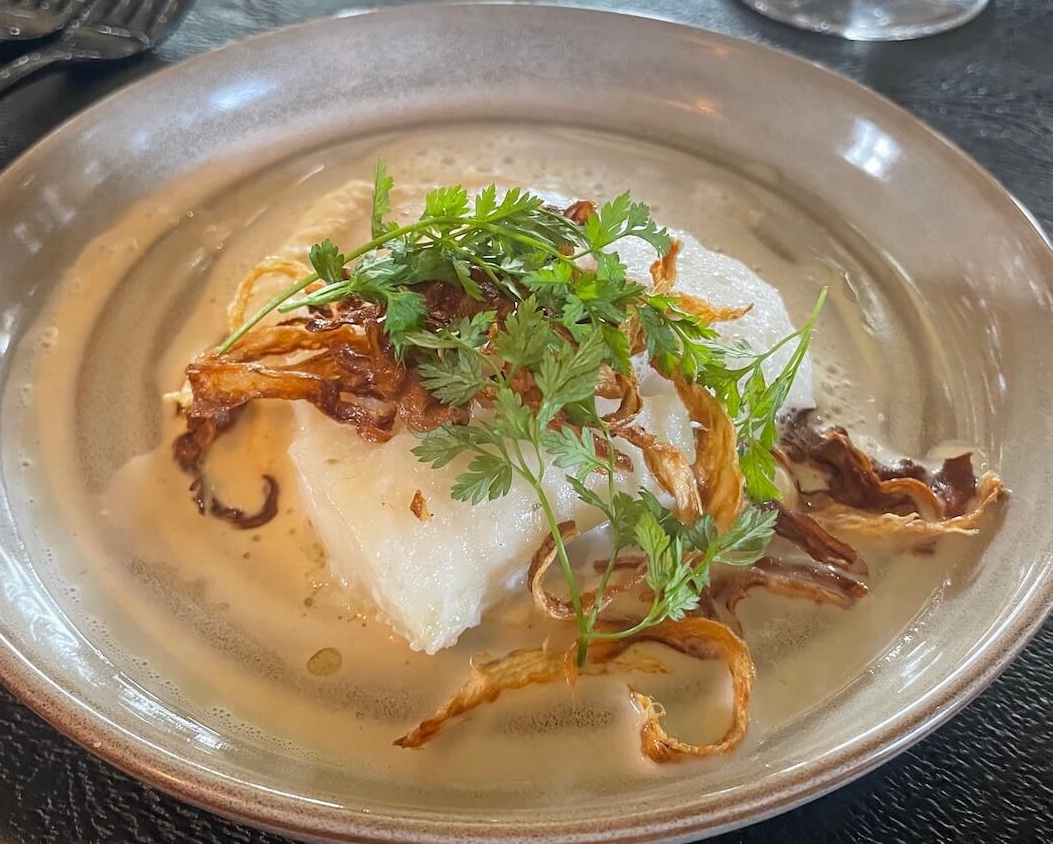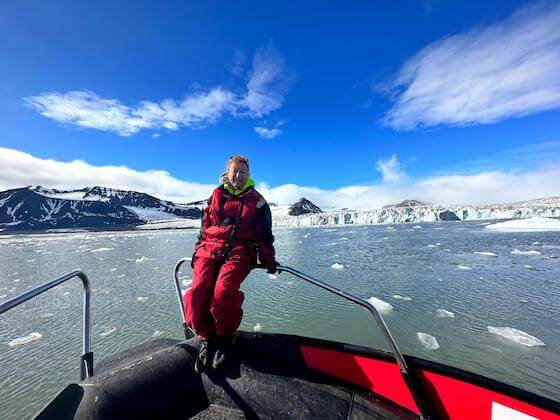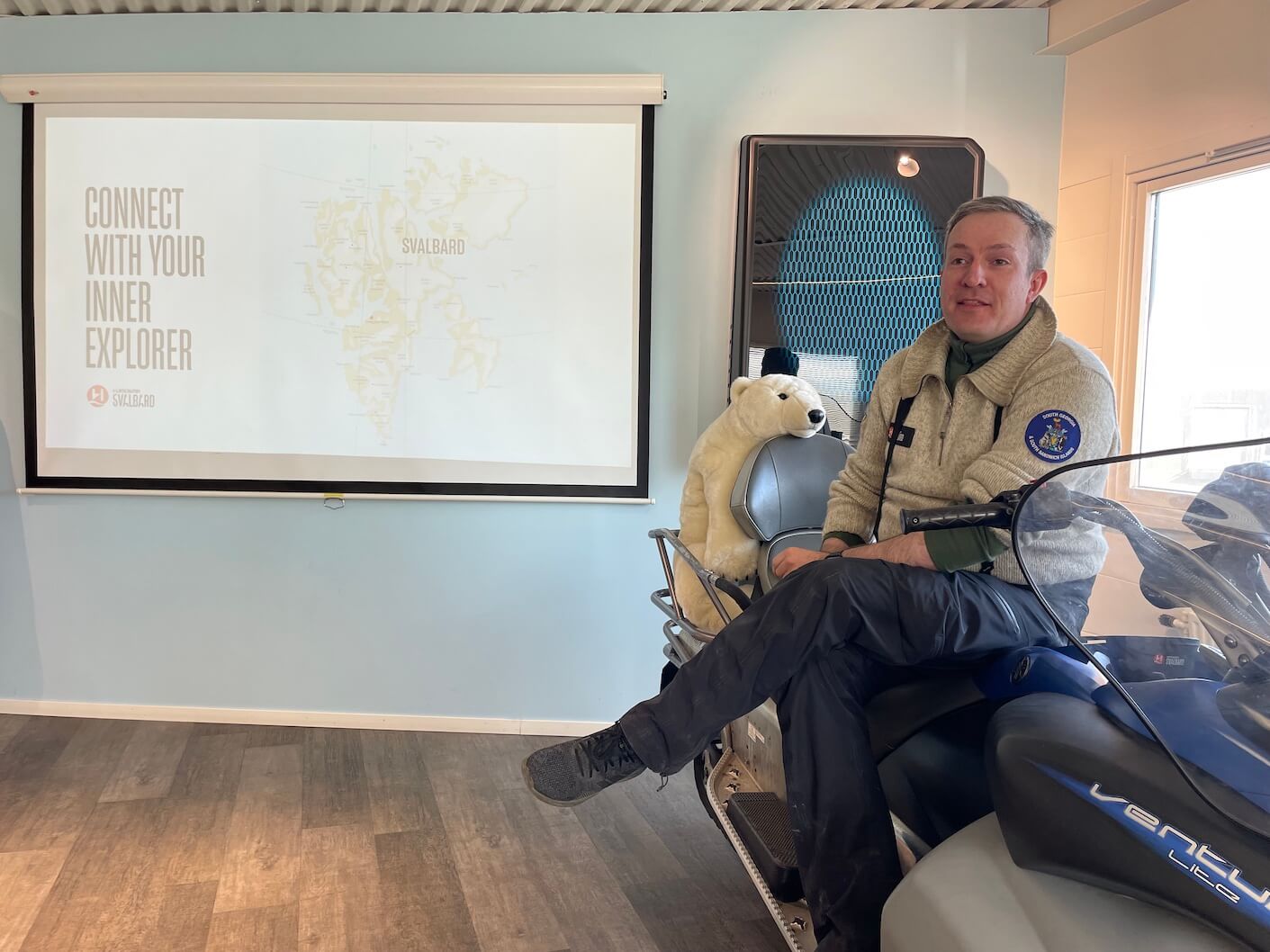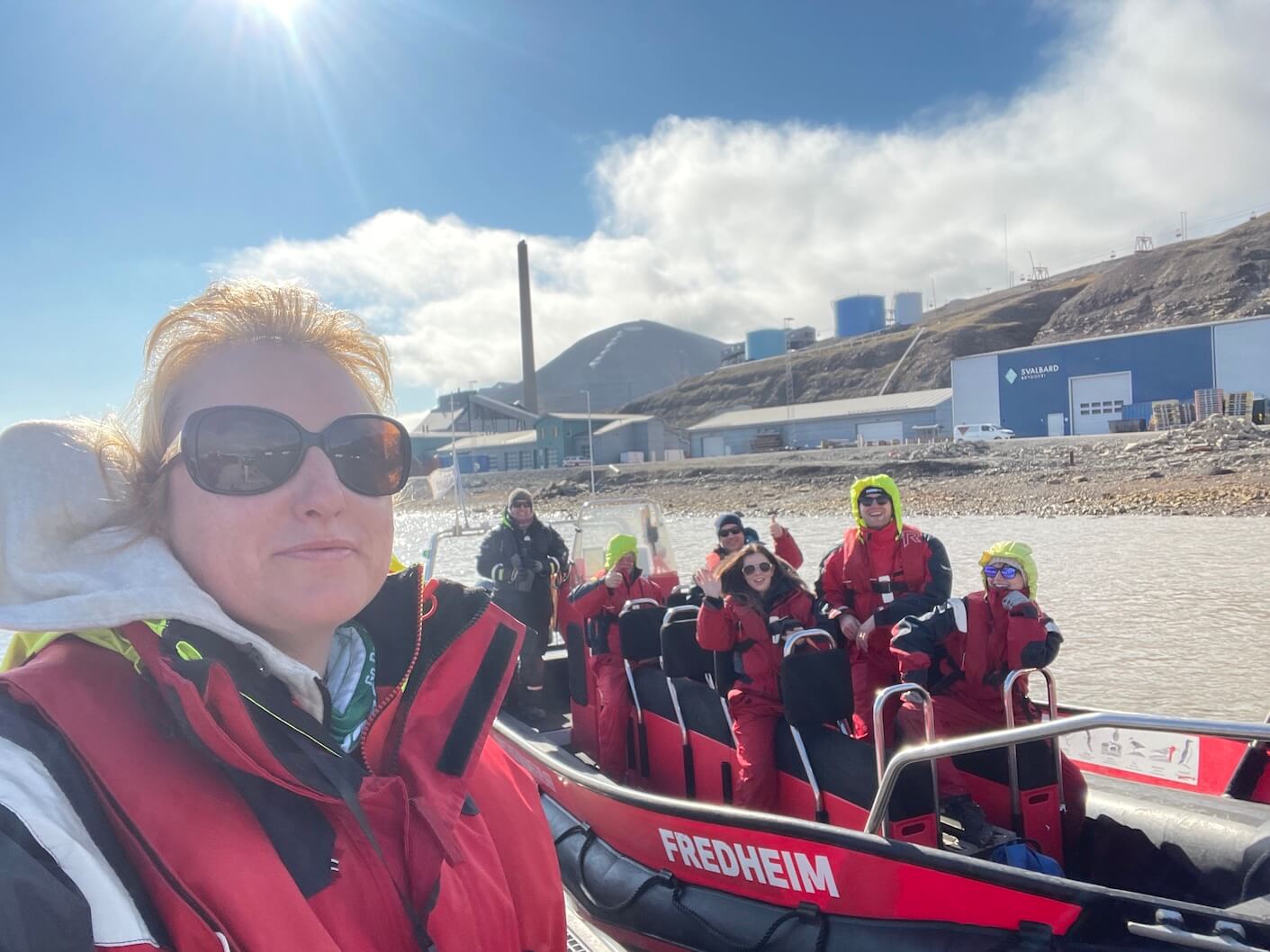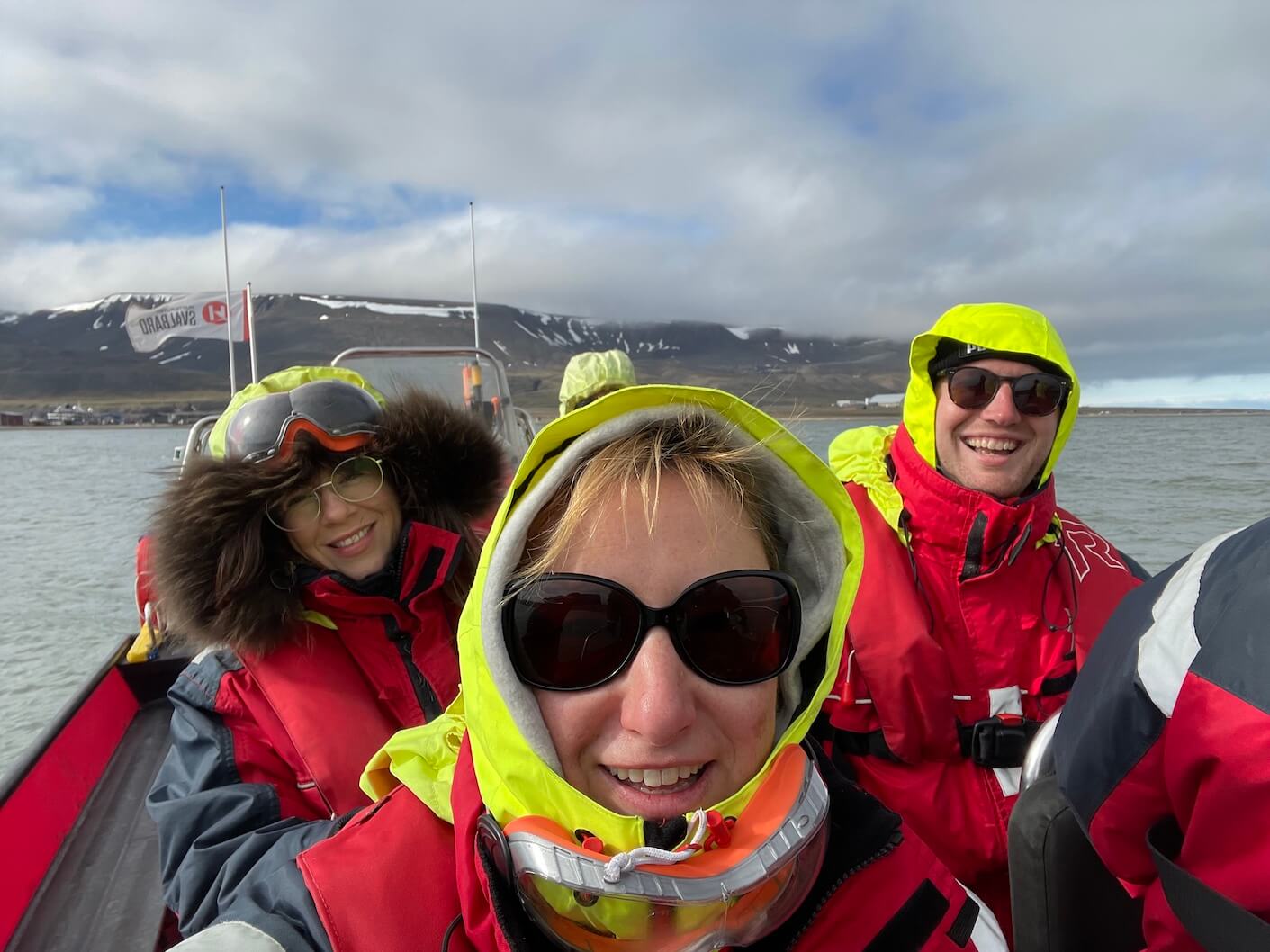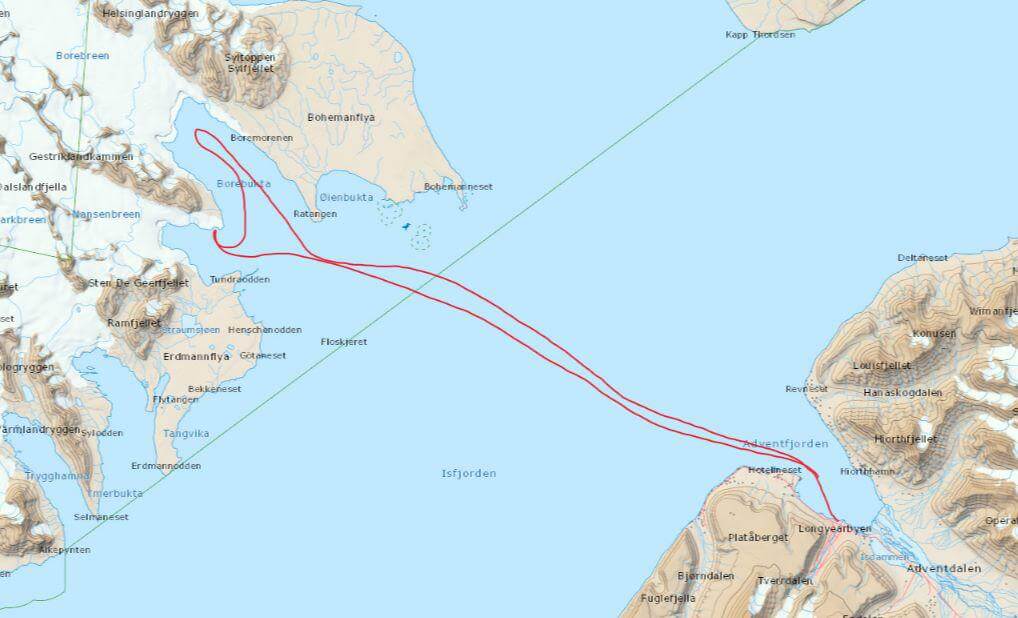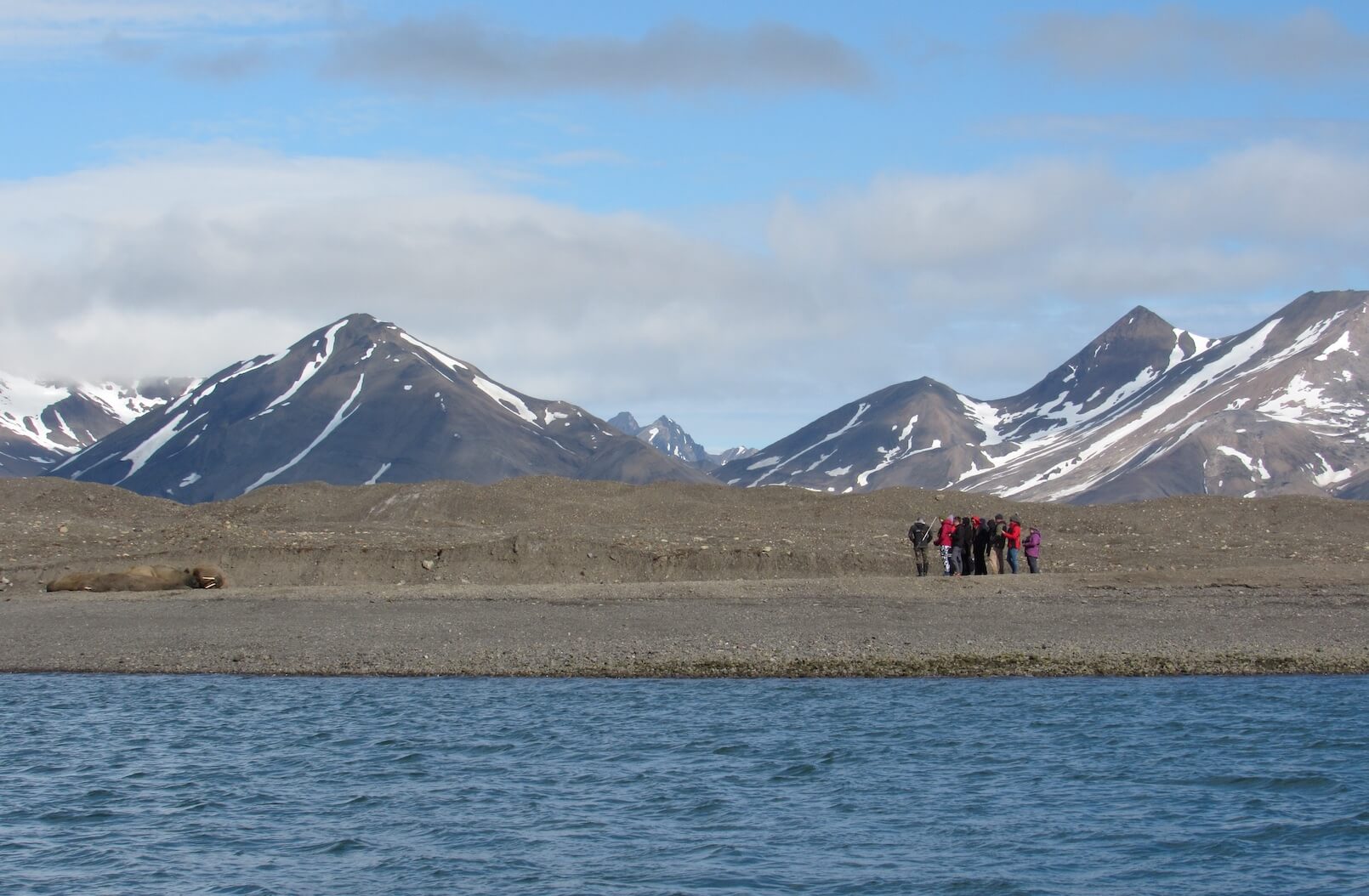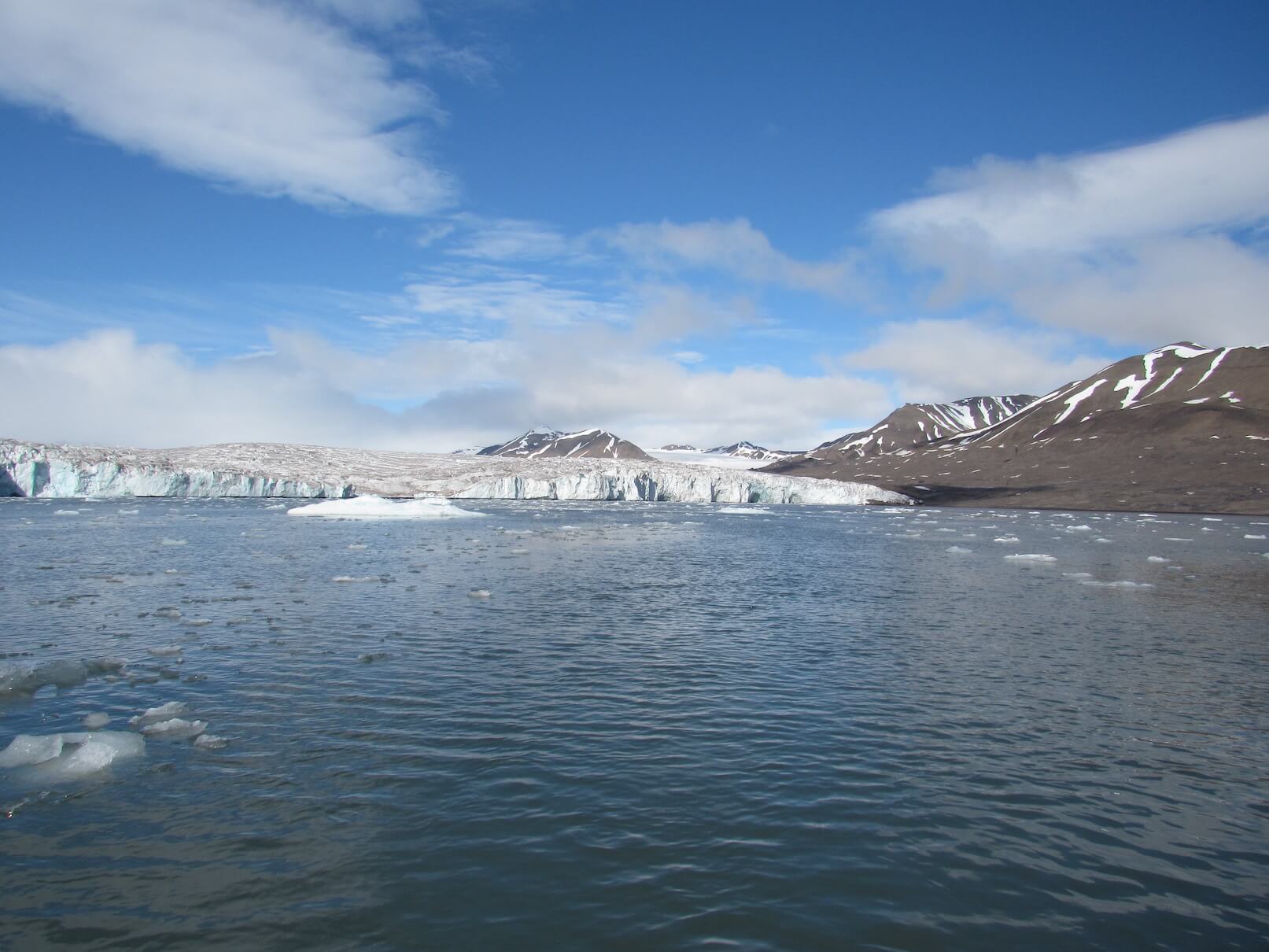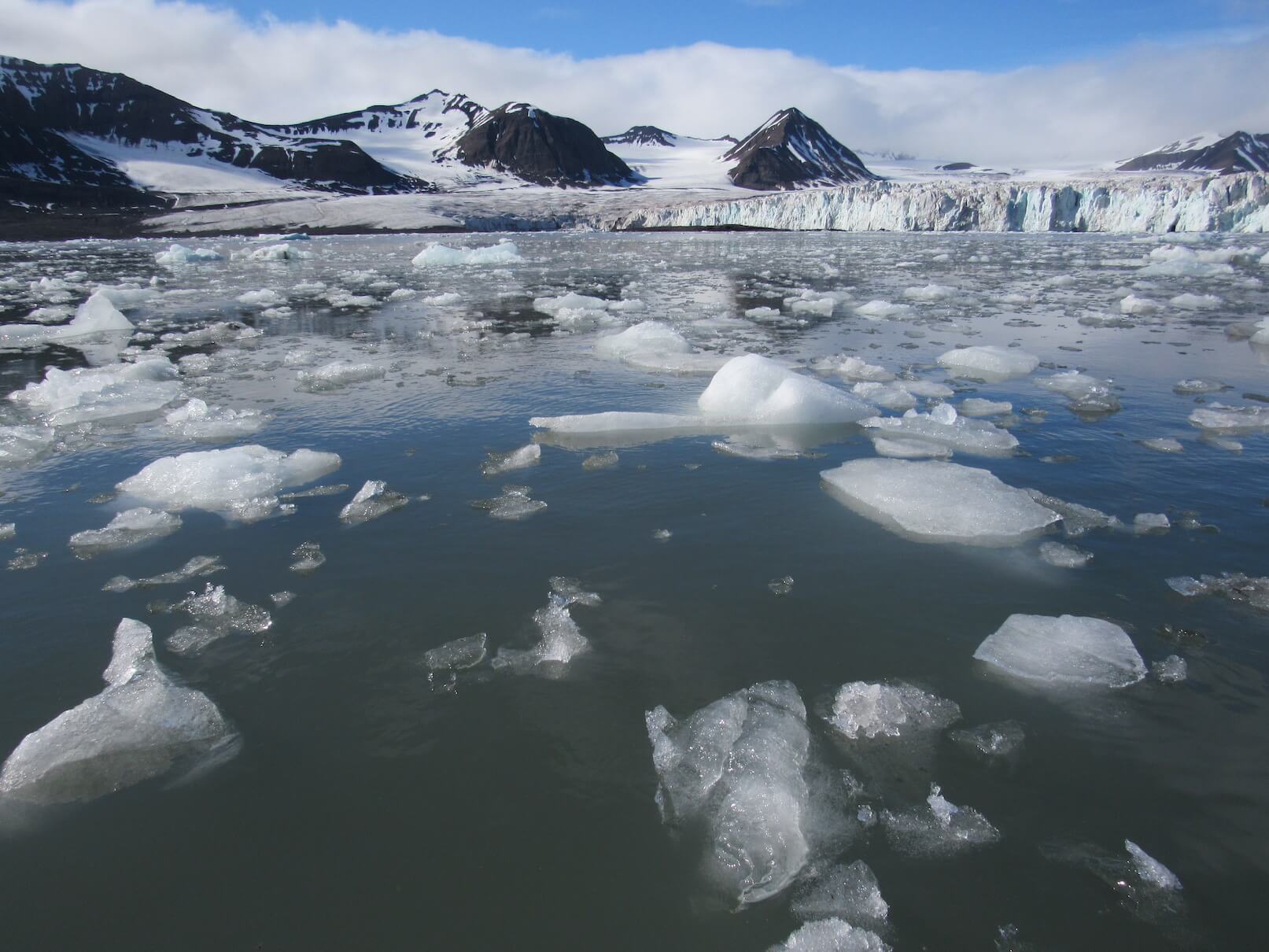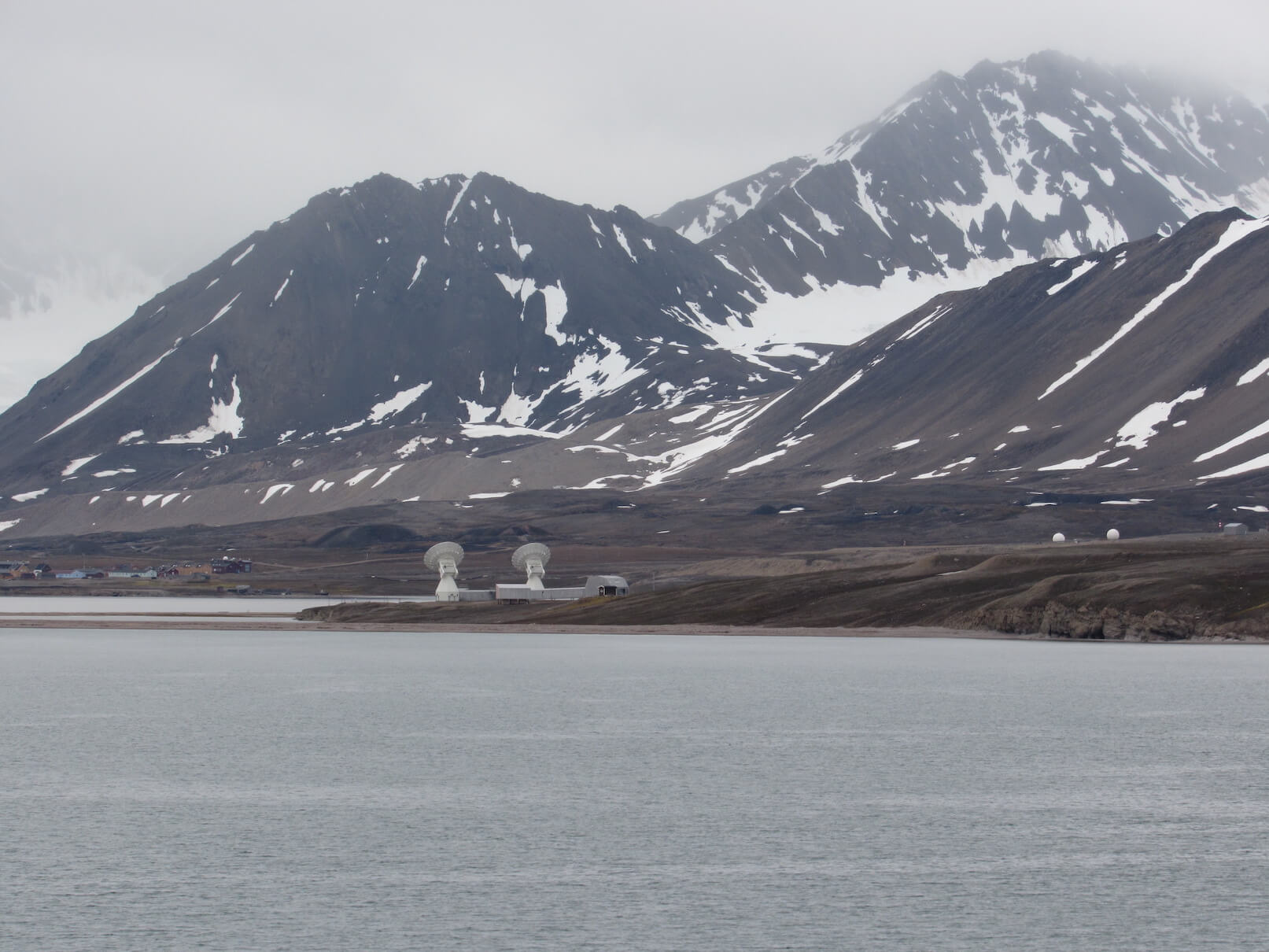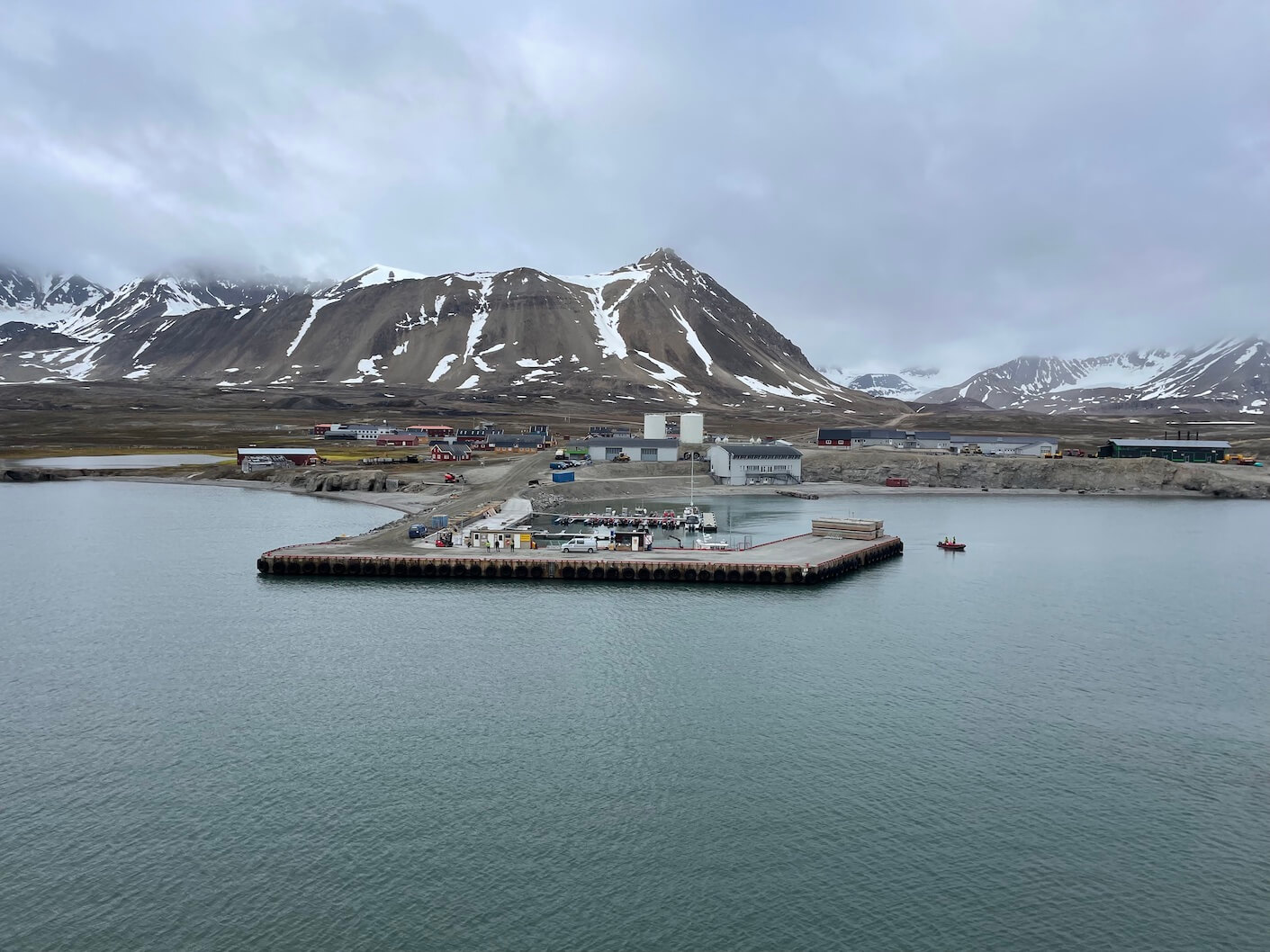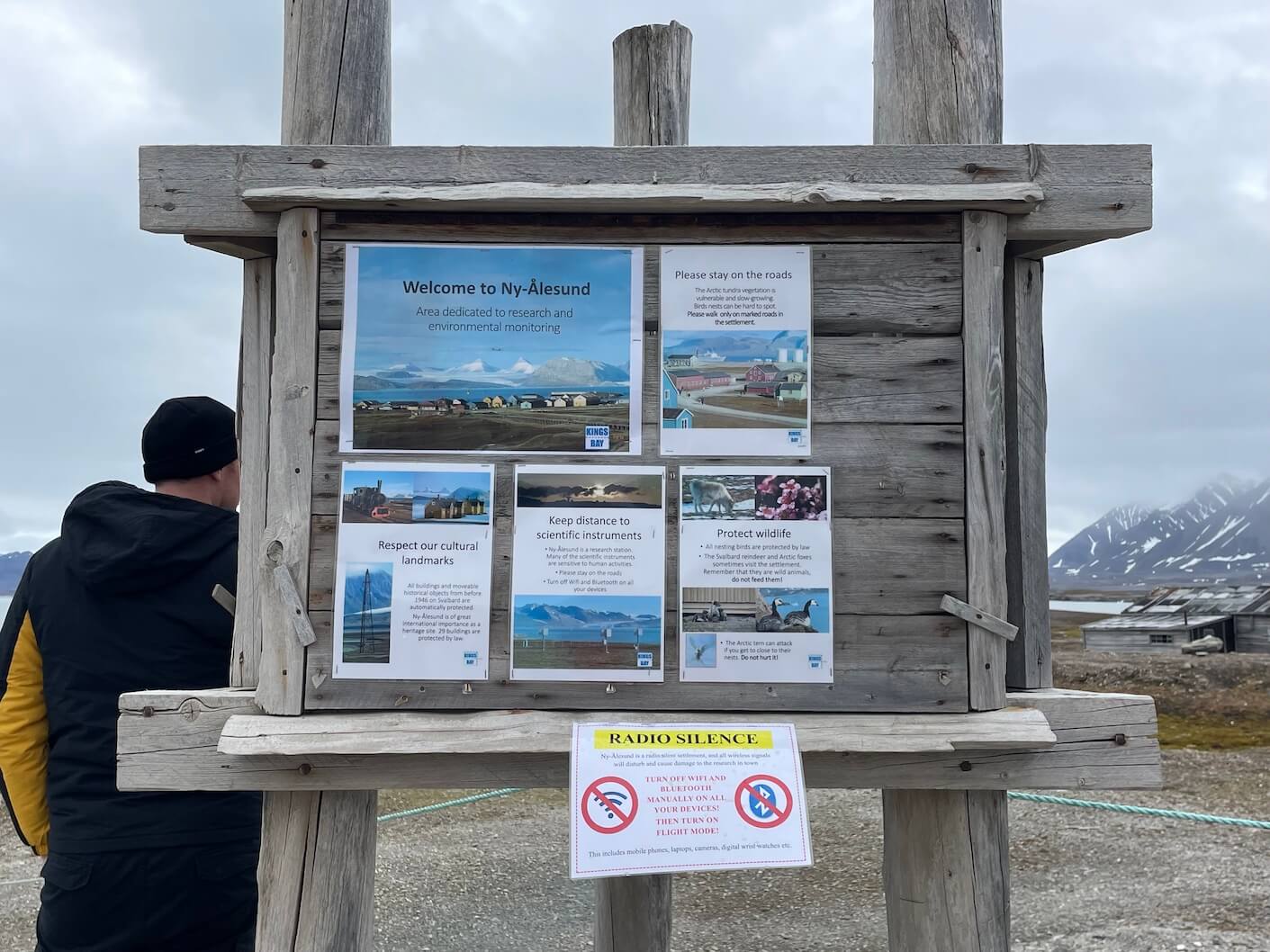Exploring Svalbard
The Svalbard Line from Hurtigruten Norwegian shipping line is back – and I was on only its third ever sailing for 40 years. This iconic route up the Norwegian coast to Svalbard in the Arctic Circle originally ran between 1968 to 1982 and has just been reinstated in Hurtigruten’s 130th anniversary year, travelling from Bergen in south Norway all the way up the coast to Honningsvag on the North Cape.
The ship then crosses more than 500 miles of the Barents Sea to the archipelago of Svalbard, calling in at Longyearbyen – Svalbard’s largest town – and then onto the world’s most northerly settlement, Ny-Alesund, at 78 degrees north, before heading back south.
Hurtigruten Cruises sailings and destinations
Hurtigruten Expeditions cruises and destinations
Sailing the Norwegian coast with Hurtigruten’s Coastal Express
Visting Svalbard in summer – 24 hour sunshine, quad bikes and RIB cruises
Visiting Svalbard in winter – my epic trip with Northern Lights, dog sledding and exploring glaciers
The journey crosses the Arctic Circle twice, takes in 11 stops in 15 days and guests can choose to sail from Bergen to Longyearbyen, from Longyearbyen to Bergen, or the whole, epic voyage starting and finishing at Bergen (northbound stops and southbound stops are different, so you’re not just seeing the same places twice up).
I joined the cruise in Svalbard for the sailing south, sailing on the MS Trollfjord from Svalbard to Bergen. On the journey I saw whales, sea eagles, seals, reindeer, walruses and Arctic terns, ate some incredible food and explored Svalbard itself from land and sea, including by quad-bike, catamaran and RIB (rigid inflatable boat).
[For an even more epic adventure you can explore Svalbard in winter, with 24-hour darkness and frozen seas]
Passengers on the Svalbard Line who do the full Bergen-Bergen sailing just get to spend six hours in Svalbard, with optional excursions of dog-sledding on wheels or a wilderness experience at Camp Barentz, but those starting or finishing their journeys in Svalbard get to spend much longer here – an option which I’d heartily recommend. Below is just some of the amazing activities you can enjoy in your time exploring Svalbard in my Svalbard Diary.
Day 1 – Arriving in Svalbard for the Svalbard Line
Flying from London Heathrow at 7.05am means waking up at 4.30am which is no fun at all, but it did at least mean no traffic on the M25, no queues at check-in or through security and, most crucially, more time spent exploring Svalbard itself.
I had to change planes in Oslo and it was interesting to see that the London-Oslo flight took 2 hours 10 minutes while the Oslo-Longyearbyen leg took 2 hours 55 minutes, showing how far north it really is. Even though Svalbard is part of Norway, it has a special jurisdiction thanks to the Svalbard Treaty, meaning it lies outside the Schengen Area, Nordic Passport Union, and the European Economic Area. In practical terms you have to go through Passport Control at Oslo airport and get a stamp showing that you have officially left Norway, and the guy at Duty Free told me that had I spent time in Oslo itself, then I wouldn’t have been able to buy anything there (it was rather confusing as I was only buying chocolate-covered salty liquorice, a Norwegian speciality which I’m incapable of resisting).
Landing in Longyearbyen – pronounced Long-yer-been – is stunning on a clear day. Make sure you get a window seat if you can as the views are great from either side and we were treated to snowy peaks and glaciers for a good 20 minutes while coming into land.
Passengers are de-planed straight onto the tarmac and are asked not to linger taking photographs, but it’s impossible not to as the vast, open space edged with a ring of snow-topped mountains which greets you the moment you step off the plane is hard to ignore.
When you finally get into the baggage hall – there are no more passport checks – the first sight to greet you is a large, stuffed polar bear, which is a popular subject for a lot more pictures.
Most people coming to Svalbard have hopes of seeing a polar bear or two (from a safe distance) and yet, while there are around 2,500-3,000 polar bears in Svalbard, they tend to stay clear of the settlements and instead roam in the more northerly, remote parts of the islands. It’s hard to avoid the stuffed or toy versions though, as every shop has everything from cuddly toy polar bears to clothing and even beer and chocolate adorned with polar bears, so it’s definitely the place to come if you can’t get enough of these Arctic giants.
The airport at Longyearbyen is just a short drive out of town, and people either get a taxi or the airport shuttle bus which stops at every hotel and guesthouse in town and costs just 100 NOK (around £7.60).
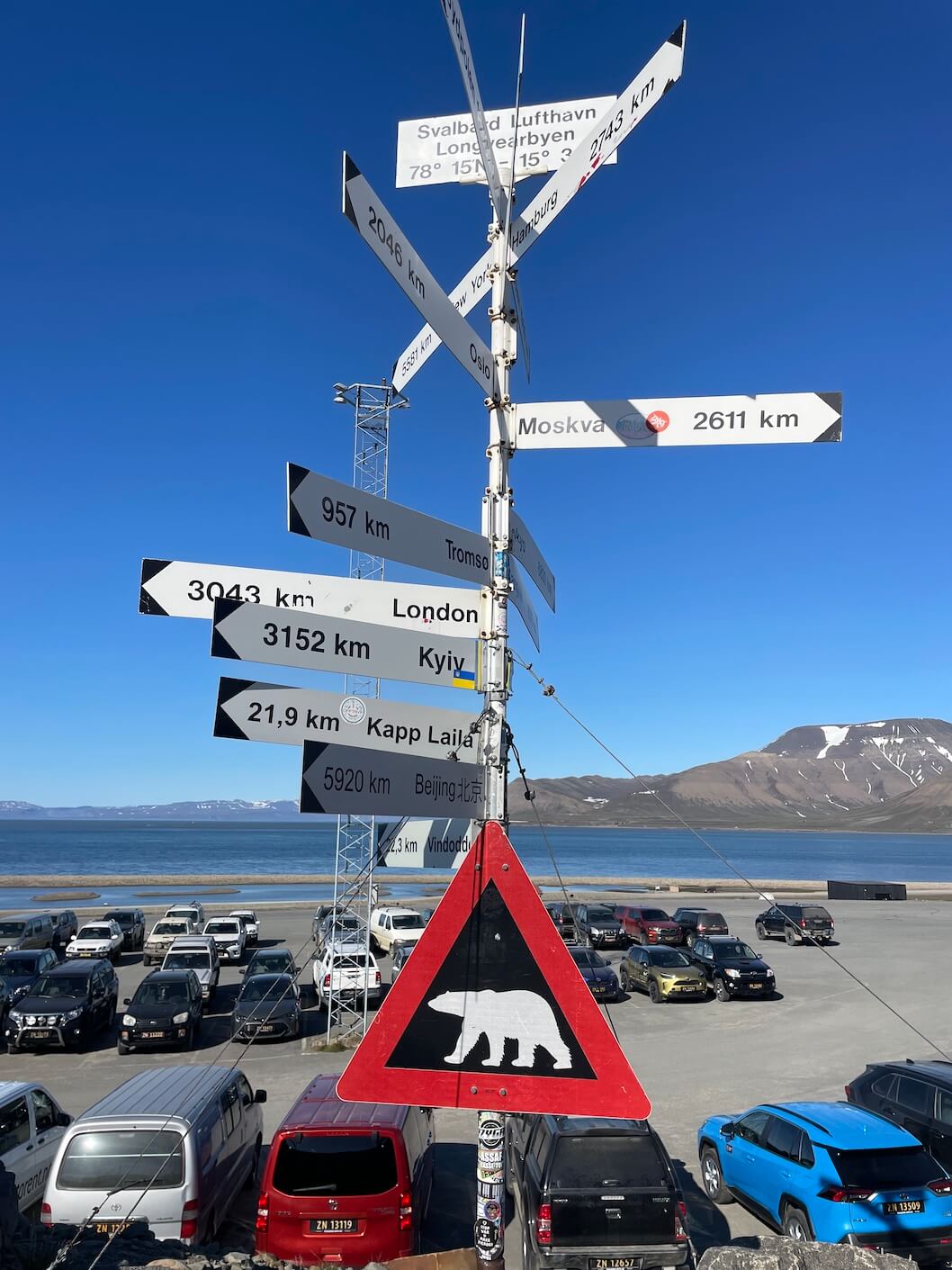
The sign outside Longyearbyen airport shows how far you might have travelled – and check out those blue skies!
My taxi driver kindly indulged my need to be photographed next to the M*A*S*H-style signpost showing that London was 3,043km away and then drove me into town, informing me among other details that today was the hottest day in Svalbard.
‘Hottest day this year?’ I asked. ‘No, the hottest day in the history of Svalbard,’ he said, which, while validating my decision not to bring my ski jacket with me, was rather bad news for the polar bears.
Staying at Funken Lodge hotel in Svalbard
I was staying at Funken Lodge which is a lovely, boutique style hotel at the southern end of Longyearbyen. I last visited here in February 2018 when the hotel opened and I was delighted to be back, as it’s got a great atmosphere – part Scandi-ski lodge, part upmarket hikers’ hostel – and has a great restaurant, excellent bar and great views across town and the vast waters of Isfjorden on whose shores Longyearbyen is located.
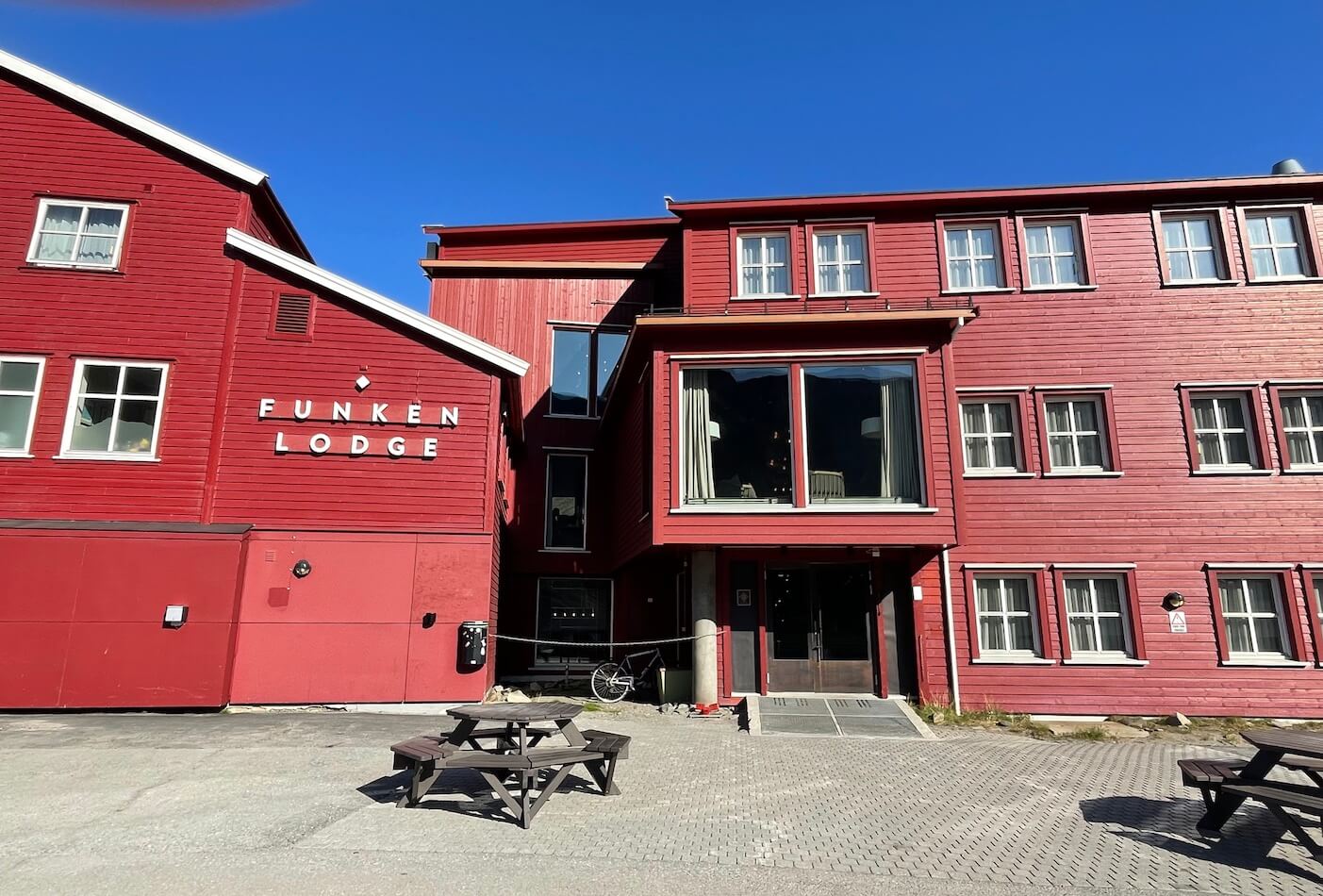
Funken Lodge is an chic, boutique-style hotel on the edge of Longyearbyen with an excellent restaurant and bar and just a short walk into town
Just two minutes after arriving I had checked in, enjoyed a lovely fresh welcome juice, and was walking into town to see the sights. There’s a frontier town/Northern Exposure vibe to Longyearbyen which is lovely and calming – the air is fresh, the sky is HUGE, everything is clean and there’s the feeling that you’re somewhere really far away from anywhere else.
Exploring Longyearbyen
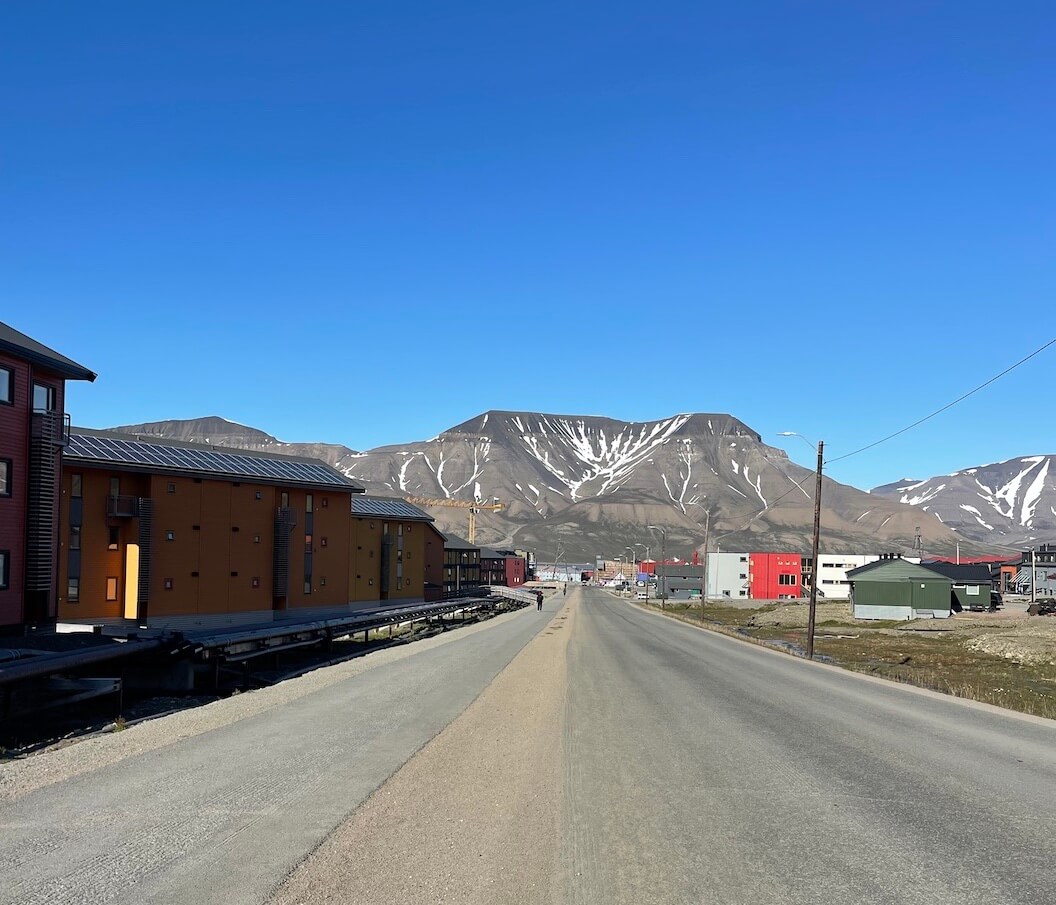
The main street in Longyearbyen – everything is within walking distance. If you venture outside town – which you wouldn’t do as a visitor on your own without a guide – you have to be armed with a rifle and a flare gun in case of polar bears
I walked past rows of neat, brightly-coloured wooden houses to the centre of town which is a pedestrianised area containing shops and bars including a vast, incredibly well-stocked supermarket which sells everything from food and toiletries to camera equipment, furniture, toys (including polar bears) and house plants.
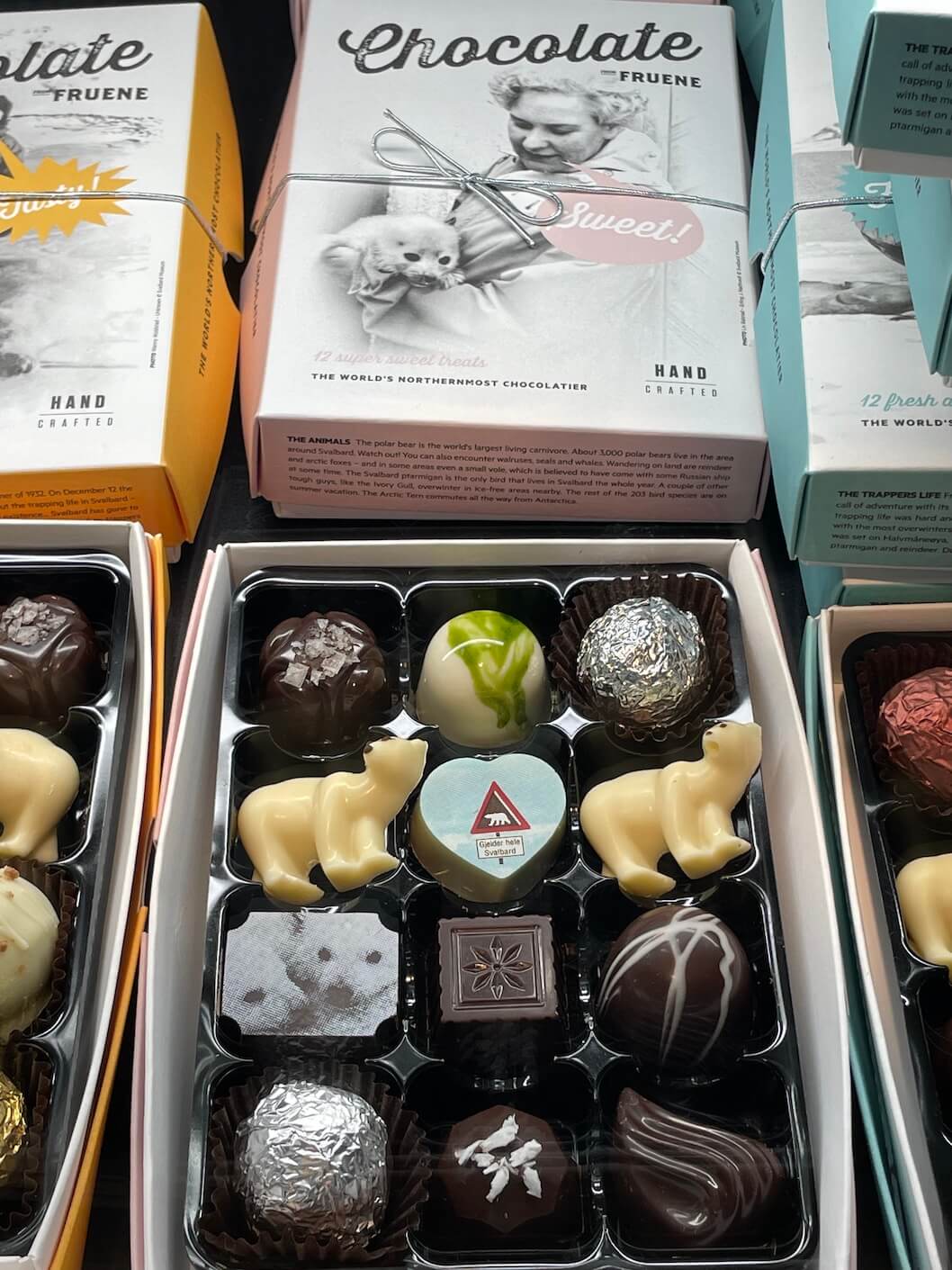
Some rather fancy polar bear chocolates on sale in Svalbard
There’s also a visitors’ centre, several museums, a church and cinema/art gallery and various notices testify to it being a pretty sociable kind of place, such as the ‘First Friday Coffee Club’ for people who enjoy photography, literature and designs. As well as attracting tourists drawn by the excellent outdoor activities, Longyearbyen attracts artists, photographers and other creative types, lured by the sense of calm, wilderness and down-to-earth frontier vibe.
Much to my surprise the weather was warm enough in the early evening to sit out in the sunshine without a coat, so I found a promising-looking bar and spent a very pleasant hour chatting to the people next to me who turned out to work for Hurtigruten Svalbard and were off sailing around the archipelago for the next few days on the MS Nordstjernen, a classic Hurtigruten ship which takes passengers deeper into the islands of Svalbard. Longyearbyen certainly seems the kind of place where everyone talks to everyone else.
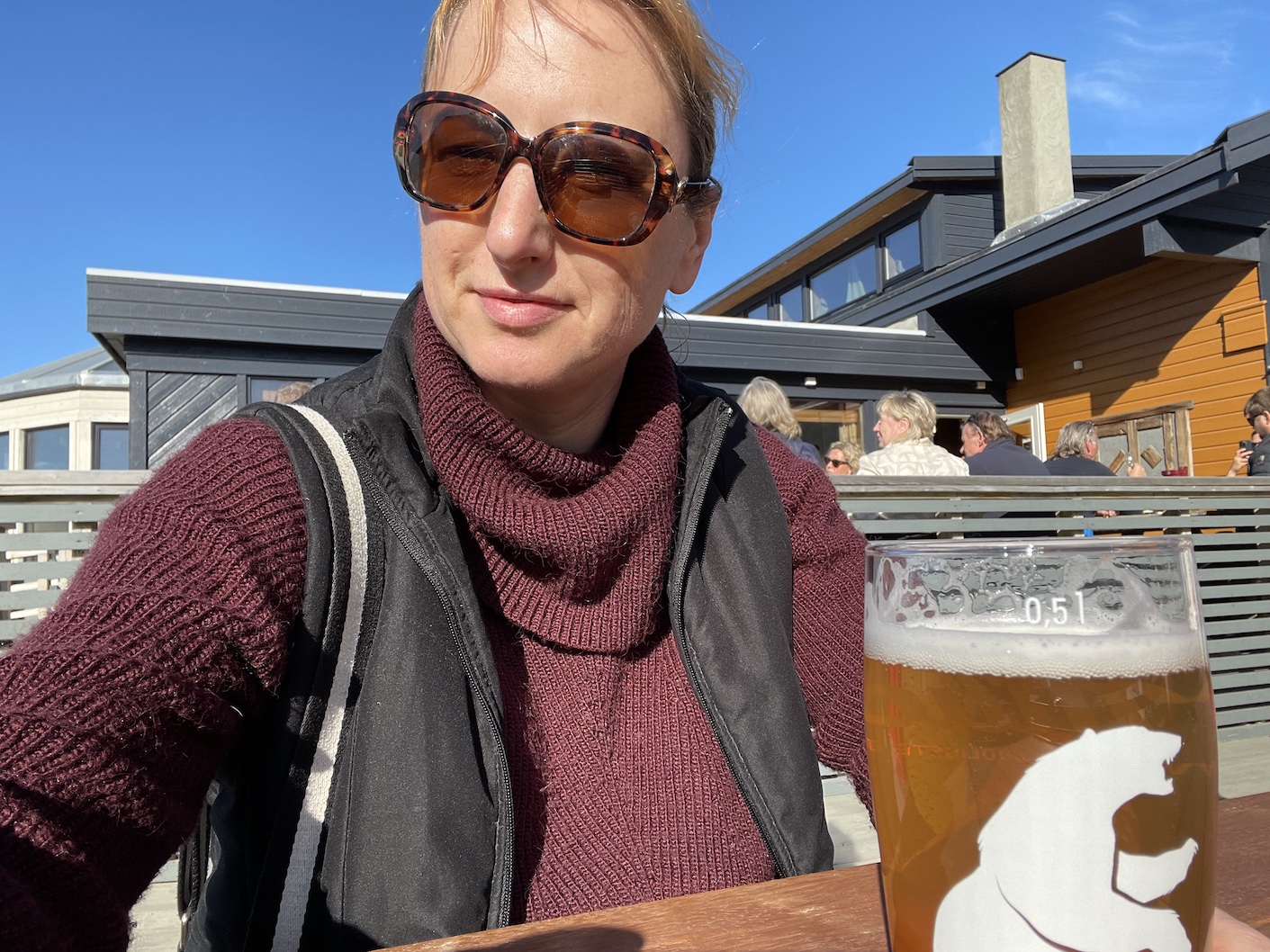
An unexpected treat was sitting outside in the warm afternoon sunshine with a cold beer – this pint is from Mack, from Tromso – almost (but not quite) the most northerly brewery in the world
They helpfully told me that, having bought a beer from the smart-looking Kroa bar and restaurant (which had seats on decking outside but which had no space to sit) I was going to be in trouble for sitting in the adjacent decking which actually belonged to the adjacent Polfareren hotel. I got round this potential issue by sensibly buying a beer from them too, satisfying everyone, not least the Kroa waiter who did indeed later come over to tell me I was sitting in the wrong place. By then I was drinking my Polfareren beer and was allowed to stay (phew!), but with no signs marking the different seating areas, they presumably have to tell customers this a lot!
Dinner at Funken Lodge
It was time to meet my fellow travel writers for dinner back at Funken Lodge and after some welcome cocktails we got stuck into some really excellent food. I started with King Crab and Lobster Ravioli which was delicious, one of the best dishes I tasted all trip (amid strong competition) and then had Svalbard cod with fennel and mussels which was also excellent, if not as visually impressive as one of our group’s King Crab which looked suitably alien-like and tasted marvellous.
Being high in the Arctic Circle meant we were in Land of the Midnight Sun territory and the clear blue skies meant that the sun was blazing strongly, even at midnight, which made falling asleep or even feeling sleepy, fairly unlikely. The curtains in my bedroom were thick but not blackout style, and it was so warm sleeping would have been difficult anyway, but wearing two eye-masks certainly helped – as did the impromptu Aquavit tasting before bed!
Day 2 in Svalbard: Quad-biking and the world’s most northern pub
Sleeping in the Arctic summer when the sun is blazing 24 hours a day isn’t easy, and it was either that or the several shots of aquavit which gave me a rather sleepless first night in Svalbard. Thankfully the Funken Lodge does great coffee so I woke up with the help of several double espressos and an epic breakfast buffet. On offer were made-to-order omelettes alongside scrambled eggs, crispy bacon, a selection of cheese, fruit, yoghurt and salmon done every which way and an excellent range of bread including my new favourite, the Norwegian seeded crispbread, knekkebrod.
On the schedule for the day was dog-sledding which sounded great fun – it’s done on wheels in the summertime instead of ice – but just as we were putting our boots on outside the lodge the news came – it was too hot for the dogs! This is fairly unprecedented for the Arctic and another sign of the extreme weather conditions which are becoming more common across the globe, but as we were shedding layers ourselves in the Svalbard sunshine we could totally understand why it wouldn’t be a great idea for huskies in their thick coats to drag heavy sleds along in these temperatures.
A couple of Plan B ideas were quickly rustled up – thankfully there are lots of outdoor activities taking place every day in Svalbard, which is why it’s so popular in adventure tourism – and there were the options of a five-hour hike up the nearby peak and along the ridgeway, or a three-hour quad-biking excursion along the valley. Given the perfect hiking conditions – clear skies and visibility for miles – it was a tough call, but the word came through that the hiking was fully booked so it was quad-biking for all – no complaints here.
As it didn’t start until the afternoon there was ample time to walk down to the shore, soak up the views, admire the various fishing cottages and boats dotted around, and to not get in the way of any nesting Arctic terns who aren’t shy about letting you know when you’ve unwittingly encroached into their territory. One such bird swooped at us when we tried one path to the water’s edge so we immediately backed off and chose a different route and it was extremely peaceful hearing the waves lap against the stony shore of Adventfjorden.
Lunch at the world’s most northerly pub
As befits a town so far north that almost everything is the ‘northernmost X in the world – the northernmost hotel, the northernmost bank etc, we had lunch at the northernmost pub in the world, Barentz gastropub and ate reindeer stew – the world’s northernmost reindeer stew of course – which was utterly delicious. (They also do a great range of pizzas which looked inviting – I will have to try those on my next visit).
ATV Safari across Svalbard
After a speedy lunch there was just time to dash back to the Funken Lodge to change for quad-biking or the ‘ATV Safari’ as it was officially called. Run by Hurtigruten Svalbard, the tour was three hours in total – although some of that was taken up by the safety briefing, instruction and climbing into our vast, bulky biking suits plus helmets, gloves, goggles and balaclavas.
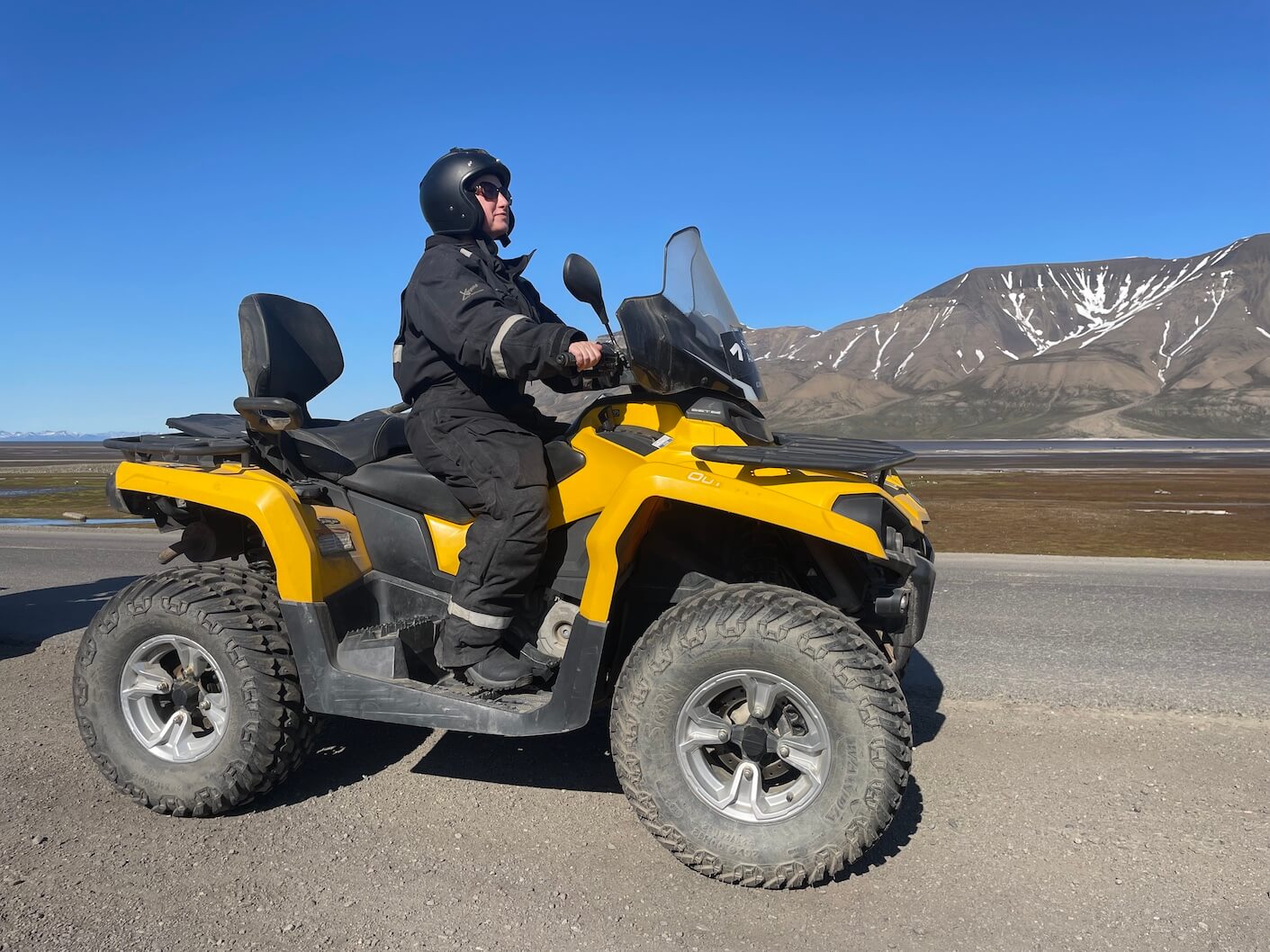
It was pretty hot on our ATV safari – here’s me wearing the full kit (except the gloves!) in the blazing sunshine
It’s almost impossible to convey the feeling of sheer space which the landscape in Svalbard offers in spades, the vast flat valley floor encircled on all sides by jagged, snowy peaks which gave this island the name of Spitsbergen, meaning ‘pointed mountains’. The whole Svalbard archipelago used to be called Spitsbergen, but that name now signifies only the largest island in the group, the only permanently populated island.
We raced along the straight flat road, engines roaring, but as befits newcomers to Svalbard, had to make a stop at the famous ‘Gjelder hele Svalbard’ polar bear warning sign: ‘Over all of Svalbard.’
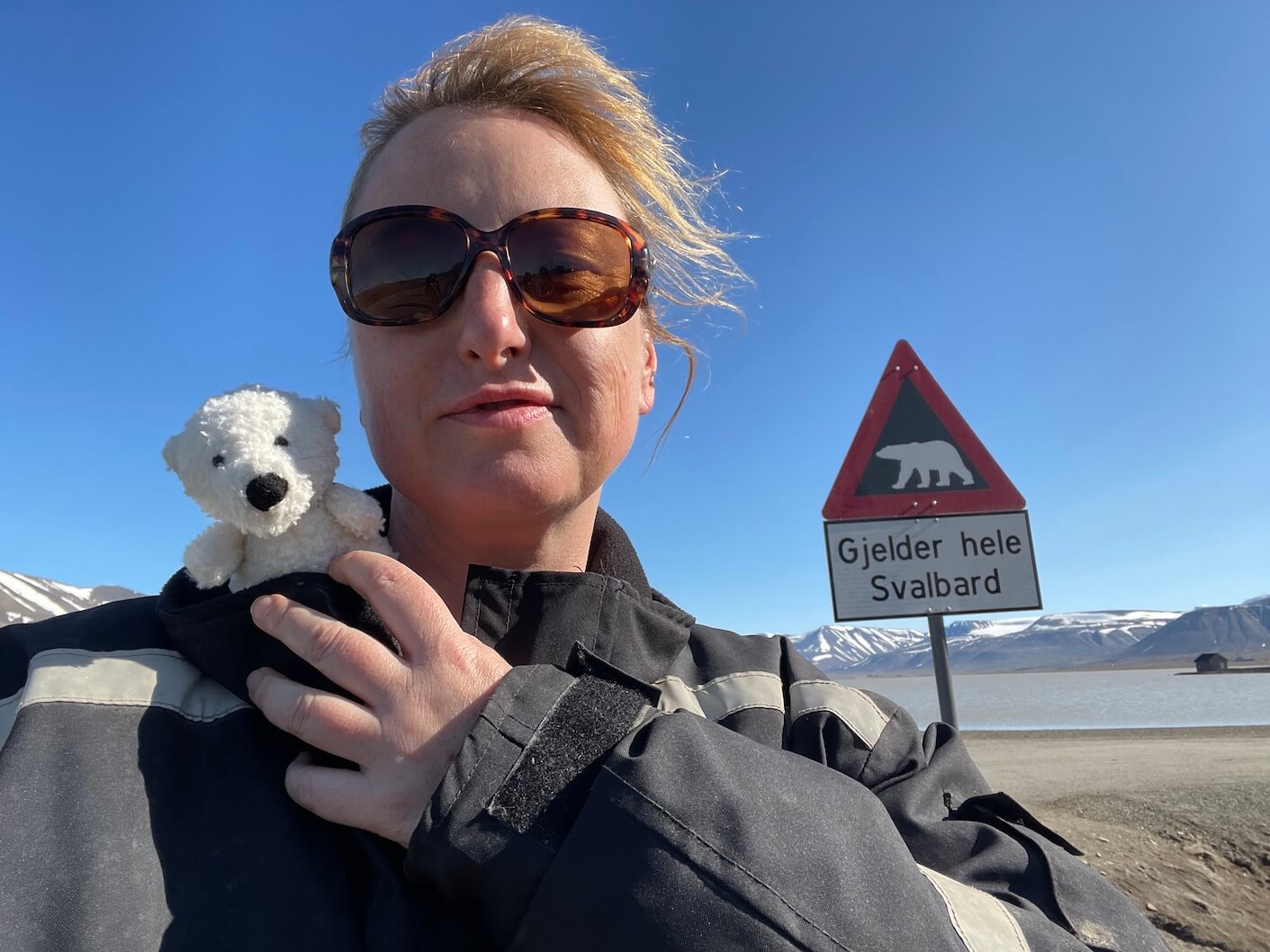
It was hard to resist a quick photo shoot here – especially as I’d brought a little stowaway along with me
As there were no actual polar bears in sight, we had a lengthy photo session before heading off once again, past the old coal mines whose workings are still plainly visible (one mine, mine number 7 is still operational but is scheduled to close sometime this year) up to the lookout point at the end of the road near Breinosa, where the road starts to climb up into the mountains.
Our guides, Andrea and Vilde, were fascinating in telling us about life on Svalbard. Our guide Vilde came to Svalbard to study hunting and the outdoors, and told us in great detail about a recent day-long seal hunt, where she and her friends skinned and stripped the seal on the ice as it was too heavy to take away, keeping a close lookout for polar bears as they did so, or her joy of getting a treasured ticket to hunt and kill a reindeer that year. With only 300 tickets available and a population of 2,500, tickets are highly sought after and will stock a freezer for the coming winter months.
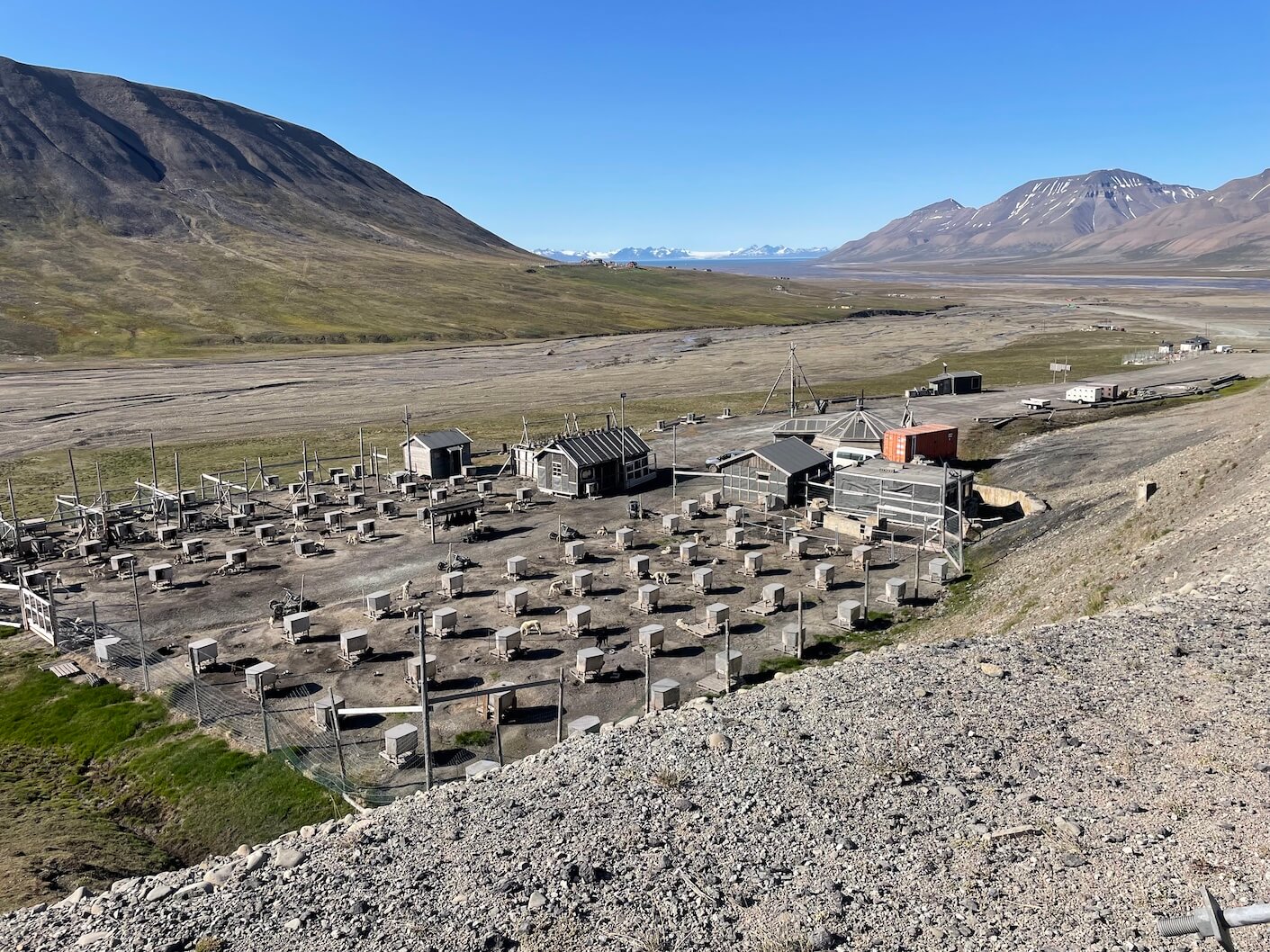
We drove to the end of the valley to Green Dog huskies which has dozens of dogs in individual kennels. It was too hot to go dog-sledding but we thought we’d say hello anyway
We also saw the sight of Norway’s deadliest plane crash which killed 141 passengers and crew in 1996 due to navigational errors, and on a more cheerful note, met the huskies of Green Dog. There are hundreds of huskies on Svalbard, some used for transport (there are no roads across much of the islands, so the only way to travel is often by boat, snowmobile or dogsled) and many for adventure tourism. I was lucky to have travelled by dogsled one Svalbard winter to stay the night in an expedition lodge, and it’s quite the experience – the sounds of the dogs yowling with over-excitement as they were wrestled into their harnesses, and then the total silence as we got going over the snowy wastes, each dog working hard in perfect unison with its colleagues – but this time it was more of a social visit.
The huskies are extremely tactile and love getting hugs from visitors (we were warned about the three dogs who love hugs so much they really don’t want to let go) and with their big hairy coats I could well see why they would be unsuited to racing along in 17 degree sunshine.
It was a packed schedule today: just 15 minutes after getting back from Funken Lodge we had to leave for a Champagne tasting and 14-course tasting menu at Huset restaurant, home of fine-dining in Svalbard. It was a bit of a rush to change from quad-bikes and husky-mode to suitably smart attire but we managed it and it was a delightful gear change.
14 course tasting menu at Huset A catamaran cruise on MS Bard
Huset – the name simply means ‘House’ – was built in the 1950s for miners and over the years the building has been a store, post office, school, bistro – anything to serve the local community. In 2022 Hurtigruten Svalbard turned it into a fine-dining restaurant which, considering we are in one the world’s most remote destinations where almost all the food has to be flown or shipped in, is quite the challenge.
From the Beer and Seaweed sourdough with peppery butter and the reindeer charcuterie to the petits fours served on a blue iceberg, the meal was a feast for the eyes as well as the tastebuds, with the stand-out dishes for me being the Arctic Sea Urchin and fermented honey soup and the Arctic Saint-Jacques scallop, although special mention must be made for the cured Svalbard seal – a first for me.
After such an epic blowout, some of us decided to walk the short distance back to the hotel and were rewarded with the sight of a reindeer placidly grazing outside. It was past midnight and the sun was still blazing strongly – sunglasses were a must – so it was the perfect opportunity to strike a few poses – only in Svalbard!
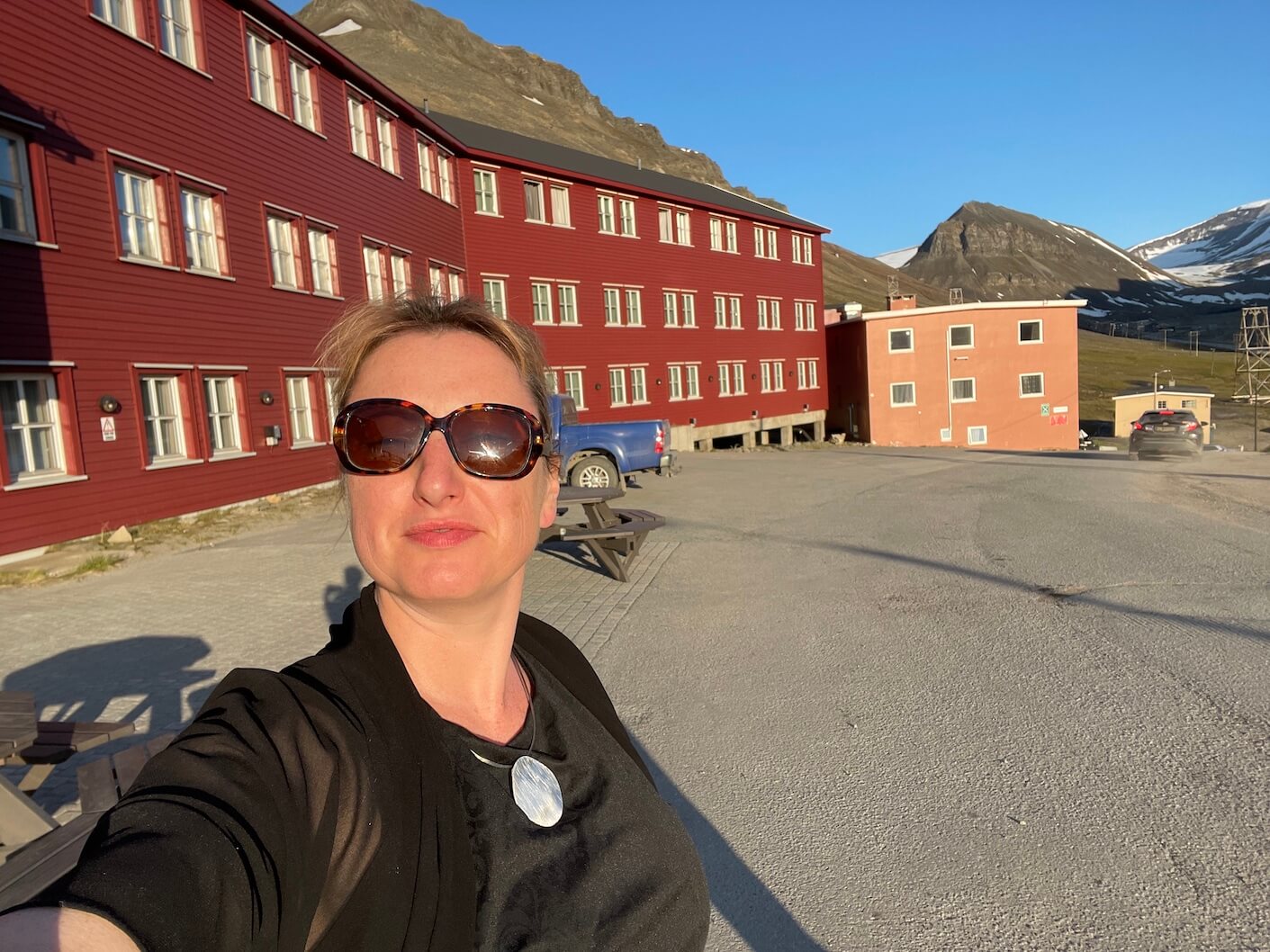
This picture was taken outside Funken Lodge at 12.30am – amazing how brightly the sun shines at night here!
Day 3 in Svalbard – Catamaran cruise on MS Bard and Camp Barentz dinner
Waking up in a land where the sun not only never sets, but it blazes brightly all night, can be disorientating in the extreme. I woke up at 5am with the light blasting through the gaps in the curtains, so it seemed like midday, while it also felt like I hadn’t actually gone to sleep at all.
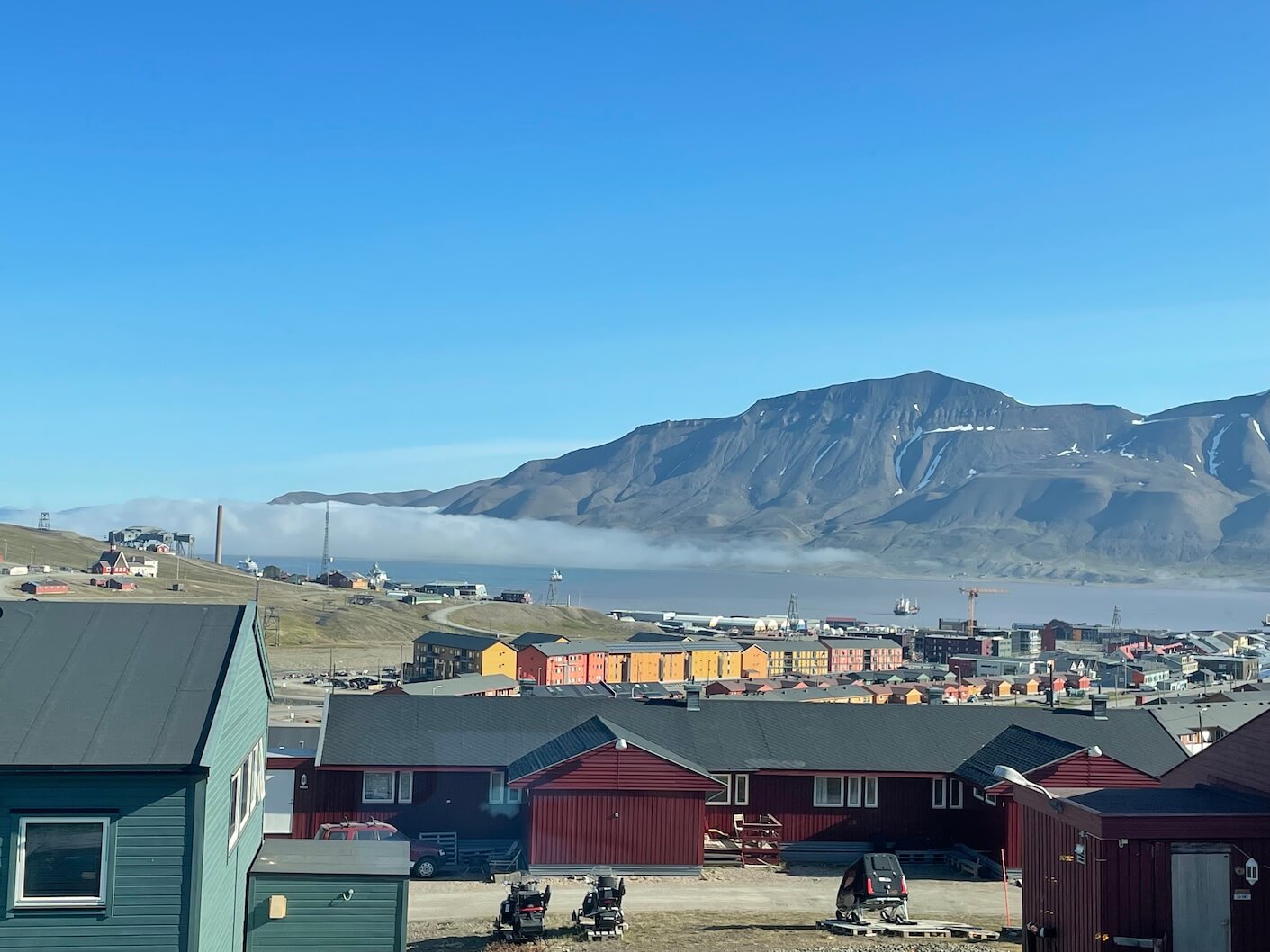
We awoke to low-lying fog in the fjord by Longyearbyen – picture taken from the breakfast room at our hotel, Funken Lodge
A catamaran cruise on MS Bard
Thankfully we had a relatively relaxed start to the day: a short taxi ride to the marina where MS Bard, a hybrid-electric catamaran awaited us. This new, greener way of exploring the fjords of Svalbard was built with recycled and recyclable aluminium and uses electric propulsion when approaching settlements, glaciers and wildlife, meaning it can slide along silently and use less diesel, which it uses alongside electric at faster speeds.
The ship is well equipped with a bar serving drinks and snacks – we were served some warming soup and crispbread for lunch – as well a binoculars, maps, toilets and the crew were happy to share their knowledge on history and local wildlife as we sailed along.
There were three decks, with ample seating for all, and there were large windows everywhere so you could sit outside and soak up the sunshine, or retreat inside if it got too windy without missing out on the views.
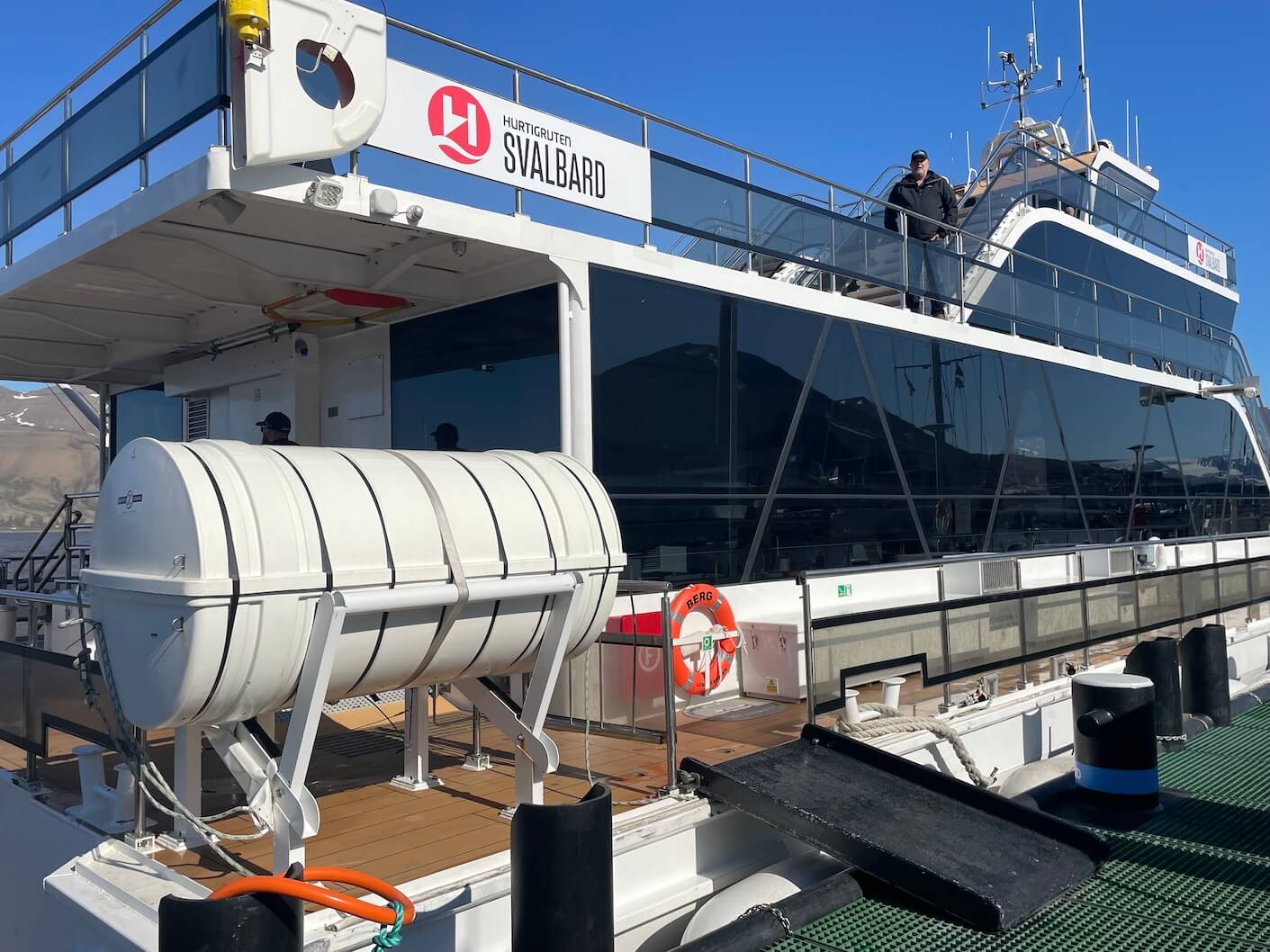
Our catamaran, MS Bard, is hybrid-electric which makes it a greener way to explore the fjords of Svalbard
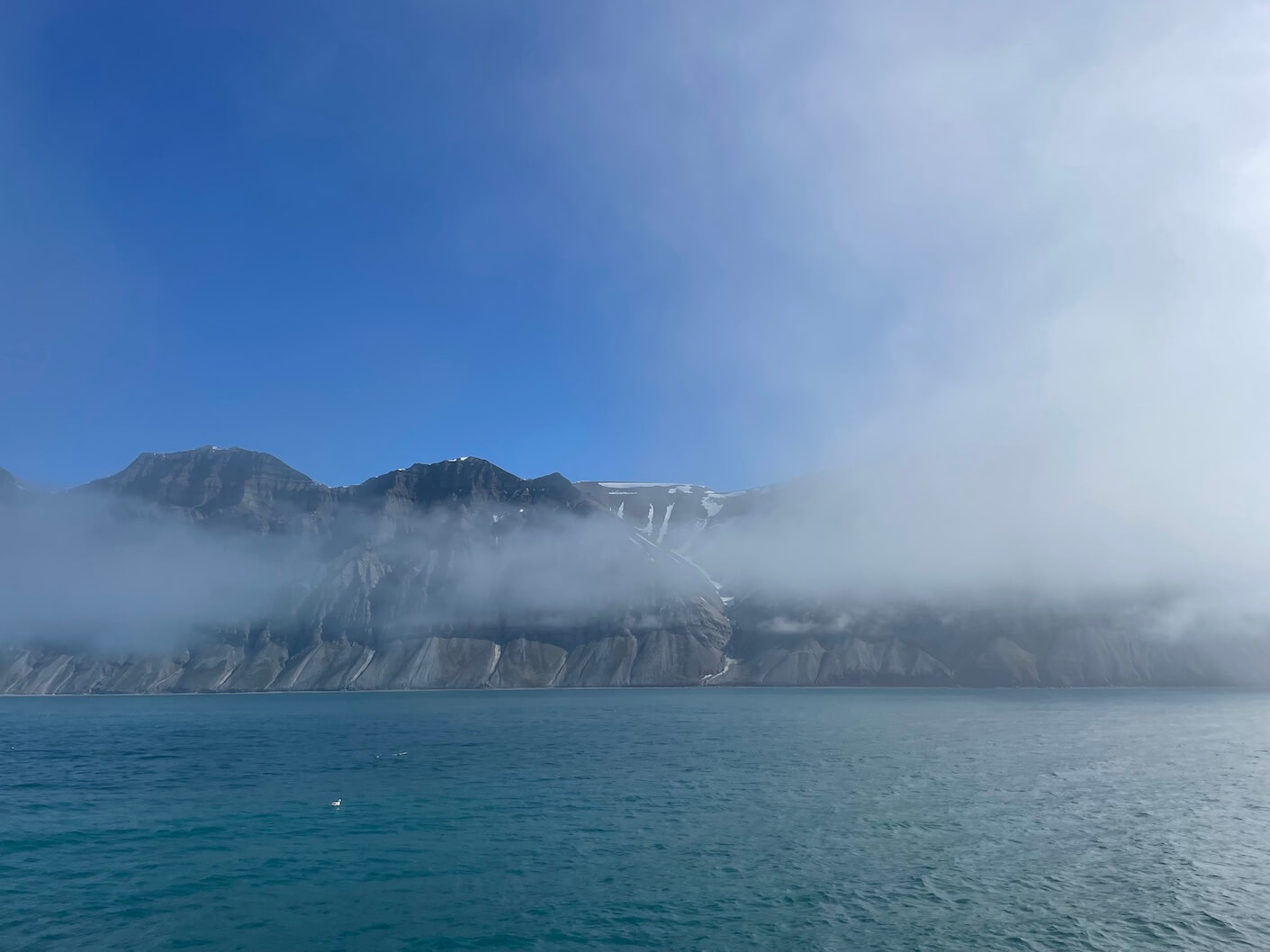
Standing on deck as we glided through the mists as we returned to Longyearbyen was an eerie but memorable experience
An evening at Willems Cabin – epic tales to go with epic food
A rare few hours of free time saw many of our group catching up on shopping, exploring or sleeping before a night at Willem’s Cabin in Camp Barentz, a ten-minute drive out of Longyearbyen, just below Mine 7. There’s a collection of buildings here, including Barentz Hus, a replica of the cabin that Willem Barentz, the explorer who discovered Svalbard, and Willems Cabin, where we dined.
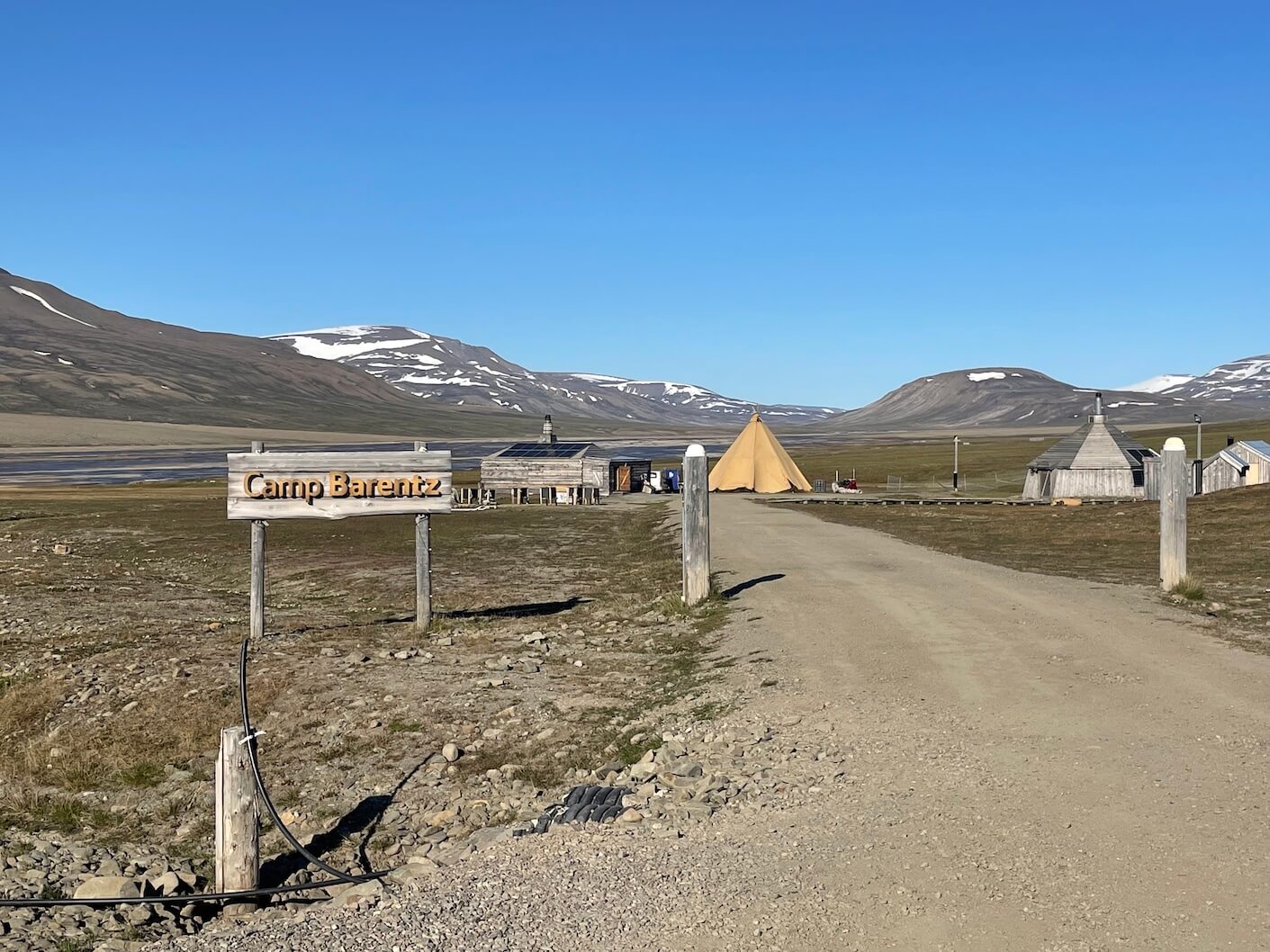
Camp Barentz offers visitors the chance to learn all about the history of Svalbard and its wildlife while soaking up the views along with some great food
With a huge picture window and a wood-burner, this is the perfect venue for soaking up the view and the feeling of remoteness whatever the weather or the season, and we were treated to an impressive Arctic dining experience, with six courses expertly prepared by our private chef Eda, accompanied by excellent wines and stories about Willem Barentz and the discovery of Svalbard from our guide and host, Sølvi.
With dishes such as reindeer heart, Svalbard cod and ringed seal, it was a dinner full of locally-sourced luxuries and the perfect way to spend our last evening on Svalbard.
Day 4 in Svalbard – Crossing the fjords on a RIB and boarding MS Trollfjord
It’s fair to say that some of our group were not expecting our morning activity – a RIB (rigid inflatable boat) ride across the Isfjorden in search of walruses and glaciers – to be quite as energetic as it was.
The more prepared of us had worn layers and packed gloves as instructed, but even the detailed pre-ride talk by our guide, the genial Scottish-born Mats McCombe, didn’t seemed to alert them that this trip was going to be rather more hard-core than the relatively sedate catamaran trip of the previous day.
A RIB boat ride across the Isfjorden
Once we’d wrestled ourselves into our all-in-one floating suits and lifejackets – and, crucially for a four-hour round trip without facilities, visited the loos for a final time – Mats drove us out to the marina next to yesterday’s vessel, MS Bard. This time we were destined for a 12-person RIB, with jockey-style seating and exposed to the elements.
We felt like astronauts dressed in our suits and adopted a mock-heroic, moon-walking style as we made for our boat, but all bravado disappeared once we were on the open water and Mats picked up speed.
Instantly any clothing which hadn’t been zipped up, tied on or firmly fastened let in water and the bracing wind as we bounced repeatedly over the stiff waves, landing on the other side with a spine-compressing crash.
I quickly discovered that I could brace myself against the worst of the landings by semi-standing up (I’m short enough for this not to be a problem for the pilot) and once I had insulated myself against the elements by hiding as much of me as possible in my weather-proof suit, I thoroughly enjoyed our high speed dash across the vast, open space of Isfjorden in the heart of Svalbard. Not so much the gloveless passengers behind me, one of whom clearly thought he was making his last trip on earth. Amid cries of ‘Help!’ and ‘I’m bouncing on my balls, here!’ and conversations with ex-girlfriends about who knows what, after half an hour of so he managed to get Mats to stop, requesting we have a quick discussion about turning back.
‘Turning back?’ exclaimed the woman next to me. ‘I was going to get him to put his foot down!’ The others were of a similar opinion, and with the numbers stacked against him, he agreed to go on. I would have been incredibly disappointed not to make it across to the other side, especially given how far we’d already come, and while it was a longer and far choppier crossing than I’d expected, it was exactly the kind of Svalbard adventure I’d been hoping for.
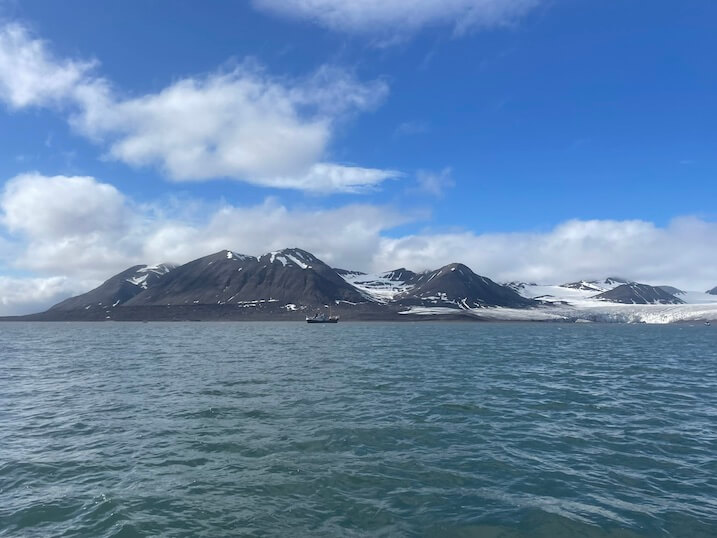
We finally made it across to the other side and the Nansen glacier, named after Norwegian explorer Fridtjof Nansen
Up close with walruses
Another 45 minutes or so and we’d made it all the way across the fjord to the Nansen glacier, where to our delight a colony of four, fat walruses were basking in the Arctic sunshine, with another three playing in the water in front of them.
Rather unbelievably, a group of tourists were walking towards them, far nearer than the regulations say you should, and a furious Mats took pictures of the group and their ship to lodge a complaint. Not only does it disturb wildlife, but it’s potentially a very risky thing to do – an adult walrus can weigh between 800-1,000 kg and can move fast in short bursts – I was certainly happy to keep my distance.
After watching the walruses for a while, we then travelled a short distance around the promontory to the Borebreen glacier, which we had all to ourselves. It was too steep a bank for us to go on shore, but that was no problem as Mats took us across the ice-filled sea to the front of the glacier, which was a fascinating sight.
As there’s no sense of scale out here, no trees or landmarks to help judge distances, I was amazed to hear that we were no closer than 800m to the glacier, when it looked so near. As glaciers can calve without warning, leading to dangerous waves or flying ice, it’s sensible to keep one’s distance.
Glacial silence – almost
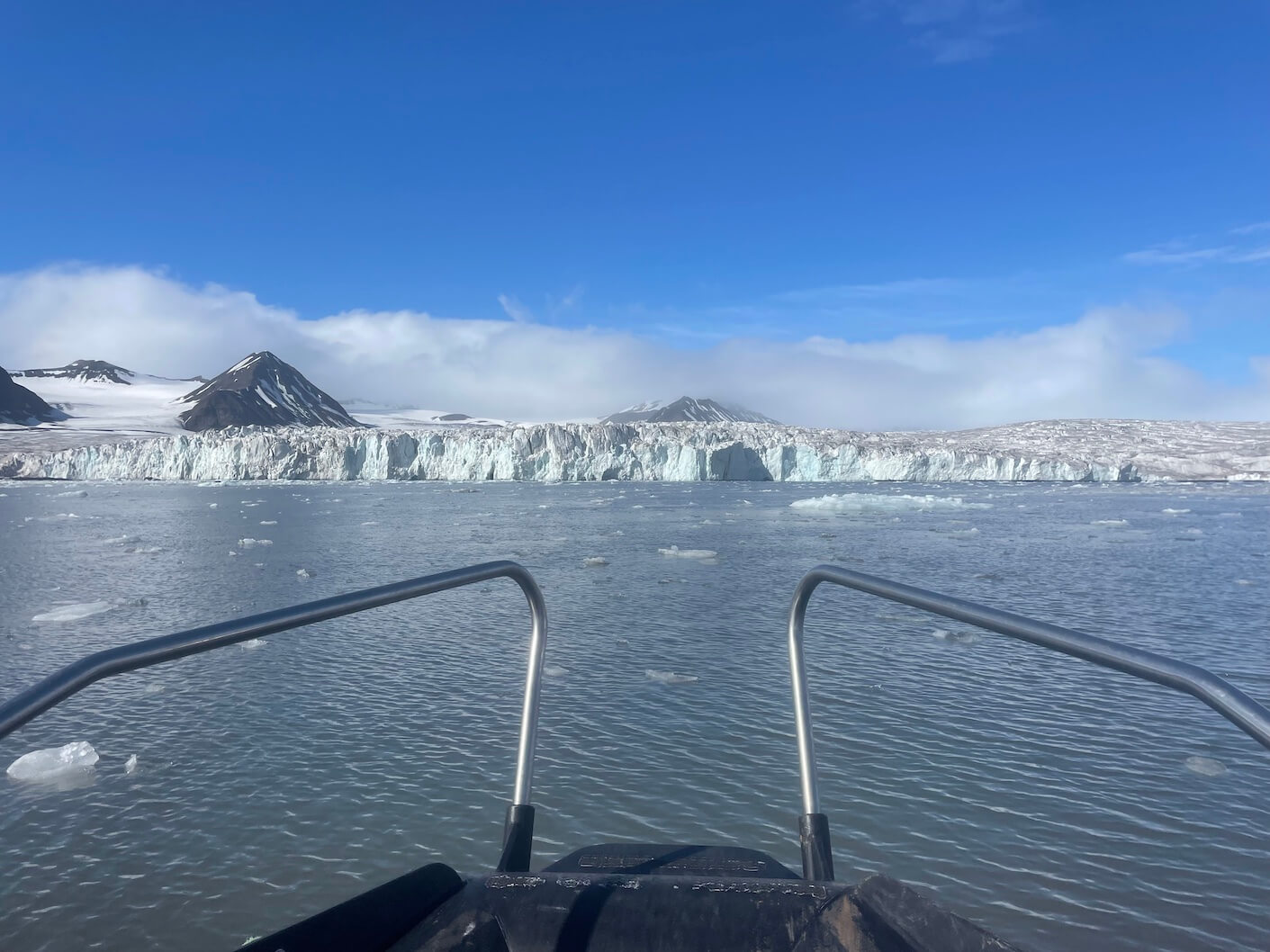
Watching – and listening to – this blue-white river of ice under the open skies is a memorable experience
We floated along noiselessly, gazing at the bluey-white whipped-ice-cream of the glacier, and the only sounds we could hear were dull thuds as floating ice knocked against the boat, and the occasional crash of the glacier itself as great chunks of ice fell into the water or, unseen by us, into a hidden cave.
Apart from that, it was pure silence under the vast skies: awe-inspiring, majestic silence….
‘MUM! I’m at a glacier! LOOK! A glacier!’
One of my fellow passengers has decided that this moment was the perfect time to involve the family, at high volume on a very small boat. We all cursed her and the annoyingly good mobile phone reception, considering we were in one of the most remote areas on earth, but we could appreciate her wish to share what was a stunning moment.
Once she’d finally said goodbye to her family, we could get back to appreciating the beauty of the glacier, and the unexpected treat of sometimes hearing the ice crash into the sea and then catching a glimpse of the after-effects of the impact, thus allowing us a fighting chance of taking a picture of the moment.
The colder ones on our group were so relieved that we’d stopped bouncing across the open water that they even starter to enjoy themselves, especially when Mats produced a range of packet meals for lunch, the Svalbard stalwart brand ‘Real Turmat’, and, with the addition of hot water from his Thermos, produced Chicken Tikka Masala, Salmon Pasta and Beef Curry – the hero of the hour.
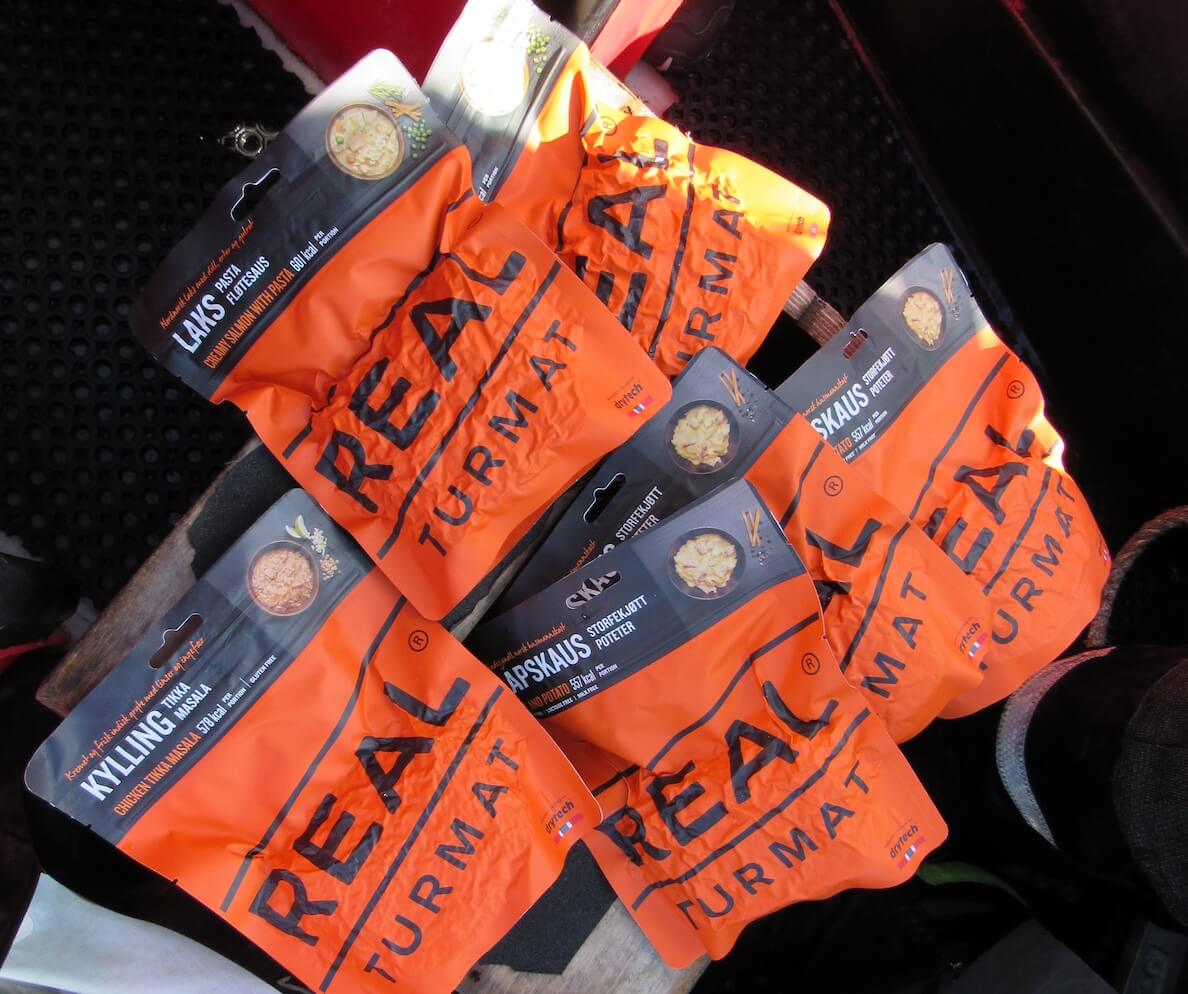
This warms the spirit as well as the body – quality ready meals which are an explorer’s stable diet on Svalbard
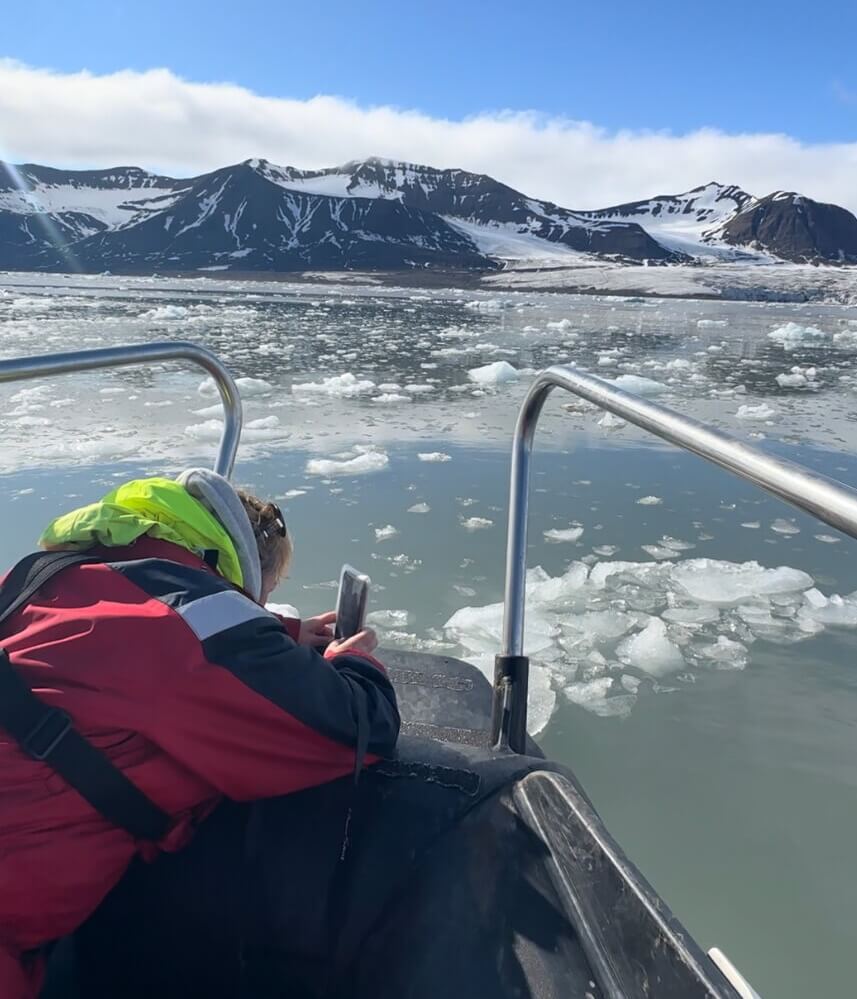
Trying to capture such vastness with an iPhone camera feels almost impossible… but I certainly gave it a try!
The finding of some spare pairs of gloves for those without, and the additional layers found by others, plus more sensible wrapping-up against the elements and a following wind, meant that the ride back to Longyearbyen was much more pleasant. Even so, we were a rather bedraggled group when we arrived back at Funken Lodge. There was just time for a quick change of shoes and a warming drink before we were heading off to our ship, MS Trollfjord. Our journey on the Svalbard Line had really begun.
Day 4 in Svalbard – Exploring Ny-Alesund, one of the most northerly settlements on Earth
Visiting Ny-Alesund
Phones duly set to airport mode before I went to bed the previous night, I set my alarm for 5.45am. This isn’t my usual waking time, but my itinerary had recommended getting up at 6am if I wanted to enjoy some impressive views of Kongsfjord, one of the largest fjords in the area. Its entrance is flanked by two colossal glaciers that regularly deposit ice into the fjord and the area is also a good place to look out for walrus, Arctic fox and Svalbard reindeer as well as the occasional white beluga whale and – that elusive beast of our trip – even a polar bear.
Being on the top deck of the ship at 6am – there isn’t such a thing as ‘dawn’ when the sun never rises or sets – was an interesting experience which can be best summed up as ‘cold and windy.’ The hardy early-risers huddled together for warmth as they hopefully scanned the shores for exotic creatures. This certainly felt more like the Arctic, and of course the wildlife stayed obstinately elusive, but cruising along the shores of the vast fjord into the tiny harbour at Ny-Alesund was quite a sight, guarded as it was by some impressive satellite dishes, making it look like a Bond villain’s secret lair.
While the ship’s crew busied itself with the landing procedures, and presumably unloading useful supplies to the town, we defrosted over hot breakfast and coffee before heading out to explore.
The history of Ny-Alesund
Ny-Alesund and King’s Bay (Kongsfjorden) was first discovered by English whaler Jonas Pool in 1610 but remained untouched until coal mining started in 1916. After many decades of mining and many mining casualties, mining ceased here in 1963 and the site started anew as a research station, measuring everything from solar and cosmic radiation to climate change, the natural world and GPS data.
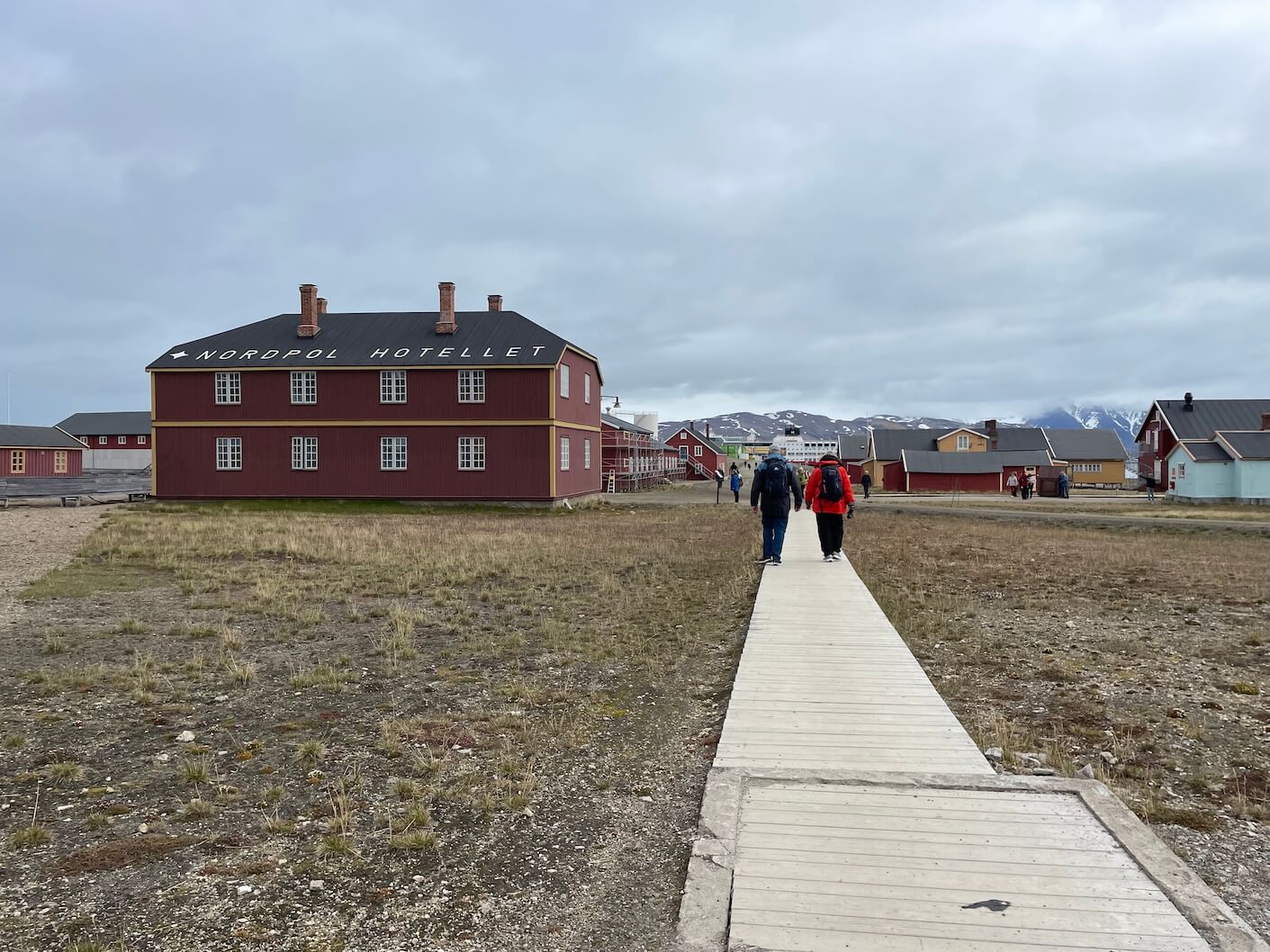
Ny-Alesund has several colourful buildings including a hotel, shop and museum. Visitors must stick to the paths and walkways to avoid disturbing the local wildlife
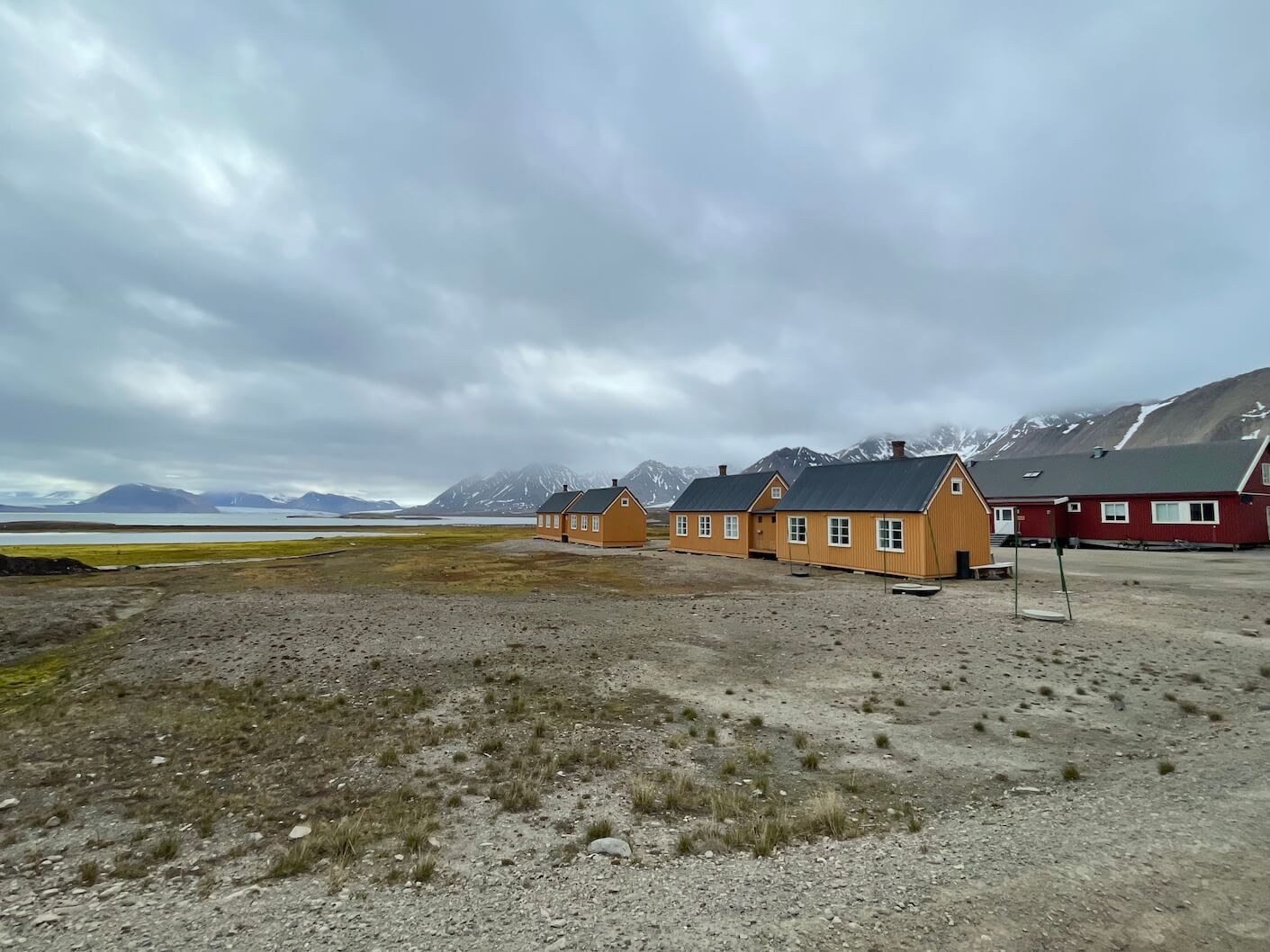
Ny-Alsund is a pretty but small settlement, with around 180 research scientists living here during the summer months
There are about 50 buildings in Ny-Alesund, half of which have been given protected heritage status, and it is home to the world’s most northerly Post Office and most northerly hotel, as well as a shop, museum and research station. Visitors to the town have to stick to known paths to avoid protected wildlife areas – the Arctic Tern can be especially territorial here, and it’s best to turn back rather than risk the pecky wrath of these birds – and I headed first for the shop before wandering inside the research institute and reading the list of recent polar bear sightings in town.
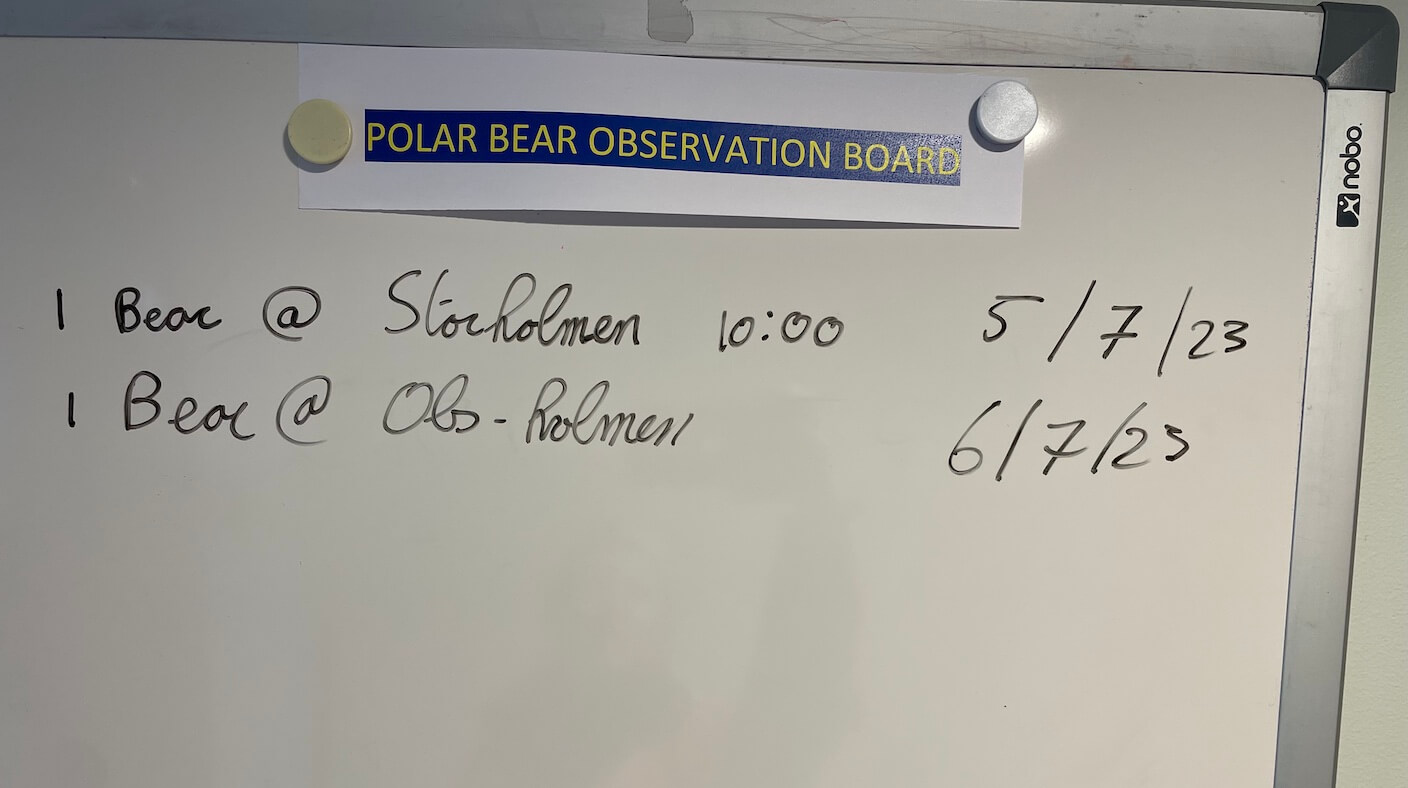
The polar bear observation board at Ny-Alesund
There’s just one chance to step outside the town itself and that’s the short walk – with an armed escort in case of bears – to Amundsen’s Mast, where the famous Norwegian explorer set off to make the first flight over the North Pole on May 11th, 1926, 1,231km away.
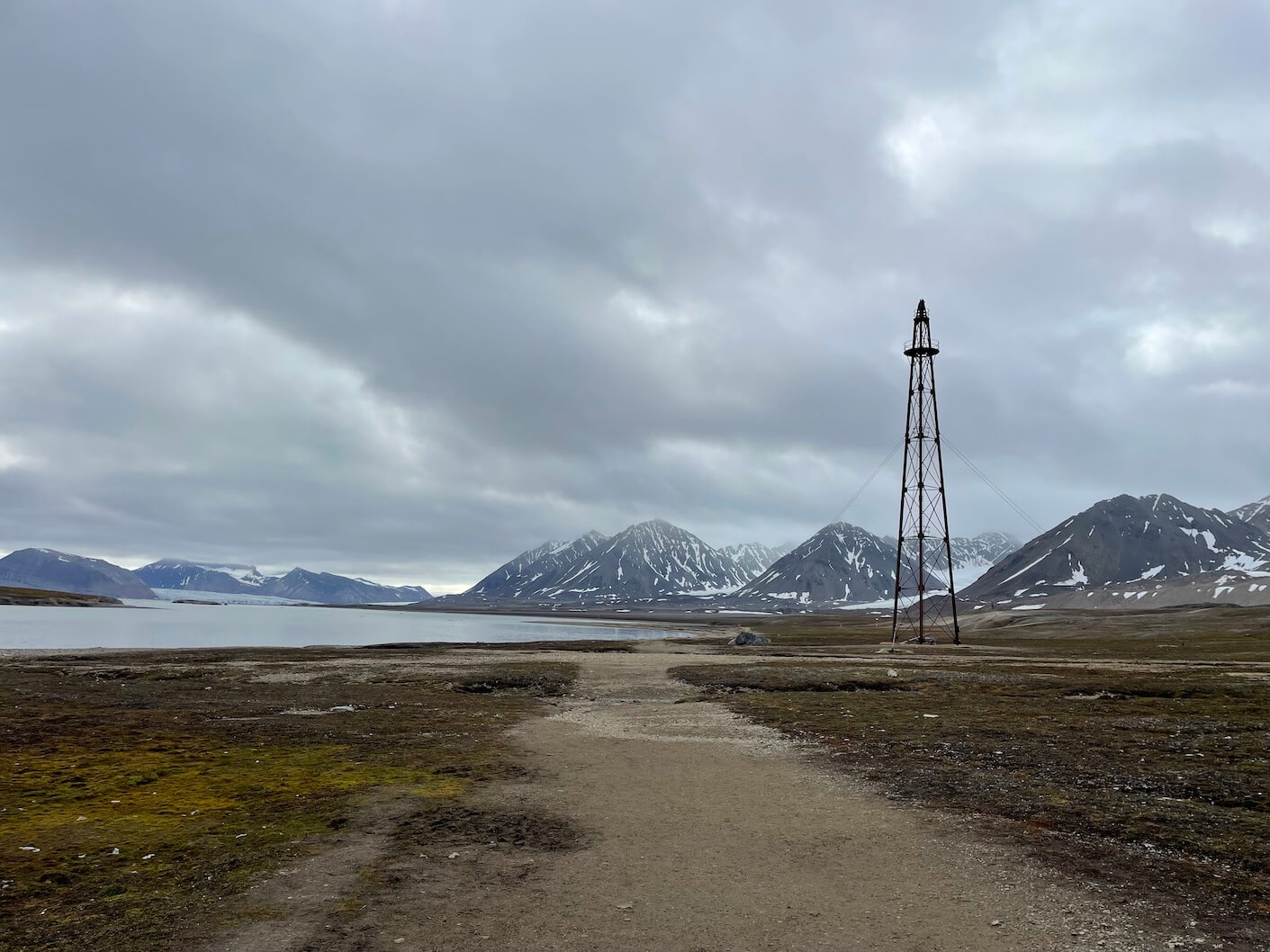
Amundsen’s mast is on the edge of Ny-Alesund and is where the famed Norwegian explorer set off by airship to fly over the North Pole in 1926
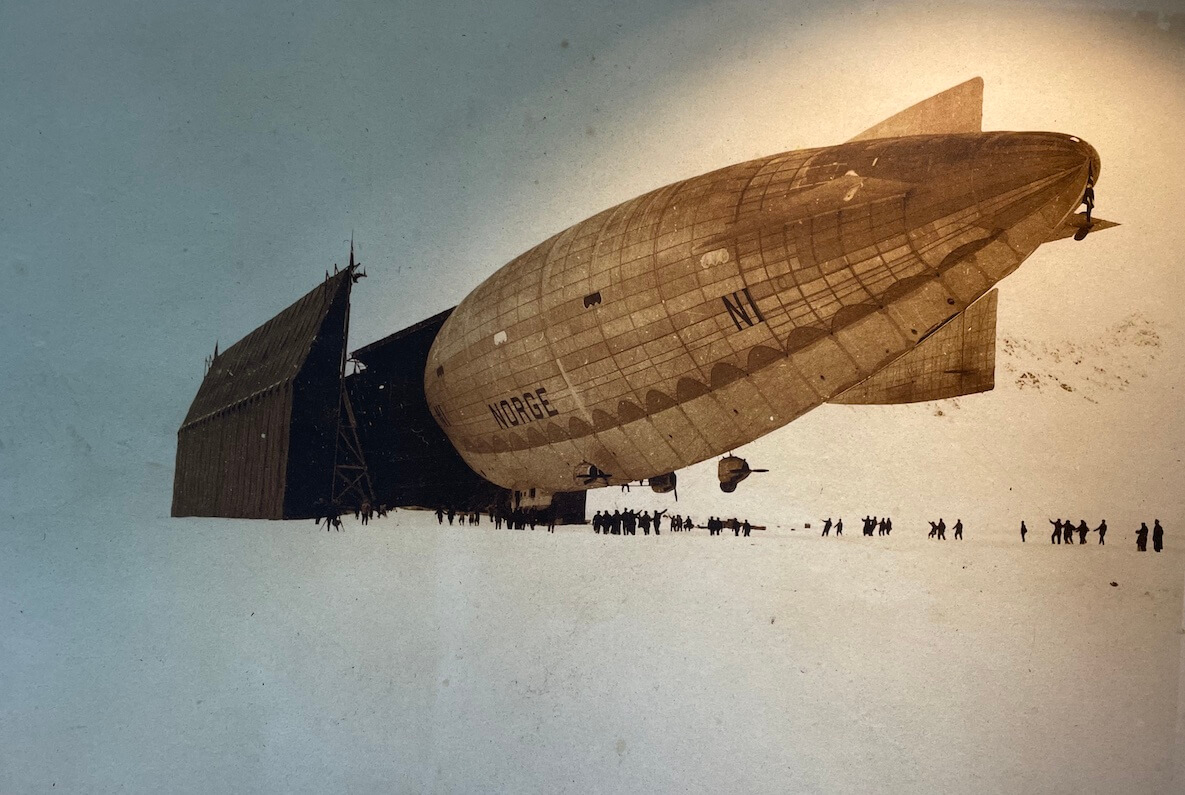
A photograph at the research station shows the enormous airship preparing to take off to the North Pole
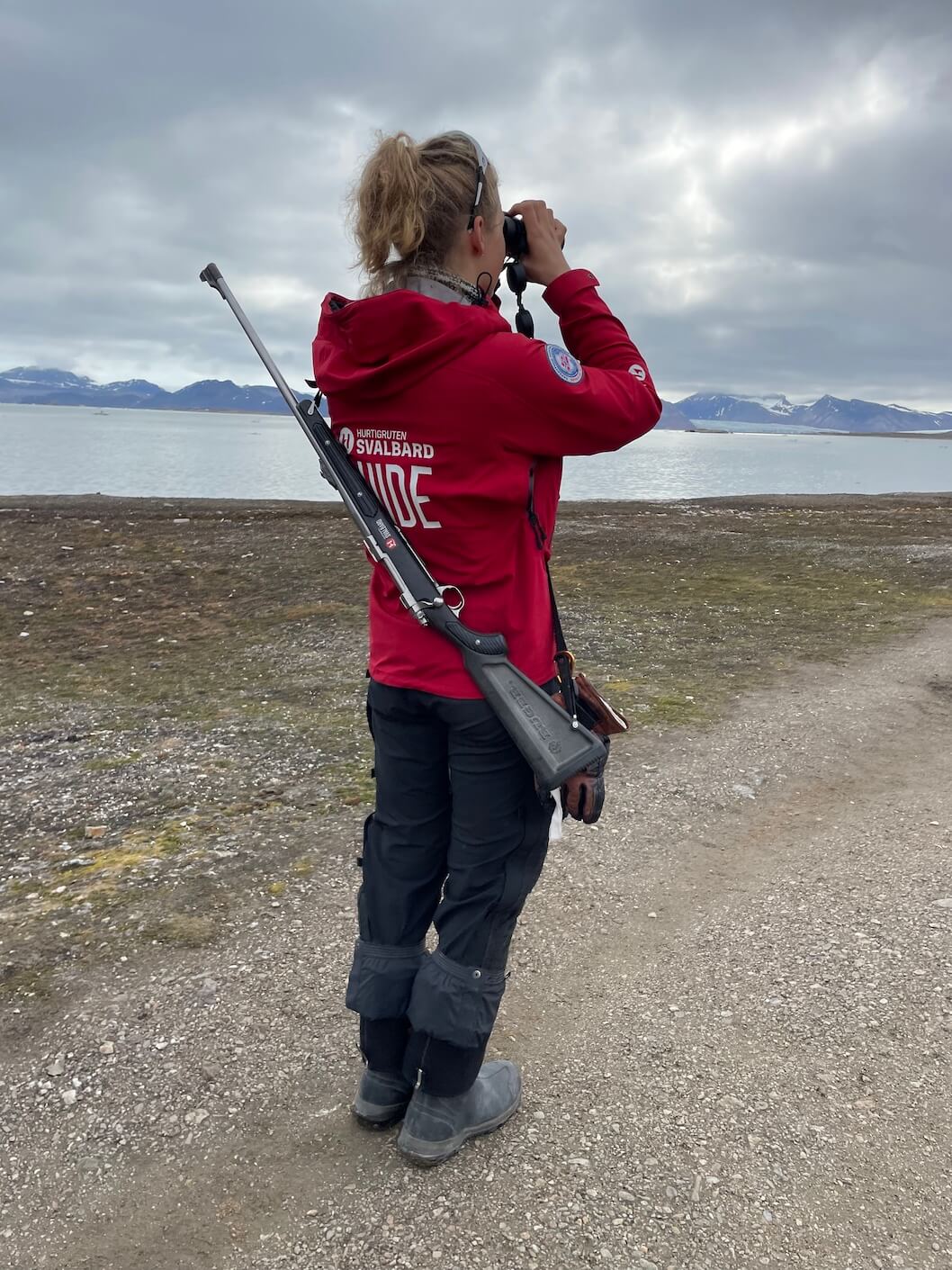
Our armed guard kept an eye out for polar bears as we walked to Amundsen’s mast
There’s a fascinating museum here which has pictures of Amundsen and the massive airship he travelled in, plus information about life in Ny-Alesund past and present. Around 180 people currently live here during the summertime, with 40 people living here all year round. Everyone eats together and relaxes by playing sport, dancing, exploring, painting and there’s a pub which opens once a week.
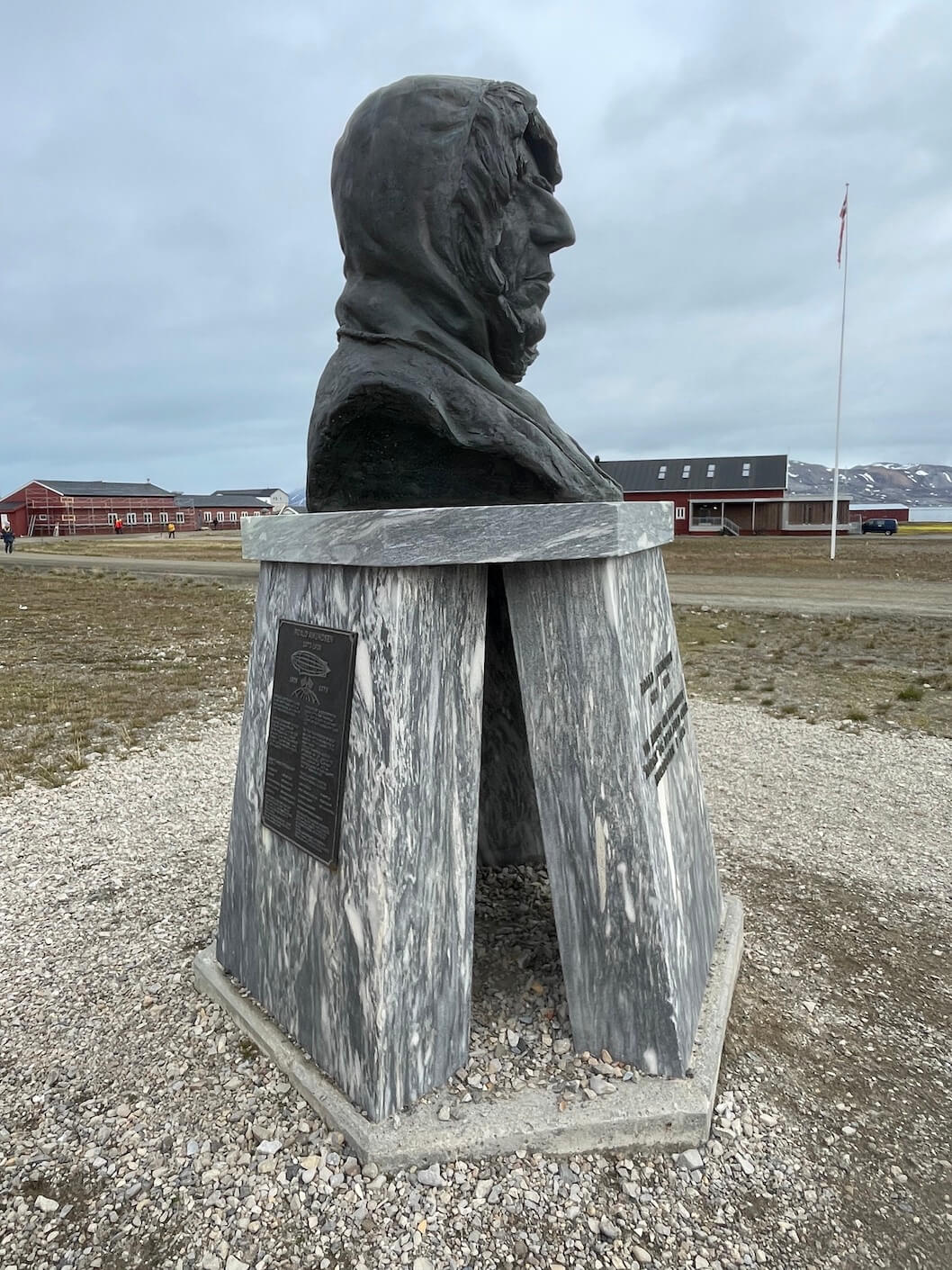
The stature of Norwegian explorer Roald Amundsen in the centre of Ny-Alesund
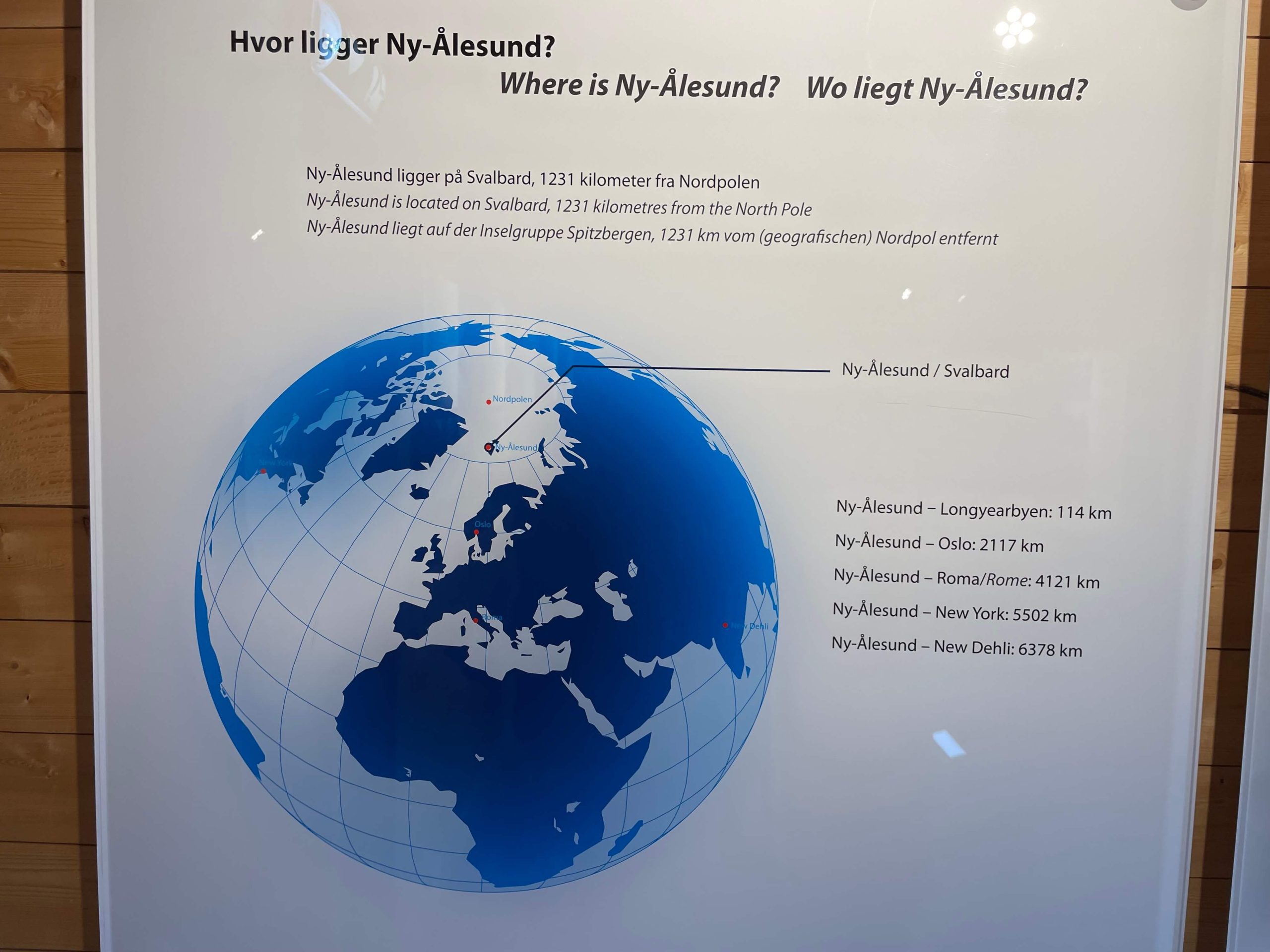
A map showing our location in the museum at Ny-Alesund
Going as far north as I could
Heading back to ship I saw some brave people going for a swim in the icy Arctic waters – I was tempted but just dipping a hand in was enough for me this time – and we watched a seal play in the harbour before heading back onboard. The ship had to head north to leave the fjord before turning south for Norway, giving a great view of the face of the Kongsvegen glacier, and this meant the chance for me to do a mirror version of my time in Antarctica, when I watched my iPhone compass slowly tick the seconds down to the most southerly point I would probably ever go.

I know it’s nerdy but I really enjoyed watching the compass tick up past 79°N
Here, in the cold but bright Arctic sunshine, I saw the degrees creep up to 79°0’17’’N and felt very privileged to have been so close to both ends of the earth. As the ship slowly turned west, and then due south, it was time to head to Norway, a full 36 hours of sailing ahead.
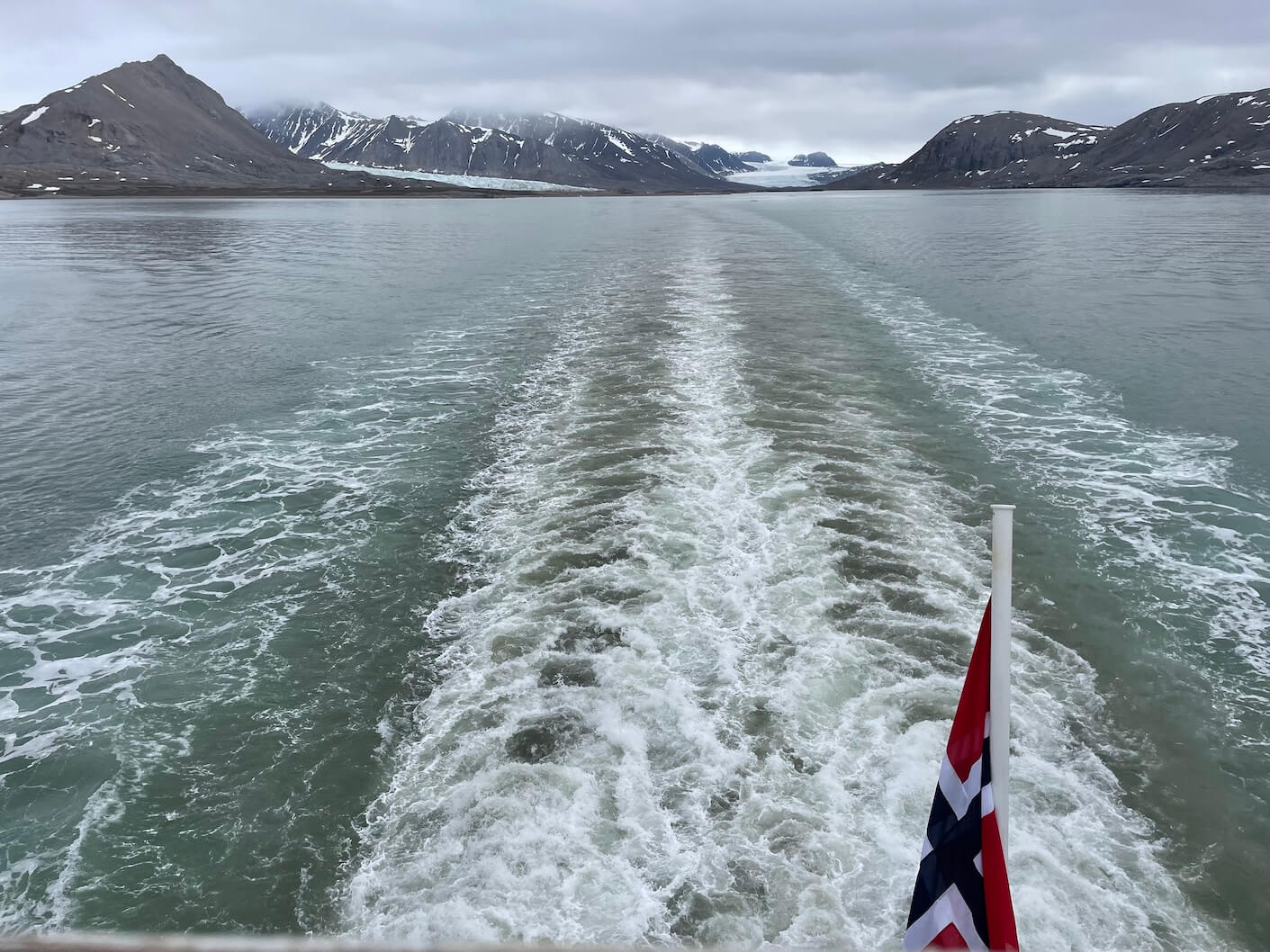
Saying goodbye to the glaciers in Kongsfjorden and setting sail south for Norway
If you travel to Svalbard in wintertime, it’s a completely different experience! Find out all about My Svalbard holiday in winter with sledges and snowmobiles.
Meanwhile, from the other end of the world…. check out my previous adventure with Hurtigruten – Swimming with penguins on a once-in-a-lifetime trip to Antarctica
Full details of Hurtigruten’s Svalbard Line voyage here
Hurtigruten Cruises sailings and destinations
Hurtigruten Expeditions cruises and destinations
Sailing the Norwegian coast with Hurtigruten’s Coastal Express
Visting Svalbard in summer – 24 hour sunshine, quad bikes and RIB cruises
Visiting Svalbard in winter – my epic trip with Northern Lights, dog sledding and exploring glaciers
